- Things to Do
- Travel & Explore
- Investigations
- Marketplace
- Advertise with Us


Video of the Day

Definition of a Travel Lane
Driving down a highway, you'll usually find there are two lanes--one traveling in each direction. On larger freeways, there may be multiple lanes and a shoulder for emergency stops. The New York State DMV Driver's Manual reports that a broken-up or solid white or yellow line divides the travel lane from the shoulder of the road. This means that the travel lane is always defined as a lane for moving traffic.
The right travel lane on a multiple-lane highway is always where slower traffic should drive. This allows people the ability to pass them if necessary to keep traffic flowing.
The far left lane is always used for passing slower-moving traffic. Most highways have a posted speed limit of how fast and slow you can drive on the road, and the passing lane is used for those who want to drive the highest speed limit allowed, or faster.
Emergency Stops
The Massachusetts DMV reports you should use lanes only as marked. This means you should never stop in the travel lane if there is a shoulder of the road available. If you have an emergency while on the road, pull as far off the road as possible.
The shoulder of a highway or freeway should not be used as a travel lane according to the DMVs across the United States. This lane, even in a heavy traffic jam, should only be used for emergency stopping or for emergency vehicles to drive past the traffic.
When driving on a highway or freeway, it is courteous to follow general driving rules of slow-moving traffic in the right travel lane. Failure to do so can lead to traffic jams and frustrated drivers who wish to drive the posted speed limit.
- Massachusetts: Lane Use And Restrictions And Special Rules For Motorcycles
- Rules of the Road
- California DMV: Driver's Handbook
- New York State DMV: Driver's Mannual Chapter 6: Passing
About the Author
Sara Hickman owns a preschool science-based entertainment business in the Greater Cincinnati area. She has a bachelor's degree in communication and psychology from the University of Wisconsin, Stevens Point.
Photo Credits
- highway image by michele goglio from Fotolia.com

Pavement Markings and What They Mean
Last updated: December 24, 2023 Pavement Markings 13

Pavement Markings and What Colors Mean
Pavement markings are typically white or yellow. Other colors exist, but white and yellow are the most common colors. You must know their meaning for your written DMV test and permit practice.
When you see white and yellow lines separate travel lanes or mark the center of the road, they tell you if traffic is traveling in one or two directions. Yellow lines separate traffic in opposite directions, and white lines separate traffic lanes moving in the same direction.

Yellow Lines
Traffic travels in opposite directions on a road with yellow lines in the center of the road. You are on a two-way roadway and must drive to the right of these lines.
If you see a single solid yellow line on the left edge, you are on a divided highway or a one-way street. The yellow line often marks the edge of the median or divider. There is usually one on each side of the divider.
The right edge of the roadway has a normal solid white line (edge line).
Remember: if the yellow line is on your right and a white line is on your left , you are going the wrong way .
A yellow (center) line must always be on your left!

Yellow Lines and No-Passing Zones
On a two-way roadway, the yellow center markings can consist of:
- A. A broken yellow line.
- B. A broken yellow line and a solid yellow line.
- C. Two solid yellow lines (a double yellow line).
A normal broken yellow line marks a two-direction passing zone. Traffic traveling in either direction may pass other vehicles carefully and when the way ahead is clear.

Where there is one solid yellow line and one broken yellow line , traffic traveling adjacent to the broken line may pass other vehicles carefully. However, traffic traveling with a solid line on their side cannot pass.

Two solid yellow lines mean that traffic from either direction cannot pass.

If you travel on an undivided two-way roadway with four or more lanes, the center of the road has a solid double yellow line. Don’t drive to the left of the center unless you must cross the lines to turn left .

Crossing Solid Yellow Lines to Pass a Bicyclist
Solid yellow lines mark no-passing zones. You may not cross these lines to pass other vehicles.
Some states make an exception for slow-moving bicycles or other obstructions in your travel lane. In Florida, for example, you may cross the lines when an obstruction exists, making driving to the left of the highway’s center necessary. When a bicyclist is traveling so slowly as to constitute an obstruction, a motorist may cross the center line in a no-passing zone if the way is clear and it is safe to do so.

Remember, the solid yellow line is there for a reason. In many situations, it may be dangerous to pass. Don’t try to pass the bicyclist with little clearance or squeeze them off the road. Stay behind the bicyclist until it is safe to pass.
Crossing Solid Yellow Lines to Turn Left
You can cross yellow lines in a no-passing zone to turn left turn into a driveway or side road.
Unless state law specifies otherwise, you can make a U-turn across a single or a double yellow line. You should make sure you know and understand the law in your state.
Two-way Center Turn Lane

A center lane with a regular broken yellow line and a solid yellow line on each side indicates a two-way left-turn lane . This lane is for traffic in either direction as part of a left-turn maneuver. The broken yellow line is inside a two-way left-turn lane, and the solid line is painted toward the adjacent traffic lane, as shown in the illustration.
You cannot use this lane as a regular travel lane or use it to pass other vehicles. You should only enter this lane when preparing for a left turn.
Users often misunderstand the arrows painted on the pavement, thinking that the lane is for both left and right turns. It isn’t.
Reversible lanes

You will see reversible lanes on highways where specific lanes are open for traffic in one direction during morning commute and in the other direction during evening commute. It improves traffic flow during peak hours and special events. Special lane-use control signals show you if you can use a reversible lane or not.
Pavement markings in a reversible lane consist of a regular broken double yellow line on each side of the lane.
You must only cross the yellow lines to a reversible lane if lane-use control signals indicate that you can use the lane for through travel in your direction or for a left turn.
White Lines
White lines separate travel lanes moving in one direction.
These pavement markings can consist of:
- A. A normal or wide dotted white line
- B. A broken white line
- C. A normal or wide solid white line – discourages crossing
- D. A normal or wide double white line – prohibits crossing

Dotted white lane lines separate a through lane from a deceleration or acceleration lane or a through lane that becomes a mandatory exit or turn lane.
A standard broken white line separates lanes where you can change lanes. Cross the lane line markings with care.
When there are regular or wide solid white lines between travel lanes, you should stay in your lane. The solid line means that crossing the line marking is discouraged. Only change lanes when it is necessary to avoid an incident.
The solid white lane line marking separates a through lane from an added mandatory turn lane at intersections. Once you have entered your lane, don’t change your mind at the last second. Respect the pavement markings.
If a double white line separates travel lanes, you must not cross the line. Do not change lanes for any reason.
Other Pavement Markings You Should Know
Sharrows : They are Shared Lane Markings . Such markings remind you that motorists and bicyclists can use the traffic land. Note the difference between a designated bicycle lane and a shared roadway (sharrow).

HOV lanes : These lanes are reserved for specific vehicles and marked with a white diamond symbol. Signs beside the lane will indicate what vehicles can use the lane.

Stop or limit lines : Such lines are white and painted across the travel lane at intersections and indicate where you must stop your vehicle when required by a sign or signal. You must stop before entering a crosswalk or the intersection if there is no stop line.

Summary: Everything You Need to Know in This Video!
This video summarizes everything you need to know about road markings for your State’s DMV test.

Check Your Knowledge – Quick Test
#1. road lines that separate traffic going in different directions are:.
Yellow lines mark the center of a road used for two-way traffic. Broken yellow lines indicate that passing is permitted. Solid yellow lines indicate no passing.
#2. What does a white diamond symbol on the pavement usually mark?
Lanes marked with a diamond symbol are known as carpool or high-occupancy vehicle (HOV) lanes. The white diamond symbol may also be used together with a bicycle symbol to mark bike lanes.
#3. When is a double white line used between traffic lanes?
A double white line is two solid white lines that indicate a lane barrier. They tell you that crossing the lines to change lane is prohibited.
#4. If you have a solid yellow line on your right and a white line on your left:
If you find yourself on a roadway with yellow to your right and white to your left, you are going the wrong way. Remember, yellow is used to divide opposing roadway traffic and can indicate the left travel edge of a divided roadway.
Yellow line markings should never be on your right side; always on your left side.
#5. If you turn into a road at night and see road reflectors shine red, the reflectors tell you that:
Red markings or reflectors indicate a roadway that must not be entered. If you are going the wrong way at night, the road reflectors will shine red in your headlights.
#6. Broken double yellow lines on each side of a lane indicates:
Reversible lanes are lanes that are open for traffic in one direction during morning commute and in the other direction during evening commute.
#7. What do sharrows mark?
Sharrows are shared lane markings. They remind you that a traffic lane can be used by both motorists and bicyclists.
#8. What color are road lines that separate traffic going in the same direction?
White lines mark traffic lanes going in the same direction.
#9. A two-way left turn lane is marked on both sides with:
A two-way left turn lane is found in the middle of a two-way street. It is marked on both sides by two yellow lines. The inner line is broken and the outer line is solid.
#10. What do two solid yellow lines on a two-lane road indicate?
Solid yellow lines mark a no passing zone. When a solid yellow line is on your side of the road you must never cross the line to pass other vehicles. Pass only if there is a broken yellow line on your side of the center.
Average rating 4.7 / 5. Vote count: 19
No votes so far! Be the first to rate this.
Why is it important to stop behind stop lines?
MUTCD Pavement and Curb Markings
10 Common Questions about Road Markings

What are Sharrows and How Should They be Used?

Risky Study Tactics that Could Cause You to Fail

Learn about Fuel-efficient Driving

What does the Basic Speed Law Mean?
More interactive practice tests.
Lane-control , Markings , Road lines , White lines , Yellow lines
13 Comments
It is Amazing
Two pairs of yellow lines, with a broken line inside and a solid line outside, indicate a ________ .
A. center left turn lane
B. loading zone
C. median island
D. reversible lane
Recently the acceleration/deceleration lane striping was changed to a series of short broken lines. Why was it changed and what is the anticipated driver usage? Since the new striping went in place most drivers are now traveling the full length of the acceleration lane without accelerating before merging instead of accelerating and merging when up to speed.
I suppose that “a series of short broken lines” means the normal dotted white line that separates speed change lanes and travel lanes. The dotted white lane is national standard for entrance ramps and exit ramps, described in the MUTCD and above. If this standard wasn’t used before, it probably explains why markings changed on this particular highway.
It sounds strange that “most drivers are now traveling the full length of the acceleration lane without accelerating”. The way you use speed change lanes hasn’t changed. Or maybe I am missing something here?
I am turning left onto a three lane road from a signal light with two turning lanes,while turning a broken white line is set so the right most turning lane has to turn to the right most lane of the three lane highway. This leaves the left turning lane with 2 lanes to choose from. My question is who has the right of way to the middle lane of the three lane highway?
The simple answer: noone. (State laws don’t give anyone the “right-of-way”)
What the broken line means: A white dotted extension line between lanes is there to guide vehicles through the intersection. Even if you should stay in your lane and exit in the same lane, the dotted line is less restrictive than a solid extension line.
Depending on state, there may be additional rules to consider.
Are these lines considered law or just a strong suggestion?
In short, yes they are “laws”.
To begin with, they are standards as described in the Manual on Uniform Traffic Control Devices. The MUTCD is adopted by reference in accordance with Title 23, United States Code, Section 109(d) and Title 23, Code of Federal Regulations, Part 655.603, and is approved as the national standard for designing, applying, and planning traffic control devices.
States have adopted these standards and state laws define what is legal and what is not. Minor MUTCD amendments exist in some states as well as different wordings of the actual law.
What about a black broken line sandwiched by two broken white lines
I suppose you mean the black paint that is sometimes used in lane striping to help the white lines to stand out. Even if it is used locally in many states, there are no national recommendations and the “black lines” are not mentioned in the Manual on Uniform Traffic Control Devices. At least not yet.
Thank you so much for ur prompt reply and the link. I do appreciate it for making time. It was so helpful. Regards,
Leave a comment Cancel reply
Your email address will not be published.
Copyright © 2007-2024 - All Rights Reserved
Home | Contact | Terms and Conditions | Free Tests | Privacy Policy
This website is not affiliated with any State or Government Entity
Curious about the benefits available to AARP members? Watch this two-minute video to learn more.
Popular Searches
AARP daily Crossword Puzzle
Hotels with AARP discounts
Life Insurance
AARP Dental Insurance Plans
Suggested Links
AARP MEMBERSHIP — $12 FOR YOUR FIRST YEAR WHEN YOU SIGN UP FOR AUTOMATIC RENEWAL
Get instant access to members-only products and hundreds of discounts, a free second membership, and a subscription to AARP the Magazine.
- right_container
Work & Jobs
Social Security
AARP en Español
- Membership & Benefits
- AARP Rewards
- AARP Rewards %{points}%
Conditions & Treatments
Drugs & Supplements
Health Care & Coverage
Health Benefits

Staying Fit
Your Personalized Guide to Fitness

AARP Hearing Center
Ways To Improve Your Hearing

Brain Health Resources
Tools and Explainers on Brain Health

A Retreat For Those Struggling
Scams & Fraud
Personal Finance
Money Benefits

View and Report Scams in Your Area

AARP Foundation Tax-Aide
Free Tax Preparation Assistance

AARP Money Map
Get Your Finances Back on Track

How to Protect What You Collect
Small Business
Age Discrimination

Flexible Work
Freelance Jobs You Can Do From Home

AARP Skills Builder
Online Courses to Boost Your Career

31 Great Ways to Boost Your Career

ON-DEMAND WEBINARS
Tips to Enhance Your Job Search

Get More out of Your Benefits

When to Start Taking Social Security

10 Top Social Security FAQs

Social Security Benefits Calculator

Medicare Made Easy
Original vs. Medicare Advantage

Enrollment Guide
Step-by-Step Tool for First-Timers

Prescription Drugs
9 Biggest Changes Under New Rx Law

Medicare FAQs
Quick Answers to Your Top Questions
Care at Home
Financial & Legal
Life Balance

LONG-TERM CARE
Understanding Basics of LTC Insurance

State Guides
Assistance and Services in Your Area

Prepare to Care Guides
How to Develop a Caregiving Plan

End of Life
How to Cope With Grief, Loss
Recently Played
Word & Trivia
Atari® & Retro
Members Only
Staying Sharp
Mobile Apps
More About Games

Right Again! Trivia

Right Again! Trivia – Sports

Atari® Video Games

Throwback Thursday Crossword
Travel Tips
Vacation Ideas
Destinations
Travel Benefits

Beach vacation ideas
Vacations for Sun and Fun

Plan Ahead for Tourist Taxes

AARP City Guide
Discover Seattle

25 Ways to Save on Your Vacation
Entertainment & Style
Family & Relationships
Personal Tech
Home & Living
Celebrities
Beauty & Style

TV for Grownups
Best Reality TV Shows for Grownups

Robert De Niro Reflects on His Life

Looking Back
50 World Changers Turning 50

Sex & Dating
Spice Up Your Love Life

Navigate All Kinds of Connections

Life & Home
Couple Creates Their Forever Home

Store Medical Records on Your Phone?

Maximize the Life of Your Phone Battery

Virtual Community Center
Join Free Tech Help Events

Create a Hygge Haven

Soups to Comfort Your Soul

Your Ultimate Guide to Mulching
Driver Safety
Maintenance & Safety
Trends & Technology

AARP Smart Guide
How to Keep Your Car Running

We Need To Talk
Assess Your Loved One's Driving Skills

AARP Smart Driver Course

Building Resilience in Difficult Times

Tips for Finding Your Calm

Weight Loss After 50 Challenge

Cautionary Tales of Today's Biggest Scams

7 Top Podcasts for Armchair Travelers

Jean Chatzky: ‘Closing the Savings Gap’

Quick Digest of Today's Top News

AARP Top Tips for Navigating Life

Get Moving With Our Workout Series
You are now leaving AARP.org and going to a website that is not operated by AARP. A different privacy policy and terms of service will apply.
Pavement Markings Are Key to Safety but Can Be Confusing
Changes in rules of the road explained.

James R. Healey,
Pavement markings are all around, and it's easy to drive as we presume they intend us to while going about our motorized ways.
But those lines on the pavement aren't always as simple as they seem.

AARP Membership — $12 for your first year when you sign up for Automatic Renewal
For example, you might remember being taught that a yellow line in your lane means not only don't pass but also don't cross it at all. How confusing, then, to see on a main road a wide center area marked with fat turn arrows so you can get out of the flow of traffic and into the turn lane to make a left into parking lots for offices and shopping centers.
To do that, though, you must cross a yellow line.
"I would be confused,” says John Townsend, spokesman for AAA, the motorists organization formerly called the American Automobile Association. Townsend wrestled the Code of Virginia over the matter and won, finding a section that allows you to violate the yellow line “when turning left for the purpose of entering or leaving a public, private or commercial road or entrance.
Even if it's a double yellow, it's OK to cross when turning left or when you must slide over to avoid hitting a pedestrian or person-powered vehicle such as a bicycle or skateboard, the Virginia Code says.
Townsend recalls driver education classes insisting it was wrong to cross over a yellow line, period. A lot of us probably were taught that. Or think we were.
"It's important to know the rules of the road,” which might differ from what you thought you were taught as a new driver, he says.
"We only take the driver's test, and that's the last time we look at the rules. One result: You could get a ticket and go to court and it's a wrongful ticket” that you could avoid, he says.
Each state has its own traffic codes, and towns and cities sometimes further refine those. So be sure you know the rules of your particular road.
Before you get flummoxed by yellow lines and turn lanes, here are some basics that should be universal:
• White lane markings are the most common. Solid white lines define lanes of traffic going in the same direction, or they show you the location of the shoulder of the road. Broken or “dotted” white lines are used to show the center line between lanes.
• Yellow lines show you where traffic is going in different directions. Stay on your side of the yellow line and you'll avoid nasty head-on collisions with folks coming the opposite way.
With such a dire consequence for ignoring the yellow line, you can see why it might be common to think you never, ever should cross it. From our Virginia example, you see that it's sometimes permitted to cross a yellow line.
Think of people who live along narrow, winding roads chockablock with yellow lines down the center to minimize dangerous passing. How would residents ever turn left into their own driveways if crossing a yellow line weren't permitted sometimes?
AARP Auto Buying Program Powered by TrueCar
Shop for a car with safety features you want. buyers can get a free aarp smart driver course..
Please Select Make
Please Enter ZIP Code
ARTICLE CONTINUES AFTER ADVERTISEMENT
Illustrations can make that, and other markings, easier to understand.
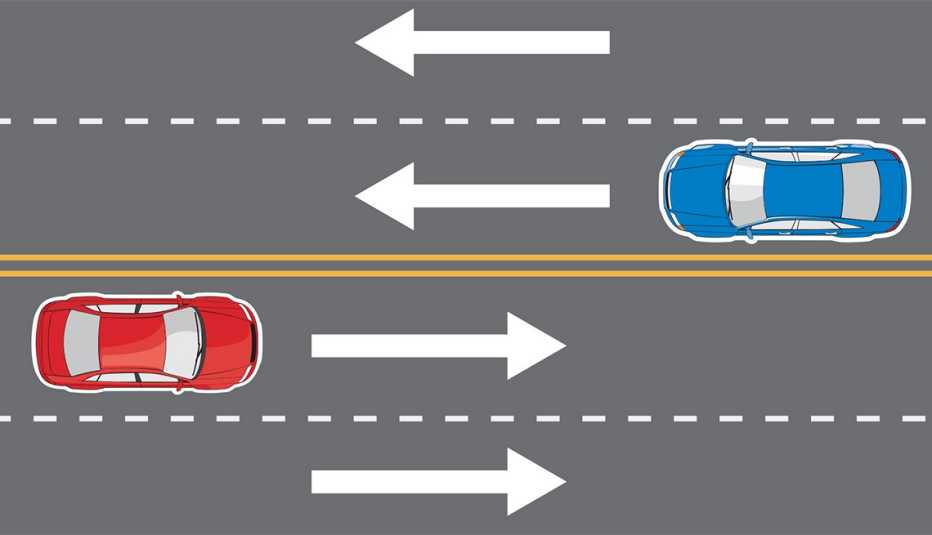
Multilane, two-direction roads
AARP® Auto Insurance Program from The Hartford
$577 average member savings
Stay on your own side of the double yellow line that's down the center of the road. If you need to pass another vehicle, do so using lanes on your own side of the yellow.
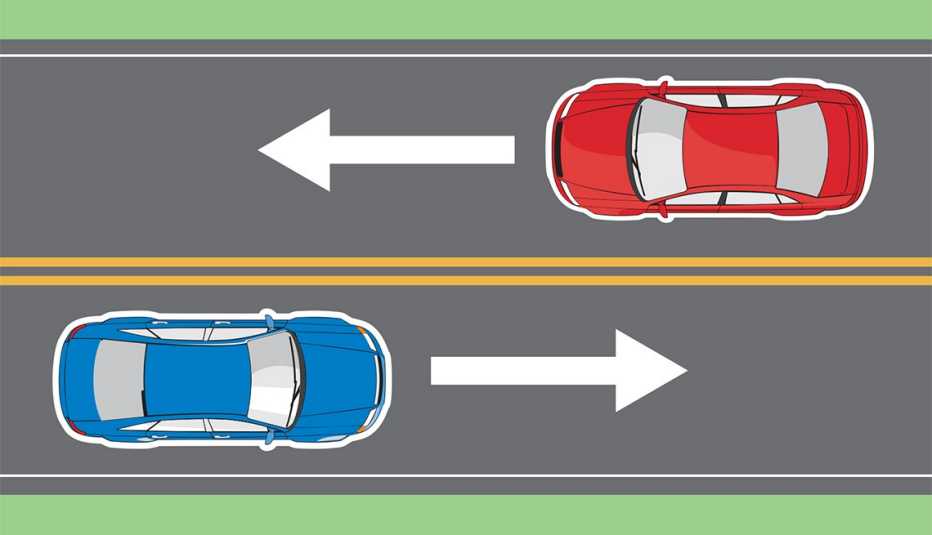
Two-lane, two-direction, no-passing roads
These are where you reach into your “patience” pocket and trot out as much as you have. You can't legally pass somebody because that would take you across the double yellow line into oncoming traffic.
Even if it were legal, it wouldn't be very smart.
But remember, you can cross that double yellow line if you're making a left turn, assuming that's permitted on the street where you're driving . As Townsend said, know your specific location's rules of the road.
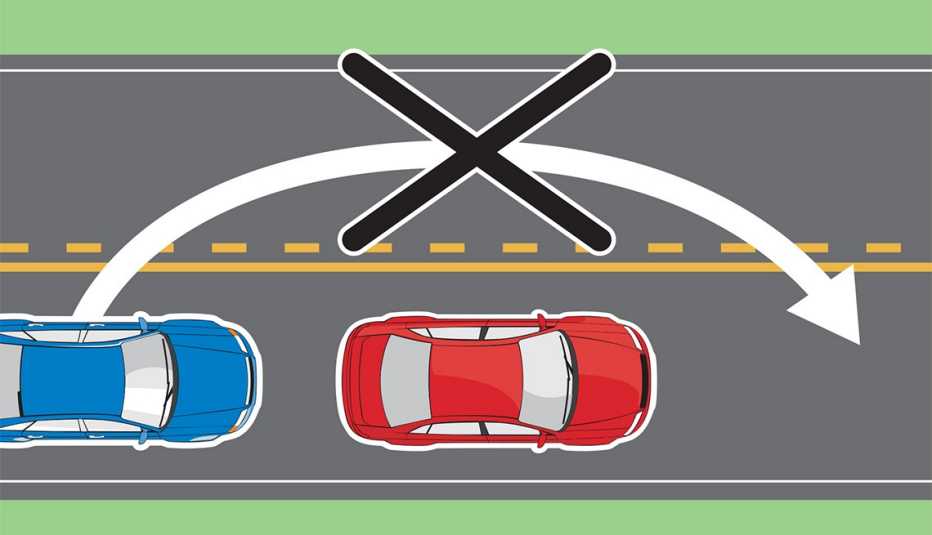
Two-lane, two-direction roads with some passing
When the solid yellow line is on your side of the road, you can’t cross it to pass. On the other side, you can if it’s safe to do so.
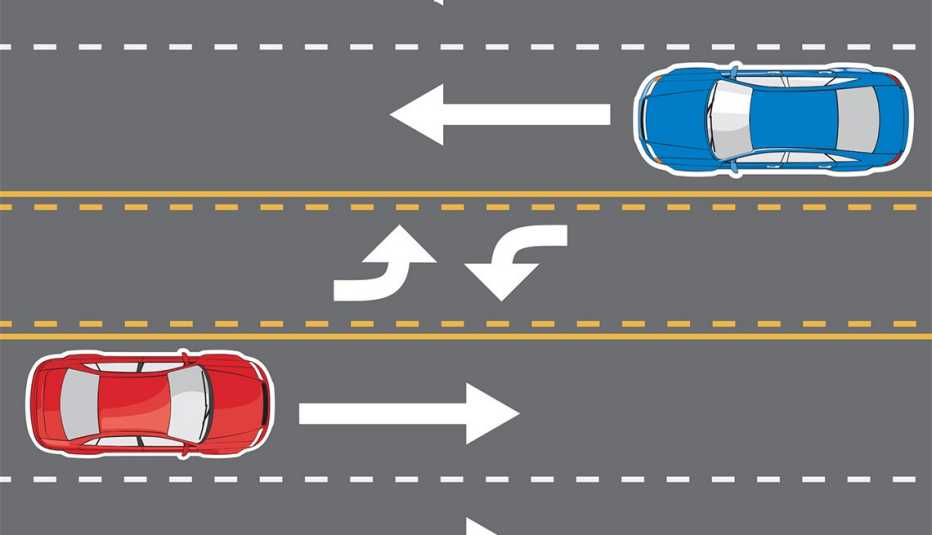
Two-direction roads with a center turn lane
You can cross a solid yellow line on your side of the road to get into the center left-turn lane. But keep your eyes on traffic coming the other direction because those cars also have the right to use the same turn lane.
This layout gives you permission to move out of moving traffic and into the turn lane to make the turn when it is safe to do so.
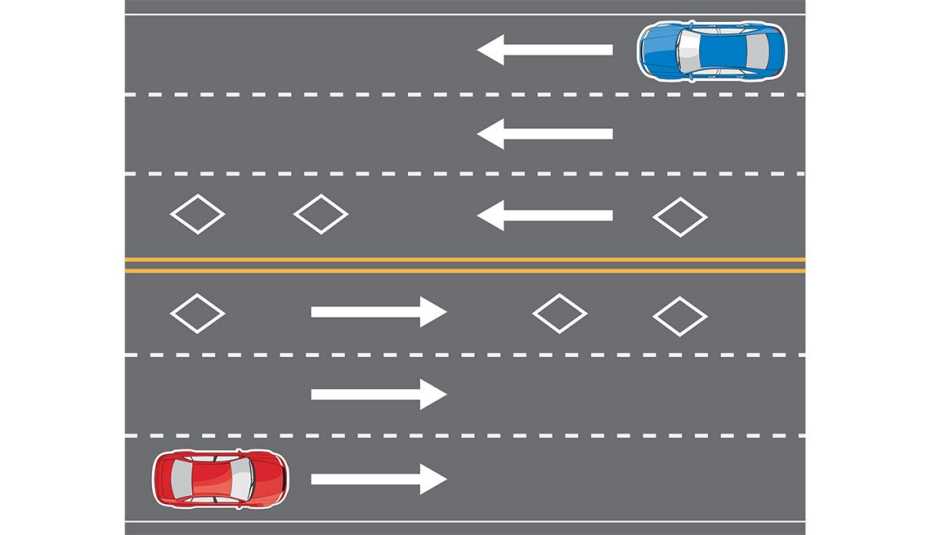
Restricted lanes
Multilane two-way roads sometimes have lanes stenciled with diamond shapes on the pavement. That usually means those lanes are for high-occupancy vehicles (HOV), sometimes called car pool vehicles.
Roadside signs should help you decipher how and when you can use those lanes. Sometimes the restricted lanes are open to all traffic outside of certain hours.

Reversible lanes
These lanes are set aside to speed traffic in one direction or another at certain times of the day — in the morning, say, as commuters are heading into the city for work and in the afternoon to let people get out of town faster.

Join AARP today for $16 per year. Get instant access to members-only products and hundreds of discounts, a free second membership, and a subscription to AARP The Magazine.
Sometimes shoulders of the road are open for traffic during the reversible-lane hours. Other times a center lane is the reversible one, the entrances blocked with gates or barricades to keep wrong-way traffic off the lanes.
Signs and sometimes overhead lights help you know when it's acceptable to use the reversible lane. It's critical to know your area's specific regulations about reversible lanes because you don't want to be caught trying to go out on the inbound lane or vice versa.
Freelance writer James R. Healey was auto writer and columnist for USA TODAY.
MORE FROM AARP
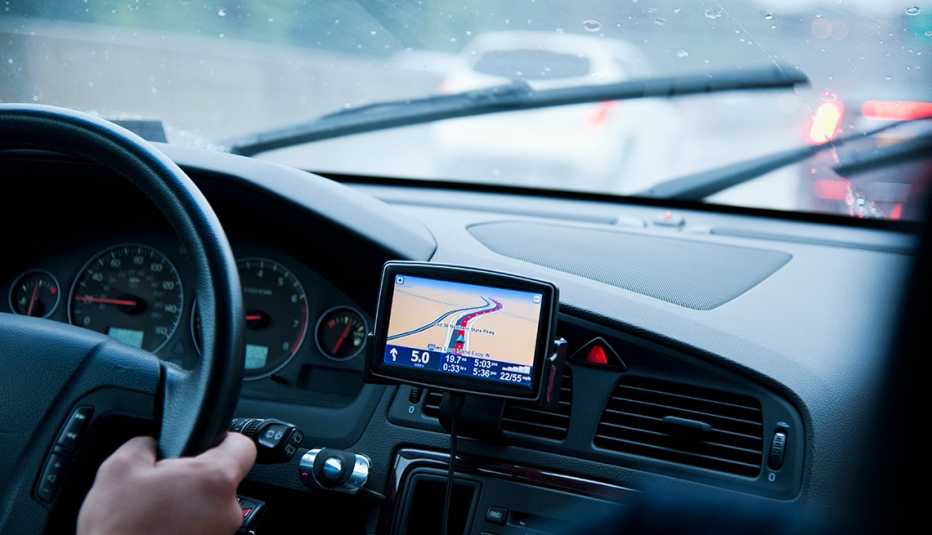
Don’t skip out on traditional safe driving practices
High-tech devices in your vehicle can make driving easier, but they can also be dangerous

How to Adjust Car Mirrors to Prevent Blind Spots
High-tech cameras help, but drivers should also rely on their eyes

7 Best Practices for Driving on Wet, Rainy Roads
Use these driving techniques and focus on preparation to stay safe
Discover AARP Members Only Access
Already a Member? Login

AARP NEWSLETTERS

%{ newsLetterPromoText }%
%{ description }%
Privacy Policy
AARP VALUE &
MEMBER BENEFITS

Valvoline Instant Oil Change
15% off drive-thru, stay-in-your-car oil changes

Auntie Anne’s
10% off in-store, in-app and online orders

AARP Auto Buying Program powered by TrueCar
Find a car with the safety features you want and get upfront pricing information

AARP® Staying Sharp®
Activities, recipes, challenges and more with full access to AARP Staying Sharp®
SAVE MONEY WITH THESE LIMITED-TIME OFFERS
Travel Line In Palmistry
Everything about Travel Line In Palmistry!
Meaning Of Travel Line In Palmistry
Palmistry or Palm reading has been a part of Vedic Science since ancient times of astrology. It indicates that hand parts can reveal much about a person's real nature and potential future acts. Hands, fingers, finger shapes, everything has to say a story. Isn't knowing personal insights just by showing your hand to an expert fascinating? In today's world, where everything is so fast-paced, being prepared for things that can happen ahead is only going to make you better. An interesting concept in palmistry that helps us in this area is reading lines. Lines on your palm reveal information related to different factors of life and are connected to each of the five fingers. Let’s discuss the travel line in Palmistry.
Travel teaches you something every time you visit a place. That's why it is essential to keep exploring new places whenever you get time. Taking a break from your daily life and spending time rejuvenating your mind and body is what travelling does to a person. Also, there are academic and professional opportunities that take us to travel to a different city or an entirely different country. But do you know that there is a travel line on your palm that can reveal your future travel possibilities? If you don't already know, read about Travel line in Palmistry here and get to know what it has to offer to the world of travel curiosities.
A travel line starts from the base of your palm and sometimes extends to the Middle finger of your hand. On some hands, it also passes through the lifeline or nearly visits it. This line is also called the 'journey line' or the 'line of adventure'. It indicates an individual's travel interests and how much one wishes to explore in order to receive new learnings and gain new experiences. Sometimes it is also called 'foreign settlement line in hand', for it reveals the possibilities of settling down in a foreign country. Want to know more? You must read ahead. Also, do you want to know what your travel line says for your next probable trip? Then, consult with our experts today at InstaAstr
Significance Of Travel Line
The Travel line holds a lot of significance in terms of travelling. Not only it provides information on your future travel destinations, but it also has a lot to say about your ability to take risks. It can indicate how far you can go to meet your travel needs and aspirations. Moreover, it brings your personality traits into use in all your future travel experiences. This means that it can foretell what attitude or behaviour you will probably display when you encounter a travel opportunity. This travel opportunity can either be for work or academic purposes or for your own personal interest to visit a place or city in your country or in a foreign land.
Travel lines on palm have a connection to your life journey as a whole. It not only informs about your physical travel but also what circumstances you are expected to face while moving to a new place or going back and forth to your home. Some palm readers have also put light on the amount of confidence you are likely or not likely to display when there is a need to travel. Hence, it hints at your overall personality when exposed to a situation where you have to travel.
Moreover, the Travel line in palm, as mentioned earlier, is an important concept for foreign settlement prediction by palmistry. Came to be known as foreign travel palmistry, it also helps students and professionals with the probability of residing abroad. Therefore, students applying to foreign universities must consult respective palmists to know about their settlement in an entirely different country and associated experiences, especially when they are in their first year of living there.
Also, professionals going to and fro to foreign cities or may have an onsite or are going to settle down in a foreign land as a permanent resident must look out for all the insights one can gather. It is necessary to have travel insights, especially when you are moving out of your home country. This is where your comfort zones are put to the test. But no worries, the foreign line in palm prepares you for the best.
There are several insights attached to a foreign line in hand or a travel line. The longer the travel line, the longer your chances to travel. If there is no travel line, it will be very rare that you will travel. Moreover, it's a sign of good luck if your travel line or foreign line in hand is not crossed by any other line or is uninterrupted. It means you'll get to travel a lot, and it will mostly be a memorable and fun experience.
We also get a lot of understanding through its encounters with the lifeline. They are listed below:
- If you have clean travel lines and the lifeline, but they extend to the Luna Mount (a section to the left of the lifeline), the foreign line in female hand indicates that they are likely to get married in a foreign country. However, these females would not enjoy a good relationship with their in-laws. While the males can get settled in rarely visited cities abroad.
- If there is an intersection between the travel line and the lifeline, beware of accidents, as they can also mean untimely deaths, that too, in an unknown area.
- If you see many tiny foreign line in hand just beside the lifeline, you are likely to be habituated to alcohol or may get inclined towards intoxication in future.
- Foreign line in palmistry also suggests that if your travel line touches the lifeline and then deviates towards the Luna Mount crossing the Neptune Mount, then you are someone who loves travelling and may also become a professional in this field.
Fate Line Palmistry ➤
Heart Line Palmistry ➤
Children Line Palmistry ➤
Head Line Palmistry ➤
Life Line Palmistry ➤
Marriage Line Palmistry ➤
Simian Line Palmistry ➤
Sun Line Palmistry ➤
Type Of Hand Palmistry ➤
Types Of Fingers Palmistry ➤
Types Of Nails Palmistry ➤
Bracelet Line Palmistry ➤
Types Of Travel Lines
The travel line on the palm can provide palm readers or associated astrologers with valuable information about the individual's future travel prospects and personality. For more clarity, this travel line is divided into the following types based on the shape, length, and position of the travel line.
Straight Lines:
A straight and clear travel line suggests smooth and trouble-free travel. Individuals with straight travel lines are said to have been born with immense love for travel and adventure. Therefore, they are naturally fond of travelling. It is likely that they may be drawn to places that are far away or unknown. If you ever meet them, you will find that such individuals are highly passionate about exploring and learning about new cultures and varied ways of life.
They love knowing people who live differently than usual. This can even be a stranded village in the mountains where you don't usually go. Moreover, they love trying the local cuisines of a place.
Wavy Lines:
A wavy travel line indicates that an individual is very adventurous and makes spontaneous plans. These individuals do not fear taking risks and, therefore, may experience major ups and downs during their travels. They may be drawn to visiting strange or unexplored destinations or just enjoy exploring new places without any major plan set in mind. They take impulsive decisions when it comes to travel. Individuals with a wavy travel line suggest that they have a carefree attitude towards life.
They do not make plans or roadmaps when they have to travel. When they have a city in mind, they will just book tickets and maybe rent a car or a bike and just ride off to the place without much thought if it's not too far. And to visit a far-off destination or, let's say, a foreign country, they know how to accumulate money and manage finances.
Forked Lines:
A forked travel line on the palm indicates the decision-making power of the individuals between two different paths or destinations. In a group tour, these are the people who usually choose the best route to travel for a trip. They research and look for all the possible routes to come to a decision. Moreover, people mostly rely on them for travel suggestions.
The two branches of the forked line also hint at the two different travel opportunities or two different paths presented to them. This type of travel line suggests that the individuals' present preferences with respect to travel affect their future travel certainties or uncertainties.
Chained Lines:
A chained travel line may indicate obstacles or difficulties that the individual may encounter during their travels. However, these challenges can be overcome with determination and perseverance. The number of links in the chain may indicate the severity of the obstacles the individual will face. The chained travel line suggests that the individual may need to work hard to achieve their travel goals and may face some setbacks along the way. Chained lines create confusion and lack of concentration and thus, it is also known as the conflicting line between emotions and love
Absent Lines:
If there is no travel line on an individual's palm, it does not necessarily mean that they will not travel. Other lines and markings on the palm can provide insight into the individual's potential for travel. For example, if an individual has a strong fate line or lifeline, it may indicate that they will have a successful career that will allow them to travel extensively.
However, the absence of a travel line may suggest that the individual may not have a strong desire to travel or may prefer to stay close to home. Moreover, if there is no foreign travel line in female hand, it can suggest that either they may work hard to reach a foreign destination or stay at home and be unmarried forever.
Islanded Lines:
An islanded travel line is a broken line that appears in the shape of an island or an uneven area enclosed by a boundary along the length of the line. This type of travel line suggests that the individual may experience interruptions or delays in their travels. Their plans of travelling may likely get cancelled due to one or more circumstances, and that too, back to back.
However, these obstacles may not be permanent and are short-lived. If the individual performs good deeds or karma, they may be able to overcome them to continue their travels. They have the struggle to face when it comes to travel, but not giving up and fighting them off can only give them results.
Short Lines & Long Lines:
If the travel line or lines on your palm is short, you are likely to have fewer opportunities to go or plan a trip. But everybody has to travel according to their needs, and so will they.
A long travel line on the palm indicates that a person is highly fond of travelling and would always find opportunities to plan trips one after the other. They may hunt for every possible travel plan available next door. Moreover, individuals possessing long travel lines are inclined towards careers revolving around the travel domain, such as travel writer, research scientist, overseas business and vloggers. This type of travel line suggests that the individual may have a passport with several stamps indicating a lot of foreign journeys or trips. However, they will have a hard time completing their travel journey or often won't be able to even start their planned ones due to obstructions laid in front of them
Remedies For Travel Line's Bad Implications
If your travel line shows bad implications or indicates misfortunes, there are certain remedies that people can adopt to improve their probable experiences. Let us look at the remedies below:
- Pay Reverence to Lord Hanuman:
In Indian mythology, Lord Hanuman is believed to be a protector and a safety provider. Hence, before travelling, people can have a small ritual in the morning where they worship Lord Hanuman. Individuals with a negative travel line are advised to offer prayers to Lord Hanuman before starting off any journeys. Reciting Hanuman Chalisa or other associated mantras and lighting a lamp in front of his idol with offerings of fruit, milk, and rice can bring immense positive results and may help you overcome the negative implications of your travel line.
- Wear a Travel Locket:
Another remedy for a negative travel line is wearing a travel talisman, amulet, or locket. Under the right guidance of a pandit or priest, a gemstone suitable to our zodiac can be worn. It is believed to offer protection and good fortune during trips or travel experiences.
- Perform Shanti Puja:
People with an inauspicious travel line can conduct remedial puja or Shanti Puja. It is a Hindu prayer ritual that is performed to eliminate negative vibes and calm down malefic planets. If an individual's travel line indicates unlucky circumstances, he/she may look over for the placement of planets in their horoscope with the help of an astrologer who would then suggest Shanti Puja remove the Dosha of that particular planet.
- Do Charitable acts:
You probably face chaos and hardships in your life because you are all not checking up on your karma. Doing good deeds, helping the needy, donating food and clothes to the poor, offering Prasada to temples are some of the humanitarian acts that work like remedies and help one improve their fate with respect to travel lines.
To conclude, we can say that the Travel line or foreign lines on your palm gives a lot of information about your personality traits when you are a traveller. It also reveals how likely you are going to travel in your life span or in the near future. It helps students who wish to pursue education abroad as well as professionals who prefer to move to a different country for work. You must take the help of travel line palmistry when you are to take trips with family and friends. Also, to know everything about your future possibilities like love, career, marriage, travel and more, we at InstaAstro provide a platform who have experts or the best astrologers to guide you.

Worried about your marriage?
Frequently asked questions, what does the travel line on my palm represent, which planet is responsible for foreign travel, can the length of my travel line determine the distance of my travels, is it necessary to have a travel line on my palm, can the travel line change over time, which palm line shows abroad, choose your zodiac sign.

Mar 21 -Apr 19

Apr 20 - May 20

May 21 - Jun 21

Jun 22 - Jul 22

Jul 23 - Aug 22

Aug 23 - Sept 22

Sept 23 - Oct 23

Oct 24 - Nov 22

Sagittarius
Nov 23 - Dec 21

Dec 22 - Jan 19

Jan 20 - Feb 18

Feb 19 - Mar 20
Have Question about Marriage, Career or Relationship?
Talk to India’s best Astrologers
First Consultation at ₹1 only
Talk to India's best Astrologers
Enter your mobile number
By signing up, I agree to the Privacy Policy , Terms and Conditions .
Enter 6 digit OTP sent to your phone Edit
Trouble receiving code?
Share Birth Detail
Horoscope 2022.
- Love Horoscope 2022
- Health Horoscope 2022
- Career Horoscope 2022
- Finance Horoscope 2022
- Education Horoscope 2022
- Chinese Horoscope 2022
- Lal Kitab Horoscope 2022
- Numerology Horoscope 2022
- Tarot Reading Horoscope 2022
- Festivals 2022
- Planetary Transit 2022
Horoscope 2024
- Tarot Reading Horoscope 2024
- Love Horoscope 2024
- Health Horoscope 2024
- Career Horoscope 2024
- Finance Horoscope 2024
- Education Horoscope 2024
- Chinese Horoscope 2024
- Numerology Horoscope 2024
- Today Horoscope
- Tomorrow's Horoscope
- Yesterday's Horoscope
- Weekly Horoscope
- Monthly Horoscope
- Yearly Horoscope
- Shubh Muhurat 2024
- Marriage Muhurat 2022
- Annaprashan Muhurat 2022
- Griha Pravesh Muhurat 2022
- Namkaran Muhurat 2022
- Mundan Muhurat 2022
- Marriage Muhurat 2024
- Annaprashan Muhurat 2024
- Griha Pravesh Muhurat 2024
- Namkaran Muhurat 2024
- Mundan Muhurat 2024
Important Links
- Solar Eclipse 2024 New
- Lunar Eclipse 2024 New
- Indian Calendar 2024 New
- Vedic Astrology
- Chinese Astrology
- Muhurat Astrology
- Relationship
- Spiriual-World
- Gemstone for all 12 Zodiac Signs
- Astrological Remedies
- Vastu Shastra
- Planetary Transit 2024
- Planets In Astrology
- Talk with Astrologer
- Live Astrologers
- Daily Horoscope
- How To Read Kundli
- Match Making
- Marriage Biodata
- Astrology Houses
- Zodiac Compatibility
- Color Therapy
- Web Stories
- Arti Sangrah
- Daily Quotes
- Zodiac Signs
- Mole In Astrology
Useful Links
- Customer Support
- Privacy Policy
- Terms & Conditions
- Astrologer Registration
Phone: +91- 6366-937-227
Email: [email protected]

Private & Confidential

Verified Astrologers

Secure Payments
Download our app.

Karishma Tanna believes in InstaAstro

Urmila Matondkar Trusts InstaAstro

Chat Request Sent
will revert in
Wait time -
Initiate Chat
Astrologer is not available
Astrologer is not available right now. Please select another Astrologer
You didn't accept the chat
Leave Waitlist?
Are you sure you want to leave the waitlist for ?
Your queue limit has been reached.
chat has been ended due to low balance
Are you sure want to end this chat?
Chat ended by . Please review your session
Review and Ratings
Please take a moment and give us your valuable feedback regarding your last session. Your feedback will help us to improve
Thank you!!
Your review has been submitted.
You will be connecting with Astro Gaurav in 0:48:14
Astrologer Maaltokrish is offline, your chat will start when they come back online.
Currently queue feature is available on App Only!
Download Now

Currently this feature is available on App Only!

Fun Channel
Palmistry, dreams and more, travel lines in palmistry, foreign travel, and settlement signs.
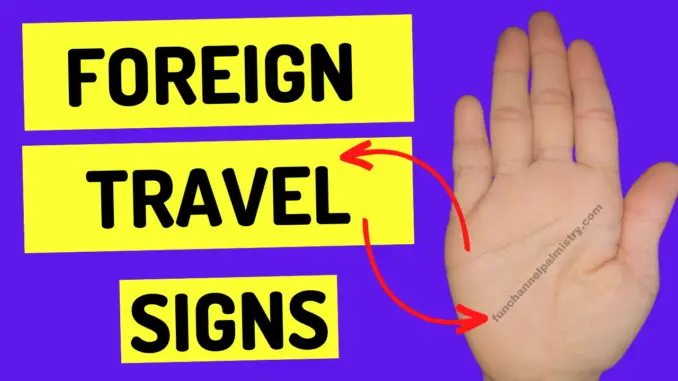
Travel lines on mount of moon
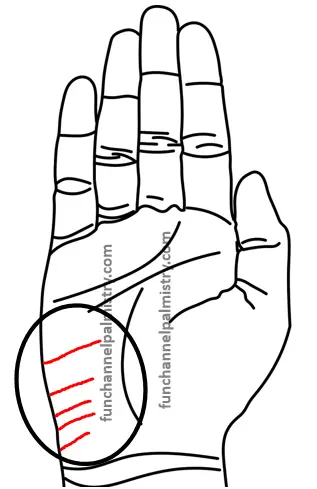
Travel lines in palmistry are typically referred to as the horizontal lines found on the edge of the mount of the moon as shown. The mount of the moon is synonymous with restlessness, oceans, locomotion, change of place, and a subconscious mind.
Hence the name, “lines of travel in palmistry”.
It is not that black and white to gauge travel from the hands simply glancing at these lines. One needs to have a thorough understanding of the texture of the skin, hand type , and structure of the hand to truly differentiate between travel lines on palm, lines of restlessness, and horizontal health defects lines linked with the moon mount.
Tricky? Indeed, it is. Palm reading is an art. Not everyone gets it. Even artificial intelligence (AI) won’t be able to master it except beyond providing a rudimentary, universally applicable, nonsensical reading.
Travel lines palm reading
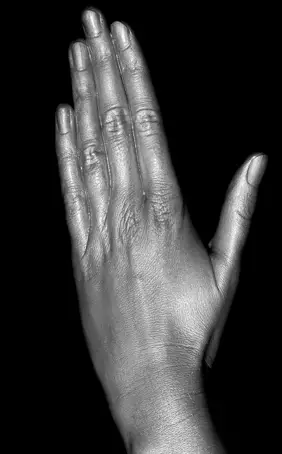
For instance, a person with a silky texture of the skin, a narrow hand that is wet or sweaty, and deflated Venus mount will mentally explore the globe. Such a person seldom makes physical travel and health problems are likely to result.
Astral travel lines on palm

People who practice esoteric arts and assert to have engaged in astral projection have had their palms read by me. The soul departs the physical body during astral projection and travels anywhere the person desires.
The Mount of the moon was developed with pink dots on it, a distinct headline dropping towards the Luna mount and pointed fingers all pointed towards remarkable spiritual energy and ability to connect to different wavelengths. Her assertions can’t be refuted.
On a medium texture skin along with other favorable markings, it suggests the person will physically travel far and wide.
Foreign lines in palmistry
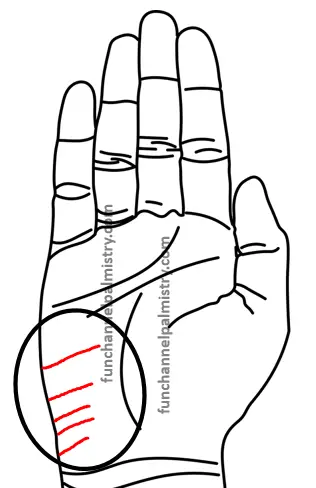
The so-called travel lines on the mount of moon denote yearning for a change of location. Its positive effect intensifies if there is a need and proper effort attached to it.
A business tycoon, for instance, more than often does not have such travel lines on his hands. He can just hop in his private jet for a business meeting. Traveling is an integral part of his life. On the other hand, a talented student who aspires to enter an international university for the betterment of his life and profession, in general, will possess foreign lines on his palms.
One thing is for certain, these lines do not exhibit signs of permanent foreign settlement by any chance.
Travel lines age timings

It is also not reliable to time travel lines on hands. Of course, in one or two cases you can time it accurately by a fluke. However, if you increase the sample size to thousands of palms, you will soon realize how inaccurate it can get.
I cannot emphasize this enough, no palm reader on this planet can tell which countries or continents you will travel to by looking at your hands.
Let’s see some permanent relocation signs in palmistry and foreign travel lines on the hand.
No travel lines on palms
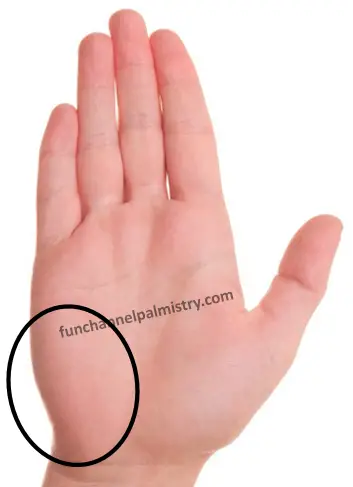
No travel lines on the palms do not imply that he or she will undertake few journeys or don’t travel at all.
As stated earlier, travel lines enumerate a genuine need for travel or a change of destiny due to some change of place.
An individual with enough resources and money at one’s disposal can travel to any corner of the world. Foreign travel lines seldom surface on such hands unless that locomotion is of paramount importance or there is a danger associated with a particular traveling endeavor as opposed to a person who is living in an oppressive government regimen with orthodox thinking and frequently desires to make a transition to improve his life.
Honestly, I came across some weird selfish individuals while reading palms whose covert goal was to seek a green card through marriage and a well-marked travel line was present.
Read More: Billionaire Lines on your hands, CLICK HERE
Travel line in palmistry on female hand.

There is not much difference between travel lines on a female’s hand and a man’s hand.
If a foreign line on a female’s hand appears all of a sudden suggests she might migrate to another country in order to be with her spouse or pursue her studies.
Travel line joins fate line

If a clear travel line joins the fate line represents the person will experience a journey or a trip that will alter his destiny or career path forever.
Don’t confuse this line with a line of intensity .
Abroad line in palmistry
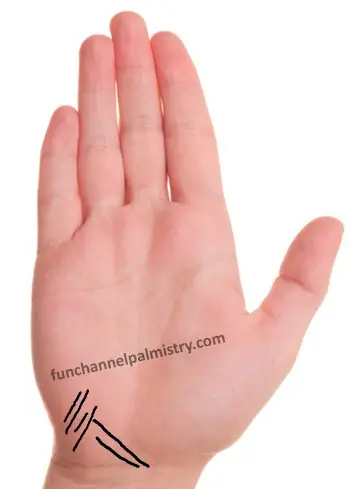
Diagonal lines on the mount of moon pointing towards the fingers are considered to be the lines for foreign travel.
He or she is likely to travel around the world and has a deep understanding of foreign cultures or languages.
Similarly, a line from the bracelet to mount of moon also indicates long trips or abroad travels.
Which hand lines show foreign travel?

If a line from the bracelet goes to the mount of Jupiter suggests an individual will garner a huge fan following in his spiritual quest or religious voyage.
If a flawless line from the bracelet goes to the Saturn mount, he or she will achieve an extraordinary career.
Likewise, if a line from the bracelet goes to the Sun mount as shown, the person will get famous and rich while exploring another foreign land.
A line from the bracelet to the mercury mount denotes sudden financial windfall in a business, export-import business, or networking with elite people while traveling.
Lifeline going towards mount of moon

A lifeline going towards mount of moon is a certain sign of extensive travel and the likelihood of foreign settlement.
Luck will shine in another foreign land and the subject’s career will benefit immensely from a land far away from one’s birth land.
Fate line breaks and continues
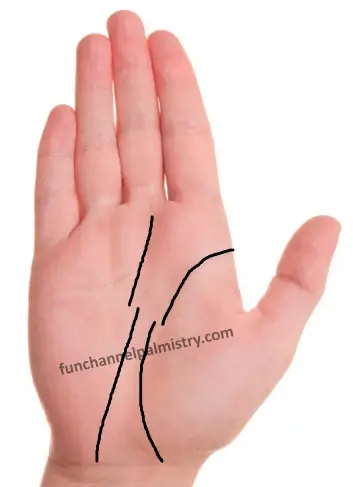
If the lifeline breaks and starts again creating a wide Venus mount; at the exact timeframe the fate line breaks and continues indicates a strong probability of a permanent foreign settlement, destiny will attract life-changing opportunities and a new environment that will make him or her blossom like never before.
To accurately time the events, check this article.
Long travel line palmistry

If the lifeline splits into two branches and one of the branches goes deep into the territory of Moon mount is of significant importance.
It denotes the person will undertake long journeys to explore the world, an experience that will bring positive changes in the personality and he or she can pursue a career that requires vivid imagination which needs to be cross-referenced with other characteristics on both hands.
Read More: Early success signs in palmistry, CLICK HERE
Forked travel line.
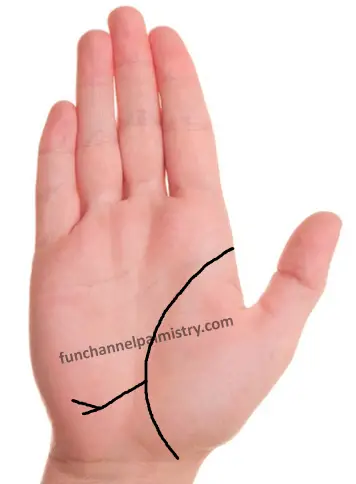
A forked travel line ending on the mount of the Moon is not a fortunate sign.
I have witnessed many times, although a person travels to another foreign land he or she encounters constant hardships beyond one’s circumstances.
Horizontal lines on mount of moon
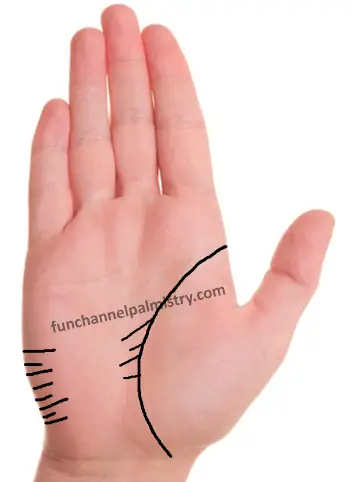
Short lines on the side of the hand, clear downward lines from the lifeline pointing towards the prominent Luna mount and good texture of the skin represents short trips within the country or abroad.
I have seen such a combination on the hands of digital nomads, wanderlust people, and restless individuals.
Inexperienced readers can confuse these lines with the lines of disappointments .
The number of lines does not equate to the number of travels.
Fish sign on travel line

Fish sign not touching the travel line as shown signify the subject will migrate to another country and will make a fortune out of international travels.
A line from upper mars to sun mount
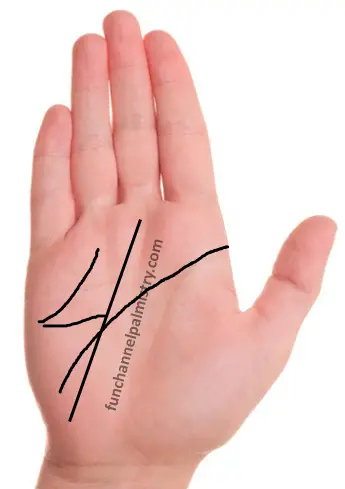
If there is a presence of a line from upper mars to sun mount also known as Purva Punya Rekha in Hindu palmistry, a clear fate line originates from the mount of moon, a line from the fate line to the upper mars and the headline sloping towards the developed moon mount denotes the subject will travel abroad for work purposes for an extended period of time, or get a foreign spouse from a different culture.
Moon and mercury conjunction

Lunarians are restless creatures and have a natural urge to travel. Mercurians are active, very energetic, fast, family-oriented, and frequently travel across the planet for business.
If both these mounts are prominent with no negative signs on it in itself is a powerful combination for beneficial foreign travel with or without travel lines.
Square on the travel line

Square on the travel line protects the person from unscrupulous elements in his journey and ensures safe travel in general.
Cross at the end of the travel line

Cross at the end of the travel line or on the travel line denotes the person will face sorrows in his voyage.
Read More: Cross sign on your palms, CLICK HERE
The travel line goes upwards.
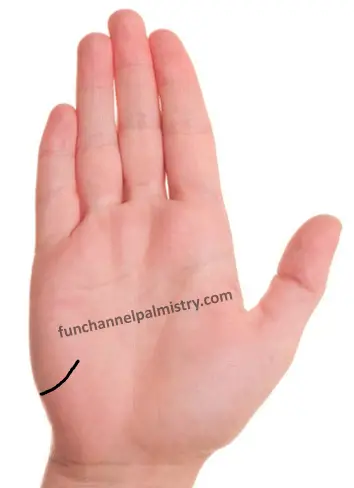
If the travel line goes upwards suggests successful journeys.
Travel line moves downwards

Likewise, when the travel line moves downwards denotes futile trips in a person’s life.
Two travel lines cutting each other

Two travel lines cutting each other creates the appearance of a cross. It implies that the subject will probably make several fruitless attempts to complete his work.
Read More: Money Triangle and its meaning, CLICK HERE
Break on the travel line.

A break on the travel line denotes something just comes up at the wrong time and causes a significant delay in the travel plans.
Island on the travel line
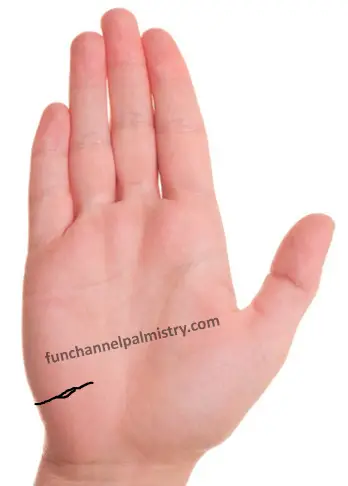
An island on the travel line suggests diseases associated with the moon mount, big shipment loss, financial loss during the trip, or danger from the ocean. Anything is a possibility.
A triangle on the travel line

A triangle on the travel line denotes the subject will earn immense wealth, wisdom, and unexpected positive experience in one’s chosen journey.
Star on the travel line

A star on the travel line signifies a fatal injury or accident during the journey.
If you want a palm reading or ask a specific question, CLICK HERE
- foreign settlement signs
- Foreign travel lines
- Travel lines
Be the first to comment
Leave a reply cancel reply.
Your email address will not be published.
Save my name, email, and website in this browser for the next time I comment.
All Rights Reserved ©2024 Fun Channel
Know about your future and personality, Click here

Pavement Markings Explained: What the Different Markings and Lines Actually Mean
Pavement markings such as solid yellow lines and painted symbols are used to divide lanes, as well as indicate when it’s legal to pass, safe for changing lanes , turn , and when you have to stop.
We’ll go through these different types of road markings and their meanings today.
- White Lines
- Yellow Lines
- Reversible Lanes
White Road Lines
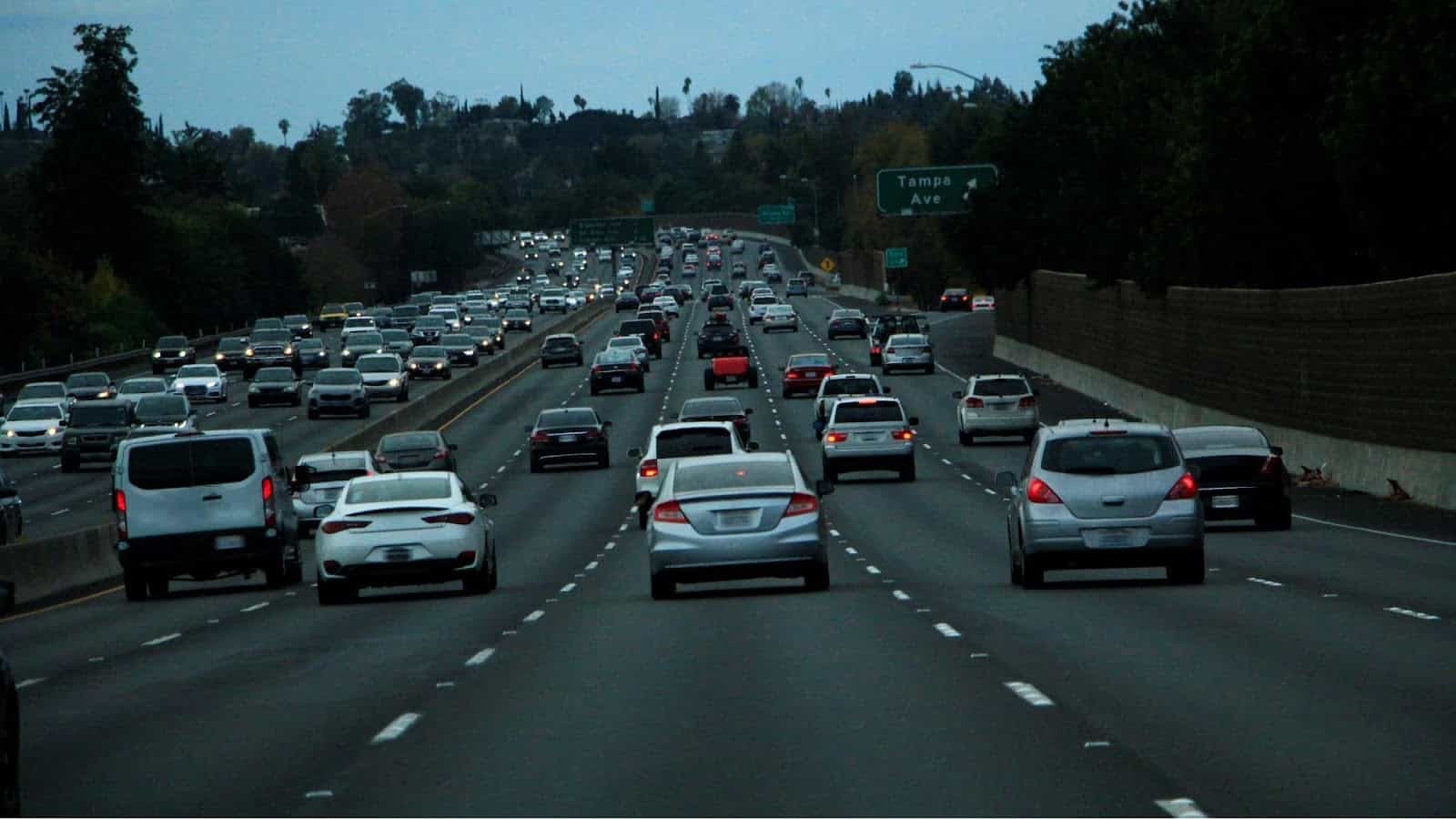
White lines separate traffic traveling in the same direction . There are three types of white lines- single broken, single solid, and double solid.
Single Broken White Lines

You may cross single broken white lines to change lanes when safe.
Single Solid White Lines

You must not cross single solid white lines unless to avoid a hazard. Many drivers fail to obey this at traffic light intersections, which creates a dangerous situation for everyone.
Double Solid White Lines

You must not cross double solid white lines for any reason as they indicate a barrier.
Yellow Road Lines
Yellow lines separate traffic traveling in opposite directions .
Broken Yellow Line

You may, if safe, cross broken yellow lines to pass a vehicle in front. Make sure that the road ahead is clear before passing.
Solid Yellow Line
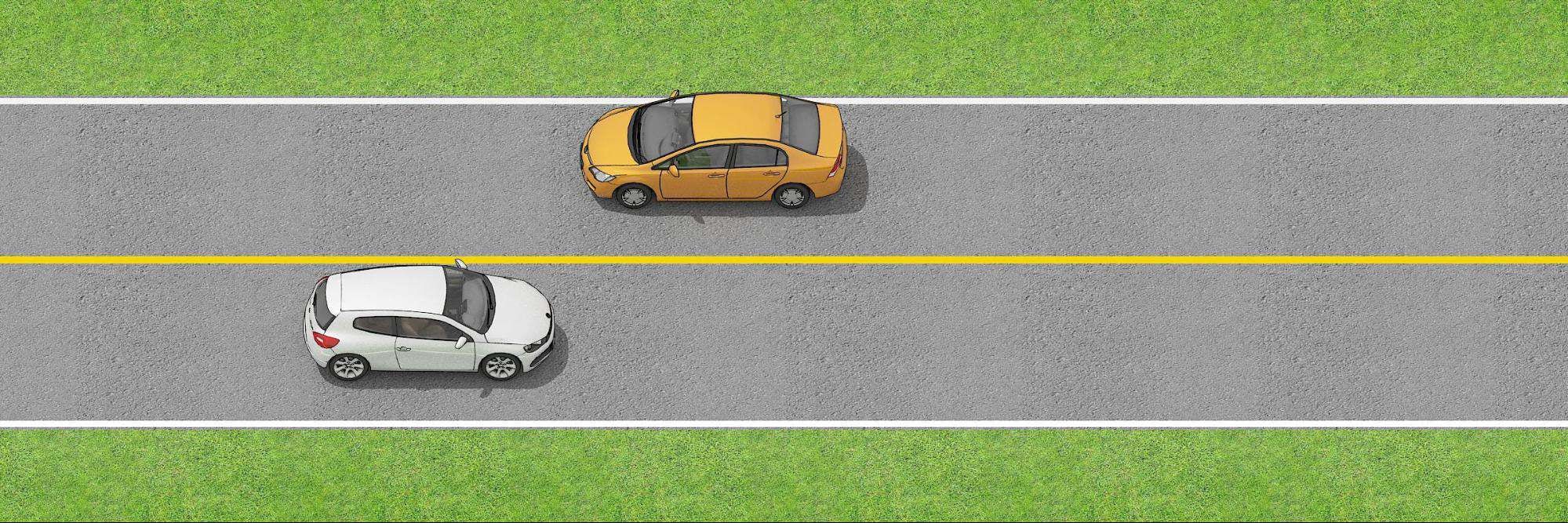
A solid yellow line indicates that passing is prohibited. Don’t cross a solid yellow line to pass another vehicle.
A Solid Yellow Line Alongside a Broken Yellow Line

Depending on which side you are on, you may or may not be allowed to pass
- If you are traveling on the right of the broken yellow line, you are allowed to cross the lines to pass vehicles, if safe.
- If you are traveling on the side of the solid yellow line, you must not pass
Double Solid Yellow Lines

Double solid yellow lines indicate no passing from either lane . Don’t drive to the left of double solid yellow lines except if:
- Turning left to enter/leave a road
- Your lane is blocked or closed and signs indicate you must drive on the other side of the lines
- Traveling in an HOV lane with a designated entrance to the left of the lines
There may be additional exceptions depending on where you live.
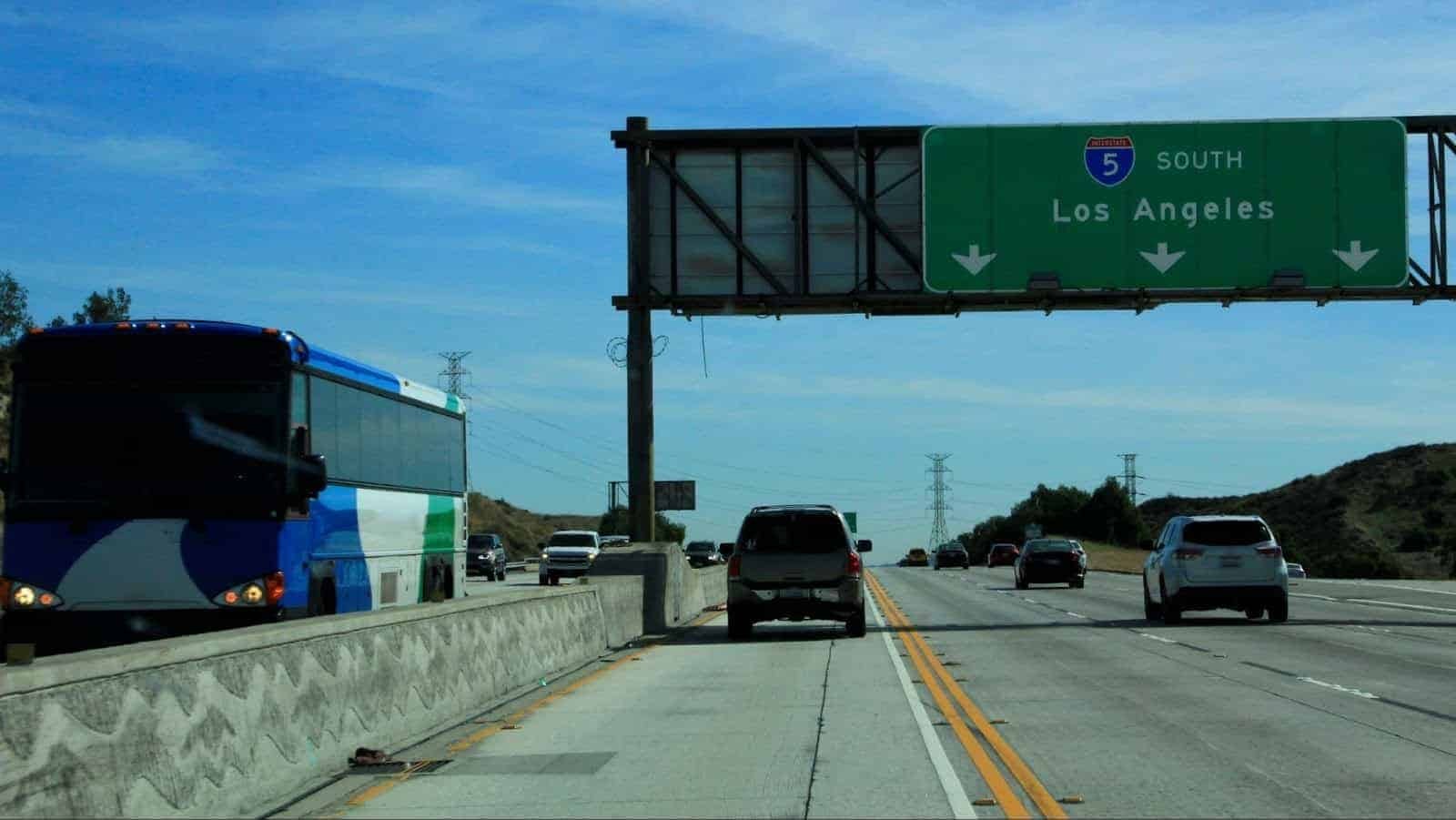
What are Edge Lines?
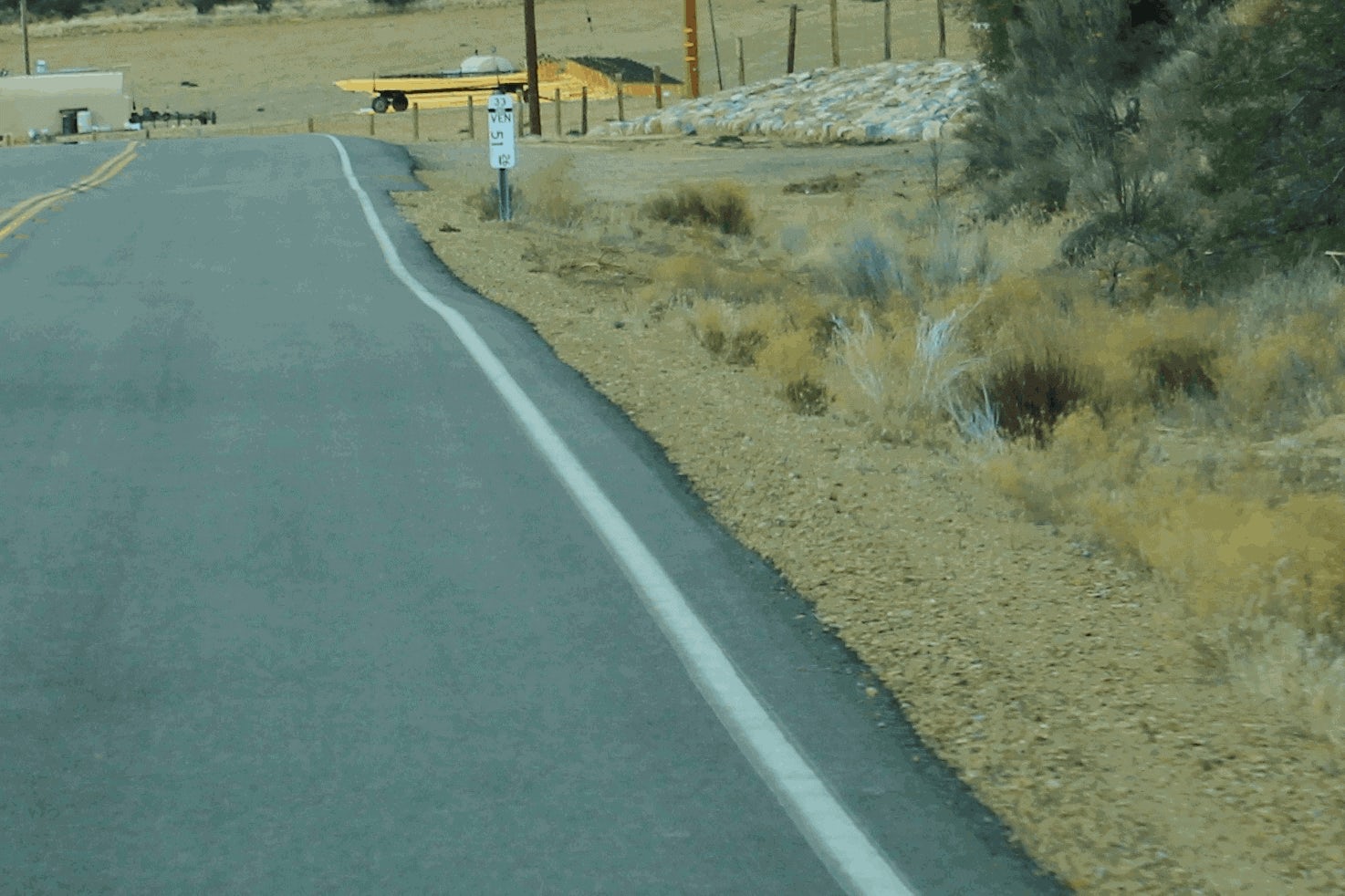
Edge lines are solid pavement lines along the side of the road. They indicate where the lane ends and where the road shoulder begins. There are two types of edge lines:
- A solid white edge line – indicates the right edge of the pavement
- A solid yellow edge line – indicates the left edge of the pavement on divided highways and one-way streets
What are Pavement Arrows?
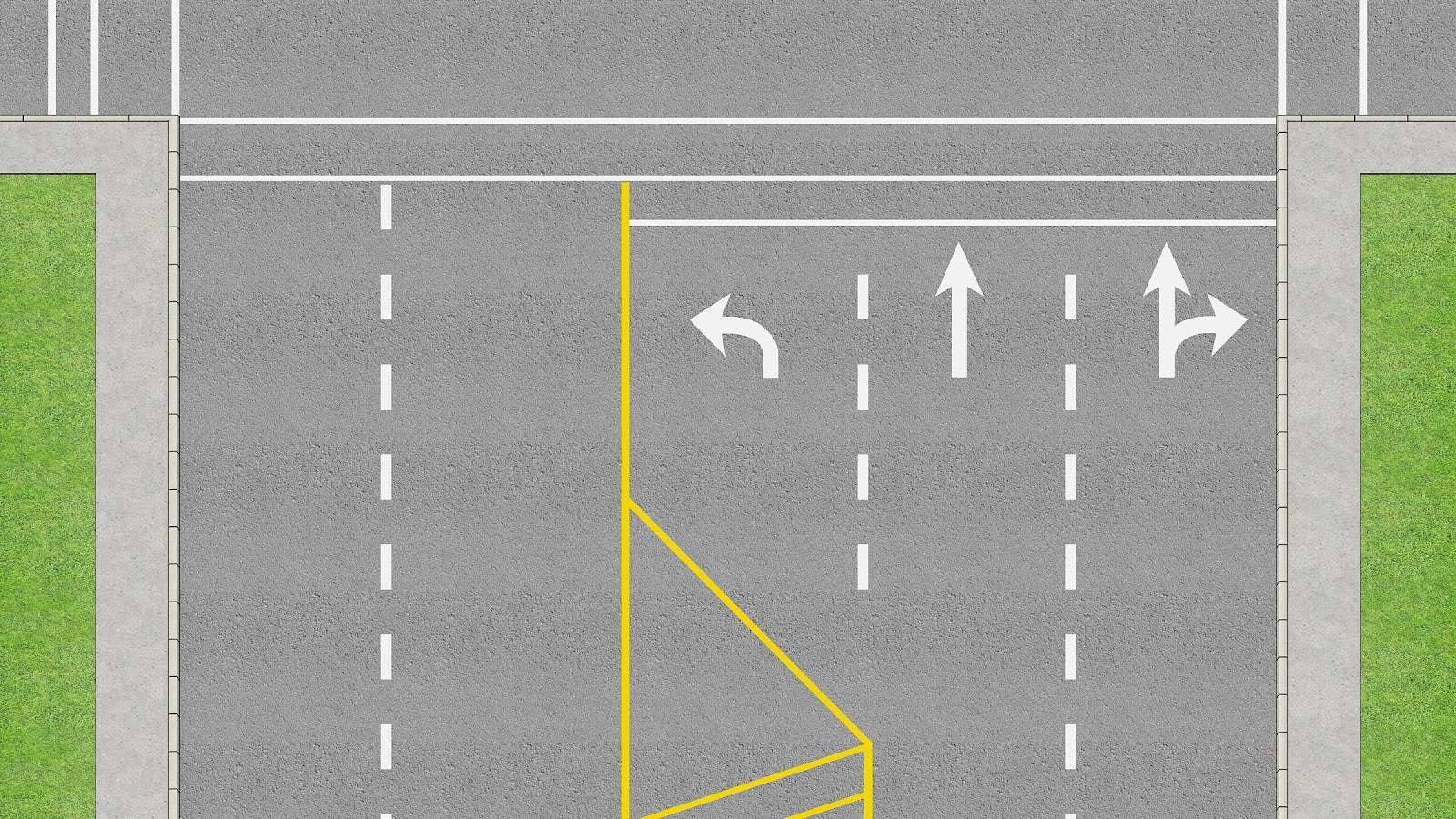
If marked arrows exist, you must only drive in the direction indicated by the arrows.
Arrows may have more than one direction:
- one direction – only drive in the designated direction
- two directions – you may drive in either direction
Place yourself in the correct lane well in advance of an arrow so you don’t have to make last-minute lane changes.
What are Reversible Lanes?
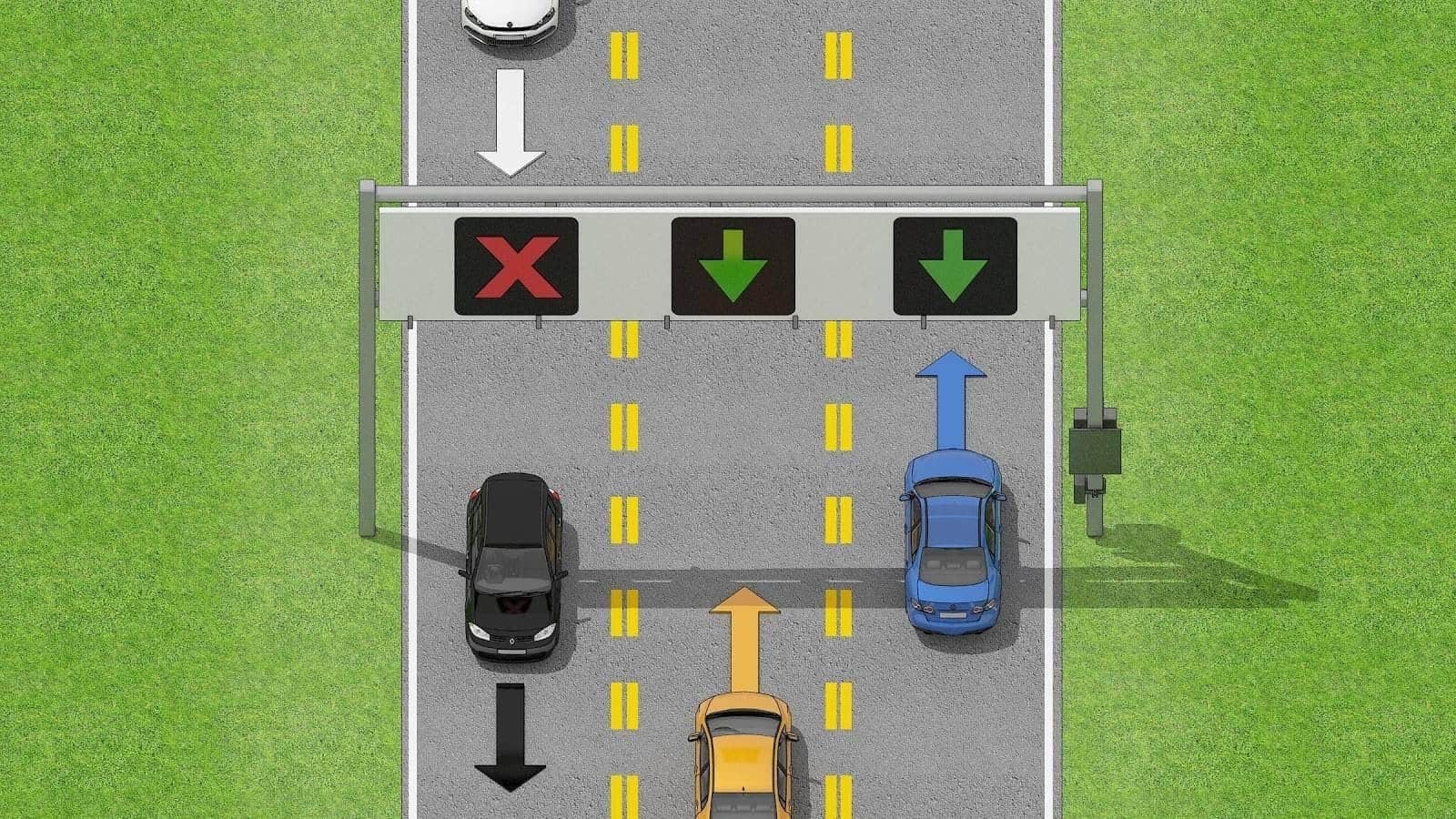
Reversible traffic lanes exist on some highways to improve traffic flow during rush hours. Reversible lanes are marked by traffic signs, pavement markings, and lane signals.
Generally, a reversible lane will be open in one direction during the morning commute, and in the other direction in the afternoon.
Diamond Symbols / HOV Lanes

Diamond symbols are used to indicate special purpose lanes, such as lanes reserved for High Occupancy Vehicles (HOV). Unless you comply with the requirements of the HOV lane, you must not drive in a lane with diamond pavement symbols.
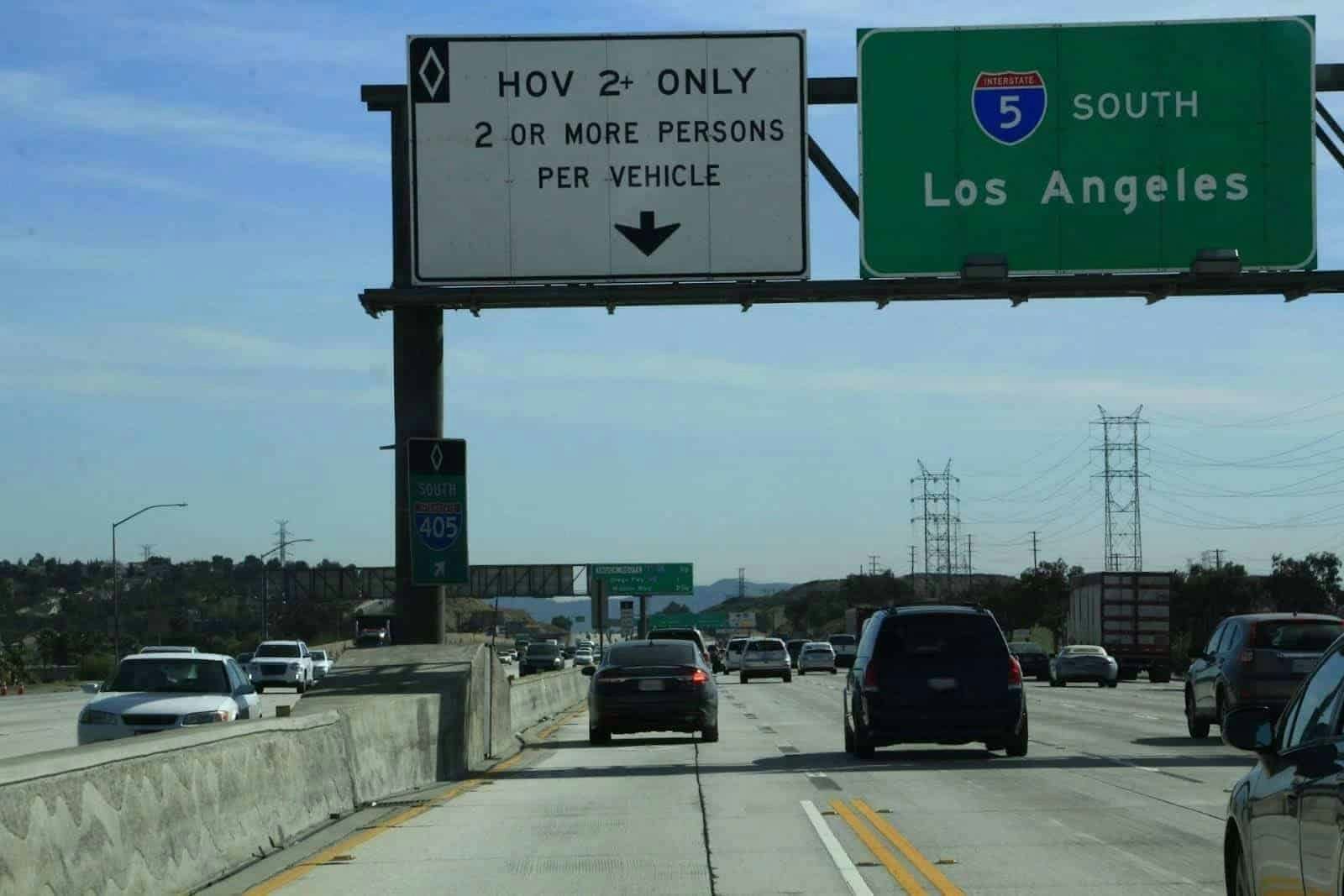
HOV lanes are restricted traffic lanes where only vehicles with a certain number of occupants (usually 2 or more) are allowed to use. Some vehicles like buses, motorcycles, and low-emission vehicles are exceptions to the rule and can use the HOV lanes at any time.
There may also be restrictions at certain times of the day and day of the week. Some states allow eligible energy-efficient vehicles to drive any time of the day bypassing the HOV lane restrictions. Follow the HOV lane rules ! Enter and exit only at designated points.

550+ exam-like questions
All you need to ace your test
Perfect for first-timers, renewals and senior citizens
Recommended articles

Traffic Safety is Crucial to Your Business
By kristin pettway, drive smart virginia april is distracted driving awareness month and the perfect opportunity for workplaces to review their traffic safety policies and communications. traffic crashes are the leading cause of workplace deaths in america. even if you don’t have a fleet of vehicles, safe driving should still matter to your business. after […].
Cost Effective Cars
The cheapest and most expensive cars to run in the us there are so many different costs to factor in when you buy a new car. from the price of gas, to insurance and vehicle tax rates in your area. in a landscape where consumer prices fluctuate, particularly in areas like vehicle parts, used car […].

Driving Career Index
A driver’s license opens up numerous job opportunities. but which jobs offer the biggest growth potential with minimal training in this report, zutobi drivers ed analyzed average salary, job availability, employment change rates, and education requirements to identify the top career options for individuals with driver’s licenses. top jobs with the biggest growth opportunities first […].
Ace your DMV test, guaranteed
Get started
Best of the Zutobi blog
- Learner’s Permit Ultimate Guide
- Driving Test Ultimate Guide
- Traffic Lights Guide
- How to Pass the DMV Permit Test
- How to Pass the Driving Test
- Common Reasons For Failing the Road Test
- International Driver’s Permit Guide
- Driver’s License Renewal
- How to Get Your US Driver’s License
- How to Prepare for Your Road Test
- How to Get a Driver’s Permit
- Behind-The-Wheel training
- Terms & conditions
- Privacy policy
- Do Not Sell My Personal Information
- Subscription terms
- Terms & policies
Practice Tests
- Car Practice Tests
- CDL Practice Tests
- Motorcycle Practice Tests
- Palmistry Consultation
- English Articles
- Hindi Articles
- Testimonial 2023
- Privacy Policy

Interpretation Of Travel Lines With Figures | Travel Line In Palmistry
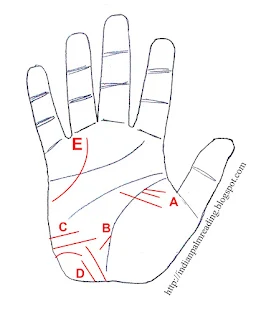
ONLINE PALM READING SERVICE
Online palmistry service.

- Your Gender: Male/Female
- Your Age:
- Your Location:
- Your Questions:
- Also you can tell me that in which field you want to make your career. So that I can check for particular field is good or not for you.
- India: Rs. 600/-
- Outside Of India: 20 USD
- India: Rs. 1100/-
- Outside Of India: 35 USD
- UTR/Reference number of transaction.
- Screenshot of payment.
- Receipt/slip photo of payment.
- PayPal (PayPal ID : [email protected]) ( Please select "goods or services" instead of "personal" )
- Western Union : Contact me for details.
- Indian client needs to pay me in my SBI Bank via netbanking or direct cash deposit or Paytm.
- SBI Bank: (State Bank of India)
Useful Links
- Palm Reading
Hand Lines in Palmistry
Palm lines reading.
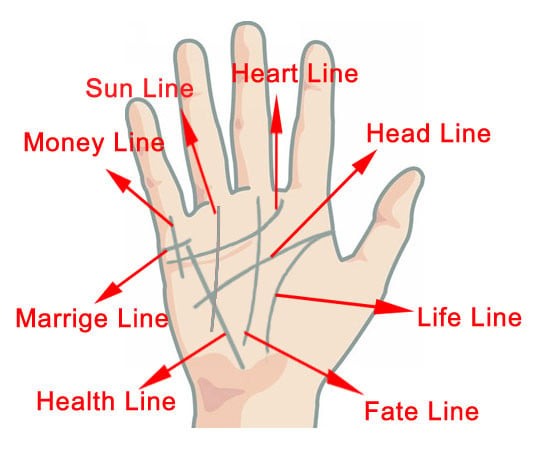
Three Major Hand Lines
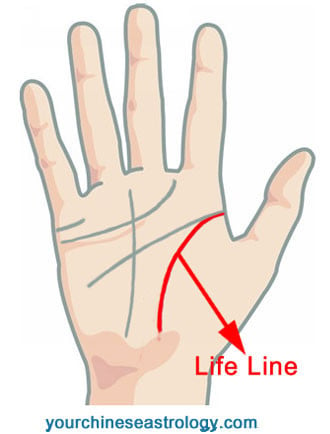
Minor Lines of the Palm
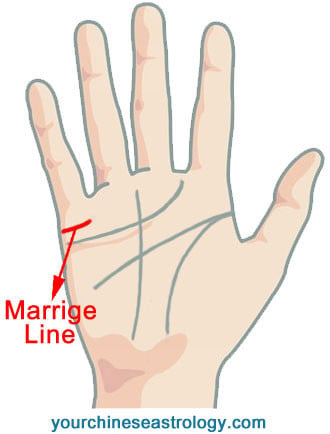
More Lines to Read

People Also Read
Lastest questions and answers.
I have a only one question about my children plz any guess 27september 1995 how (0 Reply ) Asked by S***o | 9/16/2022 10:18:37 PM
Is my marriage possible to my boyfriend? (0 Reply ) Asked by S***h | 9/15/2022 7:50:54 PM
Pixiu Ring (0 Reply ) Asked by J***g | 8/7/2022 7:05:24 PM
my marriage line is forked, curved make an eye and crossing make a X sign :( (1 Reply ) Asked by A***n | 7/28/2022 10:24:45 PM
Thumb (1 Reply ) Asked by J***o | 7/26/2022 8:36:18 AM

United States Pavement Markings
For More Information: https://www.mutcd.fhwa.dot.gov Contact Information: Kevin Sylvester at [email protected]
This publication is an archived publication and may contain dated technical, contact, and link information.
PDF Version , 18MB PDF files can be viewed with the Acrobat® Reader®
Pavement markings are used to convey messages to roadway users. They indicate which part of the road to use, provide information about conditions ahead, and indicate where passing is allowed. Yellow lines separate traffic flowing in opposite directions. Drivers should stay to the right of yellow lines. A solid yellow line indicates that passing is prohibited. A dashed yellow line indicates that passing is allowed. White lines separate lanes for which travel is in the same direction. A double white line indicates that lane changes are prohibited. A single white line indicates that lane changes are discouraged. A dashed white line indicates that lane changes are allowed.
Symbols are used to indicate permitted lane usages. A diamond indicates a lane reserved for use by high-occupancy vehicles. A bicycle indicates a lane reserved for bicyclists. Arrows show required or permitted movements at intersections. A row of solid triangles indicates that the road user must yield.
Pavement markings are also used to alert users to potentially hazardous conditions ahead. A letter X with a letter R on each side indicates a highway-rail grade crossing ahead. A hollow triangle indicates a yield ahead. A series of progressively wider lines across a lane indicates a speed hump ahead.
Standards for the design and application of pavement markings can be found in the Manual on Uniform Traffic Control Devices (MUTCD) . Design specifications for pavement markings are in the Standard Highway Signs Book . Both of these books are available online at https://mutcd.fhwa.dot.gov . The MUTCD is also available for purchase through the American Association of State Highway and Transportation Officials ( http://www.aashto.org ), the Institute of Transportation Engineers ( http://www.ite.org ), the American Traffic Safety Services Association ( http://www.atssa.com ), and the U.S. Government Printing office ( http://www.gpo.gov ). The Standards Highway Signs Book can be purchased from the U.S. Government Printing Office and the American Traffic Safety Services Association.
Prepared in 2002 by the U.S. Department of Transportation Federal Highway Administration Office of Transportation Operations
FHWA-OP-02-090
Yield Markings
Enlarged View of Yield Markings
Detailed Description of Yield Markings
Work Zone Pavement Markings
Enlarged View of Work Zone Pavement Markings
Detailed Description of Work Zone Pavement Markings
Miscellaneous Lane Markings
Enlarged View of Miscellaneous Lane Markings
Detailed Description of Miscellaneous Lane Markings

Intersection Markings
Enlarged View of Intersection Markings
Detailed Description of Intersection Markings
Two-Way Traffic Markings
Enlarged View of Two-Way Traffic Markings
Detailed Description of Two-Way Traffic Markings
Freeway Entrance and Exit Markings
Enlarged View of Freeway Entrance and Exit Markings
Detailed Description of Freeway Entrance and Exit Markings
HOV Lane Markings
Enlarged View of HOV Lane Markings
Detailed Description of HOV Lane Markings
- Biographical
- More from M-W
- To save this word, you'll need to log in. Log In
Definition of lane
(Entry 1 of 2)
Definition of lane (Entry 2 of 2)
Scottish variant of lone
Examples of lane in a Sentence
These examples are programmatically compiled from various online sources to illustrate current usage of the word 'lane.' Any opinions expressed in the examples do not represent those of Merriam-Webster or its editors. Send us feedback about these examples.
Word History
Middle English, from Old English lanu ; akin to Middle Dutch lane lane
before the 12th century, in the meaning defined at sense 1
Phrases Containing lane
- breakdown lane
- express lane
- free throw lane
- memory lane
- passing lane
Articles Related to lane

‘Stay in Your Lane’: A History
Focusing in on what we do best: studying words
Dictionary Entries Near lane
Cite this entry.
“Lane.” Merriam-Webster.com Dictionary , Merriam-Webster, https://www.merriam-webster.com/dictionary/lane. Accessed 20 Apr. 2024.
Kids Definition
Kids definition of lane, biographical definition, biographical name, definition of lane, more from merriam-webster on lane.
Thesaurus: All synonyms and antonyms for lane
Nglish: Translation of lane for Spanish Speakers
Britannica English: Translation of lane for Arabic Speakers
Subscribe to America's largest dictionary and get thousands more definitions and advanced search—ad free!

Can you solve 4 words at once?
Word of the day.
See Definitions and Examples »
Get Word of the Day daily email!
Popular in Grammar & Usage
Your vs. you're: how to use them correctly, every letter is silent, sometimes: a-z list of examples, more commonly mispronounced words, how to use em dashes (—), en dashes (–) , and hyphens (-), absent letters that are heard anyway, popular in wordplay, the words of the week - apr. 19, 10 words from taylor swift songs (merriam's version), a great big list of bread words, 10 scrabble words without any vowels, 12 more bird names that sound like insults (and sometimes are), games & quizzes.

- Car News By Brand
- Chevrolet News
- Hyundai News
- Celebrity Car News
- Just for Laughs
- Motorsports
- Product Reviews

What Do the Lines on the Road Mean?
Explanation and examples of all types of white and yellow pavement lines.
Whether you’ve had your driver’s license for a long time or are currently learning to drive, a refresher on the meaning of road indicators is always beneficial. You may think you understand all the symbols on the street, but do you really know the rules they prescribe?
For example, do you know what all of the lines on the road really mean according to the U.S. Department of Transportation ? To make sure you understand them correctly, read this guide.
Safe Travels: Simple ways to increase your pet’s in-car safety
Explanation of 8 common lines on the road

Double solid yellow lines in center
Yellow lines separate two lanes of traffic moving in opposite directions. If there are two solid yellow lines, this means you are not allowed to pass the car in front of you by crossing into oncoming traffic. A double yellow line indicates that passing is not allowed from either side of the road.

Dashed yellow line in center
If the yellow line is dashed, this means that you are free to pass a slow or stopped car by crossing onto the other side of the road if the coast is clear. A single dashed yellow line indicates that passing is allowed from either direction. Treat the opposing lane as a temporary additional lane, using your turn signal to indicate your intent.

Combo of one dashed/one yellow line in center
If both the dashed and solid yellow lines are present, passing is only allowed by one direction of traffic. If the line on your side of the road is solid, you should not pass, even if the other side is dashed. Only the dashed side of the road can pass.

White lines on both sides of road
These solid white lines running along the edge of the road indicate the “shoulder” of the road and let you know that — if the line is on your right side — you’re headed in the same direction as traffic. Both sides will be white if a yellow line is present in the center of the road.
Surviving for the Cold: How important are winter tires?

Yellow line on left of road
If a solid yellow line runs along the left-hand shoulder of the road instead of a white line, that means the road is divided. Instead of the opposing direction of traffic being adjacent to your lane on the same strip of pavement, there is a median dividing the road, splitting it into two non-touching halves.

Dashed white line
A white line separates lanes of traffic moving in the same direction. The dashed lines indicate that you are free to change lanes and stay in that other lane.

Solid white line
Solid white lines also separate two lanes going the same direction. However, if the line is solid, this indicates that you should not change lanes. These are often used in construction areas to discourage drivers from moving around too much, on highway exits to distinguish a separating lane, and to distinguish carpool lanes from the regular flow of traffic.

Zigzag white line on side of road
It’s a rare sight in the USA, but if you come across zigzag white lines here or abroad, this means you should not park your car on that area of the road. If you part your car on a berm with zigzag road lines, you will get ticketed or towed.
Aaron is unashamed to be a native Clevelander and the proud driver of a Hyundai Veloster Turbo (which recently replaced his 1995 Saturn SC-2). He gleefully utilizes his background in theater, literature, and communication to dramatically recite his own articles to nearby youth. Mr. Widmar happily resides in Dayton, Ohio with his magnificent wife, Vicki, but is often on the road with her exploring new destinations. Aaron has high aspirations for his writing career but often gets distracted pondering the profound nature of the human condition and forgets what he was writing… See more articles by Aaron.
The Yellow Road Lines Explained
by DriveSafe Online Staff | Sep 29, 2020 | Traffic School
Is there anything worse than getting stuck behind someone who is driving well below the speed limit?
Outside of the fact that this is one of the most annoying driving habits in the world, there are some studies that have suggested driving too slow could be as dangerous as driving too fast. It’s why you should make it a point to try and pass a person if they’re driving slower than they should be in front of you.
Before you get frustrated and pass a slow driver, though, it’s important for you to glance down at the lines on the road, especially the yellow road lines located in the center of the street. These pavement markings are designed to let you know whether or not it’s safe for you to pass someone who is in front of you.
From a single broken yellow line to double solid yellow lines, there are lots of yellow road lines that you might see in the center of the road. Learn more about what each of them means below.
To Start, On Which Streets Will You Find Yellow Lines?
Before we talk about some of the specific yellow road lines that you’ll find on different streets throughout the country, it’s important for you to know what kind of street you’ll be on if you spot these road markings. They’re obviously not found on all types of streets.

DRIVESAFE ONLINE DEFENSIVE DRIVING COURSES
Easy to complete. receive an insurance discount. money-back guarantee , mobile-friendly viewing, fully narrated video with closed captioning, intelligent bookmarking to start/stop when you want, 99% passing rate on user’s first attempt, certificate emailed immediately after completion.
Only $24.95
Yellow road lines are primarily used on two-way streets and run right down the center of the road more often than not. There are some instances in which you’ll find them running along the side of a road (more on that towards the end). But for the most part, they’ll be in the middle of the street and are meant to divide the two separate lanes of traffic traveling in opposite directions.
Yellow road lines are in place to alert drivers on two-way streets as to when they can pass people in front of them and when they need to stay put. You’ll want to keep a close eye on these lines when you’re driving down a street with them and keep them to the left of you unless you’re passing someone. You’ll also want to look out for changes in yellow road lines and abide by what they’re telling you.
Single Broken Yellow Line
When there is a single broken yellow line running down the middle of a street, this is a best-case scenario for drivers on both sides of the road when it comes to passing other drivers. This yellow line means that people are free to pass other people if they wish to do it.
If there is a single broken yellow line in the center of a two-way street and you want to try and pass someone, you should look on the other side of the street to make sure no cars are coming in the opposite direction.
As long as the coast is clear, you should then put your left turn signal before crossing the line on to let others know you’re pulling onto the other side of the road before moving over into the left lane, passing the car in front of you, and returning to the right lane.
It’s very important for you to leave yourself more than enough time to make this maneuver. You should not attempt to pass someone if you see another car coming quickly in your direction in the other lane. You could end up causing a head-on collision if you do this.
Double Solid Yellow Lines
If you’re someone who spends a lot of time passing other drivers out on the road, you’re going to love the sight of broken yellow lines. They’ll allow you to pass other drivers whenever you get stuck behind someone who is driving too slow.
Double solid yellow lines, on the other hand, are going to be your arch nemesis. They’re going to let you know that you’re not allowed to pass other drivers under any circumstances.
In fact, they’re going to let drivers on both your side of the road and the other side of the road know that passing is not permitted. You’ll usually find double yellow lines in areas where there are a lot of curves in the road that could make it unsafe for people to try and pass one another.
If you see a double yellow line that is solid on both sides, stay put for the time being. You don’t want to put yourself or others into danger by trying to pass someone in this situation.
One Solid Line and One Broken Line

There are some scenarios when you’ll see two yellow lines in the middle of the road—with one being a solid yellow line and the other being a broken yellow line. This can create confusion in those who have never encountered these yellow road lines that seem to be sending conflicting messages.
But these double yellow lines aren’t as complicated as they might look. If you’re on the side of the road with the solid yellow line on it, it means you aren’t allowed to pass. And if you’re on the side of the road with the broken yellow line on it, it means you are allowed to pass.
The one thing that can throw some people off is that these double yellow lines will sometimes switch places as you travel down the road. A solid yellow line will turn into a broken yellow line and vice versa. It’s why you need to keep your eyes peeled and pay attention to the yellow road lines at all times.
Solid Yellow Line on the Left Side of the Road
As we alluded to earlier, there are some rare times when you’ll spot a solid yellow line on the left side of the road. Seeing a yellow road line in this position might confuse you at first.
But when a solid yellow line is on the left side of the road with a solid white line on the right side, it usually means that you’re driving on a divided highway . The yellow line is there to let you know that a median or divider is in place to separate two lanes of traffic, your side of the road from the one with cars traveling in the opposite direction.
Broken Double Yellow Lines
You might notice broken double yellow lines in areas where traffic can get heavy at certain times of the day. For example, you may see this pavement marking on roads near large manufacturing plants. Early in the morning and later in the day these roads can fill with vehicles as workers go to or leave from work.
To help reduce congestion and move traffic along faster, streets with double broken yellow lines allow traffic to become reversible. So, where four lanes typically allow two lanes of traffic to travel in each direction, the double broken lines allow drivers to use all four lanes to drive in the same direction during certain times of the day.
The manufacturing plant employees may use all four lanes between 6-7 a.m. to drive toward their plant, and then use the same lanes to travel away from work between 3-4 p.m. Between those specific times, traffic on the road reverts back to normal flow with two lanes of cars traveling in each direction.
Keep Tabs on Yellow Road Lines When You’re Driving Down the Street
Once you have enough driving experience under your belt, you won’t have too much trouble at all reading the yellow road lines that you’ll find on many streets. You’ll instinctually know whether or not you can pass other drivers based on which lines are running down the middle of the road.
But at first, it can be confusing keeping up with yellow road lines. Use the guide found here to get a better understanding as far as what the lines mean and what you should do when you see them. It’ll help you avoid accidents and traffic tickets that could come about as a result of you not knowing what yellow road lines mean.
Want to do even more to keep yourself safe when you’re out on the road? Take a defensive driving course designed specifically for drivers in your state. It can turn you into a better driver and help you if you ever receive an auto insurance rate increase, get a traffic ticket, or have to take a court-ordered defensive driving class.
Other posts you might enjoy:

We Believe in Nashville
Mar 6, 2020
Our thoughts are with all those in Nashville and across the great state of Tennessee affected by the recent tornadoes. The safety of our DriveSafe Online family, customers and partners is our primary concern. Tennessee Governor Bill Lee called for residents to stay...

Child Passenger Safety Regulations: A State-By-State Guide
Feb 18, 2020
Your State-By-State Guide to Child Passenger Safety Regulations Child passenger safety regulations are in place because a leading cause of death for children, one in every four, is driving-related accidents. Each one of these deaths is a terrible tragedy, but you may...

Will A Speeding Ticket Affect My Insurance?
Dec 27, 2018
By Patrick Mileham DriveSafe Online Contributing Writer Speeding tickets are part of your driving record so they may increase the amount you pay for insurance. That’s the bad news. The good news is there are several factors that must occur to actually trigger a rate...
Your Road to Savings

Patrick M. is Editorial Director for the always expanding DriveSafe Online library of courses. With over two decades of experience developing award-winning training, he now focuses on innovating online driver safety training. Pulling from his background in journalism, he steers the wheel behind the creation of top-tier content that promotes a better journey—whether on the digital highway of learning or the real roads we travel every day.
Leaving so soon?
Get $3 off if you start now* use coupon code: blogsave3.
(Enter coupon code on Step 2 of registration)
*Excludes Texas course.
Sec. 1001.352. FEES FOR DRIVING SAFETY COURSE.
A driving safety provider shall charge each student:
(1) at least $25 for a driving safety course; and
(2) a fee of at least $3 for course materials and for supervising and administering the course.
The DriveSafe Online Florida BDI course is only available for tickets received in Orange and Osceola Counties.
By pressing the confirm button, I am acknowledging that my citation was issued in Orange or Osceola County, Florida.
What is a layover? How it differs from a stopover, more flight term meanings explained
If you're not flying nonstop to your destination, you probably have a layover. Or, you might have a stopover. Or, you might just have a direct flight with a stop.
That's OK, that's why we're here.
Stops, layovers and stopovers are three different ways your flights can be broken up, and it's a good idea to know what's part of your itinerary, because it can change both what you're able to do with the time between legs and what protections are available to you if something goes wrong during your trip.
According to Loulu Lima, founder of the Texas-based travel agency Book Here Give Here , layovers are typically just a few hours and designed to give you some breathing room while changing planes, but stopovers are longer, sometimes days-long pauses between flights to give you a chance to explore an extra destination as part of your trip.
Tell us your story: Mobility device lost or damaged by an airline? USA TODAY wants to hear about it
"It really just depends on how the ticket is done," she said, noting that layovers and stopovers are typically multiple flights on the same ticket.
Here's how it all works.
What's the difference between a layover and a stopover?
► Layovers are probably the most common type of pause in an airline itinerary these days, and also may be called a connecting flight. Basically, a layover is the time an airline gives you to change planes between flights. On a layover that's scheduled by the airline, you'll likely be traveling on the same ticket for every flight included in the itinerary, and you may have some time to kill at the airport.
"It could be anywhere from 35 minutes, which is considered a legal connection, sadly, and it could be a layover of, I've never seen more than like 14 hours, but it could be a little longer," Lima said.
Especially on long intercontinental routes, an overnight layover is not unheard of, and the airline may even allow you to claim your bags and head to a hotel before your next leg in the morning. With shorter layovers, baggage is typically sent right through to your final destination, although if your connection involves transferring from an international to a domestic flight, you may need to claim and recheck your bags for customs.
Traveling with kids: Airline family seating policies highlighted amid Biden push and new DOT dashboard
► Long layovers approach stopover territory, which is, essentially, an even longer layover.
"A stopover is a legal stop (to) your trip," Lima said. "I'll use Icelandair as an example ... They have the ability for you to say, make a stop in Iceland for a couple of days before you move onto another destination."
Lima added that with official layovers and stopovers, passengers typically have some level of protection if something goes wrong. For example, if the first flight on your itinerary is delayed or canceled and you miss the connection, airlines will have to reaccommodate you. However, she said, travelers sometimes create their own layovers or stopovers by buying tickets on different airlines or buying flights separately even on the same carrier, but on unlinked reservations. In those cases, she said, you can be on your own if something goes wrong.
"If one of those legs is not on the same ticket and something happens to my flight and I miss the other one, I'm not protected," Lima said. "You're truly at the mercy of the airlines."
She'll sometimes book unofficial layovers or stopovers for clients who want to visit extra cities on their trips, but Lima said she's always careful to build in a buffer and educate the travelers about what could happen if something goes wrong in those cases.
How do I book a stopover to add a destination to my trip?
If you're not working with a travel advisor like Lima, who can book the stopover for you, you'll need to do a little extra legwork yourself.
On Icelandair's website, for example, itineraries that connect through Reykjavik include an option to add a stopover in Iceland on the booking page. Other carriers, like Hawaiian Airlines, may require you to use the multi-city itinerary search function to select the different flight legs individually. For complicated itineraries, it could be a good idea to work with a travel agent who is familiar with the individual carrier's rules, to make sure you have all the protections you need if something goes wrong.
Nonstop vs. direct flight: What's the difference?
Nonstop versus direct is very much a square versus rectangle problem.
All nonstop flights are direct, but not all direct flights are nonstop.
A direct flight can include a stop at another airport that doesn't require you to change planes.
Reader question: How do airlines decide where to fly?
"That just means you unfortunately have made your trip a little longer," Lima said.
Southwest Airlines and Breeze Airways are the airlines that are most known for having direct flights with stops on their schedules these days, with Breeze's direct stopping flights branded as "BreezeThru" service.
Zach Wichter is a travel reporter based in New York. You can reach him at [email protected]

- Travel Terms Glossary
We have provided a glossary for your use. The travel industry is replete with jargon and acronyms and we hope you find this glossary/dictionary of travel terms useful when you run across a term you are not familiar with. We encourage our clients to submit any words or concepts they would like defined or clarified to us on the Contact Us page and we will be happy to reply by email with a definition and include the term or clarification in our glossary/dictionary of travel terms for other clients benefit as well.
A la carte – referring to meals, an indication that each dish is priced separately; also that a choice of meals may be vailable, such as on a tour.
A la Carte Bar – Also known as a “Cash Bar,” a bar located within one’s hotel room that is pre-stocked with an assortment of snacks and beverages.
ABC – a reference to the Caribbean islands of Aruba, Bonaire, and Curacao, in the Netherlands Antilles, just off the northern coast of South America (Venezuela). Fabulous for diving, snorkeling and all manner of watersports.
Abeam – A directional term, used on ships and aircraft, which describes something off to the side of the vessel, such as the wings.
Accessible Tourism – Travel that ensures that there is high availability in destinations, accommodations, attractions, products, and services to all people.
Accessible Travel – Travel that ensures that there is high availability in destinations, accommodations, attractions, products, and services to all people.
Actual Time of Arrival – Literally, the actual time of arrival. As opposed to the ETA (Estimated Time of Arrival).
Add-on – an option, usually at extra cost, added to travel arrangements.
Adjoining rooms – Two hotel or accommodation rooms that have a door connecting them from the inside, allowing the guests to combine the two rooms into one larger room.
Adoption Rate – the percentage of tickets issued through an online booking system compared to the traditional booking channel of agent-assisted reservations.
ADT – Atlantic Daylight Time; Alaska Daylight Time. Advance Purchase Fare – airfare that requires the traveler to purchase the ticket a minimum number of days prior to departure.
Advance Purchase Requirement – APR, or Advance Purchase Requirement, is the requirement that a ticket must be purchased a minimum number of days before the flight departs.
Adventure tour – A tour designed around an adventurous activity such as rafting, hiking, or mountain climbing.
Adventure travel – adventure travel is category of travel involving exploration or travel with perceived (and possibly actual) risk, and potentially requiring specialized skills and physical exertion.
Adventure Traveler – Adventure travelers travel to destinations with the specific purpose of active physical participation and exploration of new experiences.
Affinity Card – These are credit or debit cards issued by a banking institution in partnership and co-branded with a particular frequent traveler program.
Affinity group – A group of people that share a common hobby, interest, or activity, or that are united through regular participation in shared outings. Also see preformed group.
Aft – toward the rear of a ship.
After-departure charge – Charges that do not appear on the guest’s bill at checkout such as telephone or dining charges.
Agent – A person who has the power to act as the representative for another person. Most frequently in travel, a specific kind of agent such as a travel agent.
AIO variables – Activities, interests, and opinions-used to measure and categorize customer lifestyles.
Air mile – a distance of approx. 6076 feet.
Air Traffic Control – Usually refers to the control tower at the airport, but may also be a control center somewhere else in charge of controlling a large area of sky.
Air Travel Card – a credit card sponsored by the airlines, for the purchase of air travel only.
Air Travel – air travel is the action or process of making a journey by aircraft.
Air/sea – a term referring to tickets, trips, fares, etc. that include both air and land-based travel arrangements, such as a cruise package with air included.
Aircraft – Generally speaking, any machine capable of flight. However, in the travel industry, these often mean airplanes.
Airline Alliance – These are agreements of cooperation between groups of airlines. Alliances offer airlines more flexibility and larger networks.
Airline fare – Price charged for an airline ticket. Several types of fares exist and can change with market conditions.
Airlines Reporting Corporation (ARC) – An organization that provides a method of approving authorized agency locations for the sale of transportation and cost-effective procedures for processing records and funds of such sales to carrier customers.
Airport access fee – a fee paid by the car rental companies to the airport authority, for the use of shuttle vehicles, etc. – usually passed on to the consumer.
Airport transfer – a transport service to/from an airport to hotel, etc., normally prepaid as part of a package tour, but available separately as well.
Air-Sea – A cruise or travel package in which one or more transportation elements are provided by air and one or more by sea. The package is usually combined with local lodging.
All Inclusive – sold for one price that includes charges and fees that are often added separately.
All-inclusive package – A tour package in which most travel elements are purchased for set price. Also called an all-expense package.
Alternative Tourism – Travel that is not conventional in nature, though that is hard to define. It can be a niche kind of tourism.
Alternative Travel – Travel that is not conventional in nature, though that is hard to define. It can be a niche kind of tourism.
Alumni tour – A tour created for customers who have previously traveled with a tour operator. Also called a reunion tour.
Ambassador – The head of a state’s diplomatic mission in another state, usually with offices inside the main embassy.
Amenities – a desirable or useful feature or facility of a building or place
Amenity package – A cluster of special features, such as complimentary shore excursions, bar or boutique credit, or wine at dinner offered to clients on a given tour or cruise, usually as a bonus or extra feature. Usually used to induce clients to book through a particular travel agency or organization.
Amenity – The facilities and features of a property, usually cruise ship, airline or destination accommodation.
American plan – a hotel’s meal plan that usually includes all three meals each day.
AMEX – American Express (AX).
Amidships – toward the middle of a ship – usually the most stable part of the vessel.
Anniversary travel – a type of milestone travel celebrating a date that is remembered or celebrated because a special or notable event occurred on that date in a previous year, such as a wedding anniversary.
Antebellum – describes a building and/or period of time prior to the Civil War, such as an antebellum mansion on a cotton plantation in the southern US.
APEX – an airline term meaning “advance purchase excursion fare” – normally the least expensive fares.
Apron – The area surrounding the gate areas of a terminal, generally used for parking and maintenance of planes.
ARC – Airline Reporting Corporation- the agency that regulates ticket sales and reports to the airlines for travel agencies.
Archipelago – An archipelago is a grouping of islands, essentially. Indonesia and Japan are both archipelago countries.
ARTA – Association of Retail Travel Agents – professional trade group of travel agents only.
ASC Fee – Administrative Service Charge. Usually it’s the same as the change fee, or the fee to exchange the ticket for future travel.
AST – Atlantic (or Alaska) Standard Time.
ASTA – American Society of Travel Agents – trade group consisting of travel agencies, travel agents, and allied members (suppliers, etc.).
ATO – Airline Ticket Office – becoming rarer these days, as carriers continue to reduce customer service.
Attractions – An item or specific interest to travelers, such as natural wonders, manmade facilities and structures, entertainment, and activities.
Autobahn – high-speed equivalent to the US interstate highway system, in Germany and a few other European countries.
Availability – The total number of seats allowed to be sold at a particular rate.
Average room rate – The total guest room revenue for a given period divided by the number of rooms occupied for the same period.
B&B – A bed and breakfast home or guest house that a proprietor has converted into accommodation(s) for the public. Each room becomes a separate unit for rent and typically breakfast and/or other meals are served as part of the fare.
Babymoon – A relaxing and romantic vacation or getaway taken by parents-to-be before their baby is born.
Back to back – A term used to describe tours operating on a consistent, continuing basis. For instance, a motor coach arriving in a city from a cross-country tour may conclude the first tour upon arrival, then transport a second group back along the same route to the origination city of the first tour.
Back-to-back ticket(ing) – an against-the-rules practice whereby an air ticket is issued round-trip with only one portion to be used. Another is then issued roundtrip, again with only one portion to be used. In effect, this amounts to using one ticket for the outbound part of a trip, and the other for the return. The normal Saturday night stay requirement is then avoided – useful only when two roundtrip tickets are less than the cost of a single ticket with no Saturday night stayover.
Baggage Allowance – The amount of baggage a passenger may transport without having to pay extra charges, determined by carrier.
Baggage handler – See porter.
Baggage master – The person who controls baggage handling on a ship.
Balcony – sometimes called a verandah – an outside “porch ” that is usually private, just outside your ship’s cabin. Great for relaxing and port arrivals!
Barge cruising – pleasure cruising along a canal system, such as in upstate New York or in Europe, in converted barges or new ships that resemble them.
Base fare – the basic price of an airline ticket, before ANY taxes, surcharges, airport fees, etc.
Base – Flight crew term for their home airport; where the flights originate from and terminate at.
Beam – a ship’s width at its widest point; determines whether or not a vessel can pass through the Panama Canal.
Bed and breakfast (B&B) – Overnight accommodations usually in a private home or boarding house, often with a full American-style or Continental breakfast included in one rate.
Bell captain – The person in charge of luggage at a hotel.
Bellboy – Also called “Bellboy” or “Bellman,” a person that is hired by the hotel to assist guests, such as with luggage, running errands, etc.
Bellman – a person who carries one’s luggage to a hotel room.
Benelux – term for the countries of Belgium, the Netherlands, and Luxembourg.
Berth – usually refers to the bed in a ship’s cabin; also the space at which a ship is docked.
Bespoke tour – a tour that is customized, personalized and tailor-made for the traveler.
Biking Trips and tours – Bicycle trips and touring means self-contained cycling trips or pleasure, adventure and autonomy rather than sport, commuting or exercise. Touring can range from single to multi-day trips, getaways or vacations.
Birthday travel – a type of milestone travel celebrating a birthday, quite often marking decade birthday milestones such as 40 th , 50 th , 60 th , 70 th etc. birthdays.
Blackout dates – Specific dates in which special fares or promotions do not apply. Typically exist around holidays or special events.
Block – A number of rooms, seats, or space reserved in advance, usually by wholesalers, tour operators, or receptive operators who intend to sell them as components of tour packages.
Blocked space – seats, rooms, and/or cabins held on airlines, in hotels, or aboard ships. Usually held speculatively and made available at reduced rates.
Boarding pass – a receipt with a seat number, now issued only at check-in at the airport. A ticket is not valid unless a boarding pass has been issued. A Boarding Pass is not a ticket, but allows you to board a plane or ship or other mode of transportation.
Boarding Pass – Bonded – protected or guaranteed by a bond, usually referring to the protection of passenger’s funds.
Booking form – A document which purchasers of tours must complete to give the operator full particulars about who is buying the tour. It states exactly what is being purchased (including options) and must be signed as acknowledgment that the liability clause has been read and understood.
Boutique Hotel – A boutique hotel is a type of hotel, usually smaller and more intimate than a chain hotel, which conforms to a niche.
Bow – Bow is a directional term. Front of a ship or the nose of an aircraft; specifically, the foremost point of the hull of the craft.
Breakage – Expenses budgeted for a tour but not used or expended, thus resulting in additional profit to the tour operator. Examples include meals budgeted but not consumed, currency fluctuations in favor of the tour operator, or the tour selling to much larger numbers of passengers than expected.
Break-even point (BEP) – The point at which revenues and expenses are the same. For example, the BEP is the number of products (or seats, cabins, tickets, etc.) that must be sold for a company to break even. The BEP is calculated as fixed costs divided by the selling price less variable costs. See reasonable number.
Break-even pricing – Pricing a product based on a forecast of the break-even point and the cost of achieving the break-even point.
Bridge – the navigational center of a ship.
Bucket list destinations – Bucket list travel is a list of destinations a person wants to travel to and experience before reaching a certain age or dying.
Bulk contract – An agreement whereby an airline sells large blocks of seats at a discount for resale by a third party.
Bulk fare – A reduced fare for purchases of a large number of tickets.
Bulkhead Seat – Seats located directly behind a bulkhead wall separator. As these seats don’t have the benefit of a seatback in front of them.
Bulkhead – A partitioning wall, usually referring to one within the cabin of an aircraft, or perhaps on another mode of transportation.
Bumping – the airline practice of denying boarding to confirmed passengers who hold tickets on a specific flight, due to an oversold condition. The carrier will ask for volunteers to take later flights, and will normally provide some sort of compensation in the form of vouchers or tickets for future travel. Rules for when compensation must be provided are complicated; ask the ticket agent for a copy of that carrier’s rules, as each has their own set of guidelines.
Business class – While amenities vary based on the airline, business class generally falls between first class and coach.
Cabin – the passenger area on an aircraft; the stateroom aboard a cruise ship.
Cabin Crew – The collective group of flight attendants and the purser as a whole. The cabin crew is responsible primarily for handling the duties within the cabin.
Cabin steward – the person responsible for maintaining/cleaning the cabins aboard ship.
Cabin-(Aircraft) – The section of the aircraft in which passengers travel.
Cabin – A sleeping room on a ship.
Cancellation penalty – the monetary penalty due when travel plans are cancelled, usually after final payment has been made.
Cape – A small version of a peninsula, usually long and narrow, that juts far out into a body of water.
Captain – (Aircraft-The captain is the pilot in command (PIC), which is the person in the cockpit sitting on the left with 4 stripes on their shoulder.
Card mill – a “business “that sells potentially fake travel agent ID cards, usually in a sort of pyramid scheme, whereby the buyer intends only to partake of any legitimate agent benefits.
Carrier – generic term for any company that transports passengers and/or freight.
Carry-on – currently, there are no uniformly enforced airline restrictions concerning carry-on luggage.
Cashless cruising – a term that applies to the system of onboard payment used for most all cruises; the final bill for any such purchases is presented against a credit card or cash deposit given upon check-in. The final statement itemizes the purchases of all passengers in a cabin, such as drinks, shore tours, etc.
Casual research – A form of marketing research that is used to test cause-and-effect relationships between a marketing program and customers.
Cay – pronounced “key” – term for a small island, used primarily in the Caribbean, such as Princess Cay.
Celebrity Travel – celebrity and high net worth travel is an ultra-luxurious travel category describing the highly demanding travel requirements of celebrity and high net worth travelers characterized by the ultra-luxurious travel modalities and destinations with attention to privacy, security and confidentiality.
Certified Tour Professional (CTP) – A designation conferred upon tour professionals who have completed a prescribed course of academic study, professional service, tour employment, and evaluation requirements. The CTP program is administered by the National Tour Association (Lexington, KY) and is open to individuals employed in any segment of the tourism industry.
Certified Travel Associate – (CTA) – a travel professional certified by the Institute of Certified Travel Agents, who has passed a series of rigorous tests, assuring the traveling public of professional competence.
Certified Travel Counselor (CTC) – A designation attesting to professional competence as a travel agent. It is conferred upon travel professionals with five or more years of industry experience who compete a two-year graduate-level travel management program administered by the Institute of Certified Travel Agents (Wellesley, MA).
Certified Travel Industry Specialist (CTIS) – A designation conferred upon American Bus Association member company employees who successfully complete five correspondence courses (three) required and two electives and written evaluation of eight marketplace seminars.
Chain-ratio method – A method for forecasting market demand by multiplying a base market figure by a series of consumption constraints.
Chamber of commerce – A DMO that operates at the local level and is comprised of businesses that are not necessarily associated with the tourism industry.
Chancery – The physical building that houses an embassy and its diplomatic delegation.
Change of equipment – when a flight, with a single flight number, lands and changes the type of airplane used before continuing on to its destination. Sometimes referred to as a change of gauge.
Charter service – The transportation of preformed groups (organized by someone other than the carrier), which have the exclusive use of the vehicle.
Charter – To hire the exclusive use of any aircraft, motorcoach, or other vehicle.
Chauffer driven tours – a chauffeur tour is a tour driven by a chauffeur employed to drive a passenger motor vehicle, especially a luxury vehicle such as a large sedan or limousine.
Chunnel – slang for the tunnel beneath the English Channel, from England to France, through which the Eurostar train passes.
Circle itinerary – A travel routing design that overnights in different locations and returns to the point of departure without retracing the travel route.
Circle trip – any trip that involves more than a single destination, but which returns to the initial point of departure.
City guide – A tour guide who points out and comments on the highlights of a city, usually from a motor coach or van.
City Pair – The departure and destination points of an air or rail journey.
City tour – A sightseeing trip through a city, usually lasting a half day or a full day, during which a guide points out the city’s highlights.
Class of Service – The inventory in which a passenger is booked according to the fare purchased. (E.g. a full fare coach class cabin is usually Y class of service)
CLIA – Cruise Lines International Association, located in New York City, NY.
Client list – A printout of the names of all tour participants.
Client mix – Objectives set by companies to achieve percentages of customers from different market segments.
Closed-end question – A question for which the answers are provided for the respondent, who chooses only from those answers.
Closeout – Finalization of a tour, cruise, or similar group travel project after which time no further clients are accepted. Any unsold air or hotel space is released, and final lists and payments are sent to all suppliers.
Coach – the “economy ” section of an aircraft, which may have literally scores of different fares for the same flight.
Collision damage waiver-(CDW) – Optional insurance provided by car rental companies that eliminates all responsibility of the driver in case of an accident. Car rental insurance covering any damage to a rental vehicle (CDW) many credit card companies cover their clients in this area if they use that card to pay for the rental. Check with you credit card company to see if you are covered and to what extent.
Commission – Money paid to a travel agency or ARC number by suppliers for generating bookings.
Commission cap – The limit placed on commissions paid to travel agents for the sale of air tickets, regardless of their price; designed to allow airlines to increase their profits at the expense of their primary distribution system – the travel agents.
Commissionable tour – A tour available through retail and wholesale travel agencies which provides for a payment of an agreed-upon sales commission to the retailer or wholesale seller.
Common carrier – Any person or organization that offers transportation for a fee.
Commuter – term referring to the small, regional airlines, sometimes called puddle-jumpers.
Comp policy – Arrangements for free tickets, rooms, meals, etc.
Complimentaries (comps) – Items provided free of charge, such as rooms, meals, tickets, airfare, gifts, souvenirs, etc.
Computerized reservation system (CRS) – An automated system used by travel agents that contains pricing, availability and product descriptions for hotels, car rentals, cruises, and air transportation.
Concierge – a hotel employee who provides additional advice, recommendations, and other services to guests, such as restaurant reservations. An employee of the hotel whose primary task is to serve as the liaison between the hotel and non-hotel attractions, facilities, services, and the guest.
Concierge Level – special service level normally offered at higher grade hotels that provide the guest additional amenities and information, typically at a higher rate.
Conditions – The section or clause of a transportation or tour contract that specifies what is not offered and that may spell out the circumstances under which the contract may be invalidated (in whole or in part).
Configuration – The interior arrangement of a vehicle, particularly an airplane. The same airplane, for example, may be configured for 190 coach-class passengers, or it may hold 12 first-class passengers and 170 coach passengers, or any other combination within its capacity.
Confirmed reservation – An oral or written statement by a supplier that he has received and will honor a reservation. Oral confirmation have virtually no legal weight. Even written or faxed confirmations have specified or implied limitations. For example, a hotel is usually not obliged to honor a reservation if a guest arrives after 6 p.m., unless late arrival has been guaranteed.
Confluence – A confluence, also known as a conflux, is the meeting point of two flowing bodies of water, such as streams or rivers; the place where they come together.
Conflux – A confluence, also known as a conflux, is the meeting point of two flowing bodies of water, such as streams or rivers; the place where they come together.
Connecting Flight – A flight that makes a stop at an intermediate point where travelers must change planes in order to connect to another flight to reach their destination. (I.e. San Francisco to Chicago and Chicago to New York).
Connecting room – Two rooms that are connected to each other by a door.
Consolidation – Cancellation by a charter tour operator of one more flights associated with a specific charter departure or departure period, with the transfer of passengers to another charter flight or flights to depart on or near the same day. Also, selling the same tour with identical departure dates through a number of wholesalers, cooperatives, or other outlets in order to increase sales and reduce the possibility of tour cancellations.
Consolidator – A wholesaler who purchases airline tickets in bulk and re-sells them to individuals and travel agencies at a discounted rate. These fares tend to have complex restrictions, but can be cheaper than buying direct from the airline. Consolidator fares are found to have the most savings on international flights.
Consortium – A collection of organizations made up of independently owned and managed agencies who band together to increase their buying power.
Consulate – Essentially a satellite office of the embassy, but its roles are limited in scope.
Consul – Head diplomat of the consulate.
Consumer protection plan – A plan offered by a company and/or association that protects the customer’s deposits and payments from loss in the event of company bankruptcy.
Consumer – The actual user of a product or service. See also customer.
Consumption constraints – Issues that limit the number of people in a market who will purchase a product.
Continental breakfast – At a minimum, a beverage (coffee, tea, or milk) and rolls and toast, with fruit juice sometimes included.
Continent – Large landmasses that the world is divided into, by convention, although it is generally-accepted that there are seven.
Contract – A legally enforceable agreement between two or more parties.
Control Tower – Often referred to as simply the tower, the people in the Control Tower oversee aircraft movements at the airport, including ground traffic.
Convenience sample – A collection of research subjects who are the easiest for the researcher to select.
Convention and Visitors Bureau (CVB) – A nonprofit DMO that operates at the county and city level. A CVB typically encourages groups to hold meetings, conventions, and trade shows in its city.
Co-op tour – Selling a tour through a number of wholesalers, cooperatives, or other outlets in order to increase sales and reduce the possibility of tour cancellations.
Cooperative (co-op) advertising – An agreement between two parties to share the cost of placing an advertisement.
Corporate agency – A travel agency that usually caters to medium-large sized businesses.
Corporate Rate – a hotel rate that is designed to appeal to the needs of the business traveler. It is not necessarily a discounted rate or the minimum rate offered by the hotel. Corporate rates normally guarantee the best available room at a fixed cost for a specific period of time, typically outlined in a contract between the hotel and company.
Corporate Travel – Corporate Travel is travel arranged by a business for business purposes. A division or department of a travel agency devoted to such travel.
Costing – The process of itemizing and calculating all the costs the tour operator will pay on a given tour.
Cost-plus pricing – See markup pricing.
Couchette – the sleeping compartment of a train that can contain up to 6 beds.
Coupon – See voucher.
Cruise Tour – A land and sea vacation, which combines a cruise with a multi-night land tour to inland destinations that the ship can’t reach.
Cruise – A cruise is a voyage on a ship or boat taken for pleasure or as a vacation and usually docking at several port destinations.
CST – Central Standard Time.
CTA – Certified Travel Associate.
CTC – Certified Travel Counselor – the ultimate in travel professionals, CTC certification can be compared to the “Master’s Degree “of the industry.
Cuisin e – a style of cooking characterized by distinctive ingredients, techniques and dishes associated with a specific culture or geographic region.
Culinary Tourism – Culinary tourism is defined as the pursuit of unique and memorable eating and drinking experiences. By combining travel with these edible experiences, culinary tourism offers both locals and tourists alike an authentic taste of a specific culture or geographic region.
Cultural Tourism – Cultural tourism is the category or tourism concerned with a country or region’s culture, specifically the lifestyle of the people in those geographical areas, the history of those people, their art, architecture, religion(s), and other elements that helped shape their way of life.
Cultural Travel – This is travel with regard to a region’s culture and history.
Culture – Similar shared traits or characteristics unique to an ethnic group, region, or nation.
Custom tour – A travel package created specifically for a preformed group or niche market.
Customer – The buyer of a product or service. See consumer.
Customized tours – a customized tour is a tour category where an independent travel plan is designed and arranged just for the traveler’s needs, goals and desires. This type of travel includes private airport/hotel transfers, hotels, internal airfare, trains, cruises, performances, events, activities and privately guided tours.
Customs – The common term for U.S. Customs Service, the federal agency charged with collecting duty on specified items imported into the country. The agency also restricts the entry of forbidden items.
CVB – Convention and Visitor’s Bureau (generic term).
Database – A computerized, organized collection of individual customer information.
Day rate – Also called a day room. A reduced rate granted for the use of a guest room during the daytime, not overnight occupancy. Usually provided on a tour when a very late-night departure is scheduled.
Day tour – An escorted or unescorted tour that lasts less than 24 hours and usually departs and returns on the same day. See sightseeing tour.
Deadheading – Making a trip or a segment of a trip without passengers, such as driving an empty motor coach somewhere.
Debark – to get off an airplane or passenger ship.
Deck – the floor area of a ship. Some cruise liners have as many as 11 to 14 decks or more.
Deck plan – the drawing representing the location of the decks, public rooms, cabins, etc. of a cruise ship.
Demand generators – Strategies and programs developed by DMOs and suppliers to generate destination demand. Examples include festivals, events, cultural tours, and consumer promotion.
Demands – A consumer’s wants backed by the ability to purchase.
Demographics – Population measures, such as age, gender, income, education, race/ethnicity, religion, marital status, household size, and occupation.
Denied-boarding compensation – that payment and/or voucher given those bumped from a flight; may be somewhat negotiable – always ask! See “bumping”.
Department of State – the US government agency that, among other things, issues cautions and warnings concerning travel to many points worldwide. Connect to the Department of State for the latest updates for the areas you are interested in.
Departure point – The location or destination from which a tour officially begins.
Departure tax – Fee collected from a traveler by the host country at the time of departure.
Deplane -To disembark, or get off, a plane.
Deposit policy – A specified amount or a percentage of the total bill due on a specified date prior to arrival.
Deposit – An advance payment required to obtain and confirm space.
Descriptive research – a form of marketing research that is used to provide detailed answers about customer markets.
Destination alliance – A DMO that operates as a for-profit association of select suppliers who form a paid-membership network to promote their services to travelers.
Destination management company (DMC) – A for-profit company that operates similar to a CVB by providing planning and execution services for the convention and meeting market.
Destination marketing organization (DMO) – An organization that promotes a location (city, region, state province, country) as a travel destination.
Destination Weddings – a destination wedding a category of travel where couples celebrate their marriage at a destination of their choosing away from home.
Destination – The geographic place to which a traveler is going.
Dine-around-plan – A meal plan, usually prepaid, that allows one to dine at various restaurants in an area.
Direct access – Refers to a travel agent’s ability to get directly into an airlines database to get true last-seat availability and correct pricing – a big difference between internet fare ” quotes ” and an agent’s CRS ( Computer Reservations System ).
Direct Flight – A flight that goes from a traveler’s origin to their final destination with one or more intermediate stops. No change in aircraft occurs. (I.e. San Francisco to New York with a stop in Chicago)
Direct marketing – Sales and marketing communication that feature direct interaction between a company and its customers without any distribution intermediaries.
Disaster Tourism – Travel when tourists go to an area that may be or may have been affected by natural disasters, civil strife, or warfare.
Disclaimer – a legal document that advises clients that a travel agent acts only as a middleman in the sale of travel products; any liability ultimately lies with the supplier, i.e. airline, hotel, car rental company, tour operator, railway, etc.
DMC – Destination Management Company
Docent – A tour guide who works free of charge at a museum.
Domestic fare – a fare charged for travel within a country.
Double booking – a not-nice practice of holding reservations to the same destination for the same times/days, on the same carriers but through different travel agencies, when only one reservation will ultimately be used.
Double Double – A room with two double beds.
Double occupancy – the way in which almost all cruise fares and tour packages are quoted, that is, based on two people traveling together. Most hotel rooms are quoted based on two adults to a room.
Double-occupancy rate – The price per person for a room to be shared with another person; the rate most frequently quoted in tour brochures.
Double-room rate – The full price of a room for two people (twice the double-occupancy rate.)
Downgrade – To move to a lesser level of accommodations or a lower class of service.
Driver guided tours – A driver guided tour is a tour guided by an individual that operates a vehicle while providing commentary in a front-line position who leads participants (individual or groups) on tours, ensures that itineraries are followed, provides commentary in an informative and entertaining manner, and creates positive experiences for tour participants.
Driver-guide – A tour guide who does double duty by driving a vehicle while narrating.
Drop-off charge – the fee added to a car rental when the vehicle is returned to a city other than where it was originally rented. In some states, there is no drop off fee most of the time, such as in Florida.
Duty-free imports – Item amounts and categories specified by a government that are fee of tax or duty charges when brought into the country.
Early Check-In – A perk that allows a guest to check in at an earlier time than the standard check-in time.
Eco/Sustainable Tourism – Eco or Sustainable Tourism is tourism directed toward exotic, often threatened, natural environments, especially to support conservation efforts and observe wildlife.
Eco-Conscious Travel – Though often interchangeable, being “eco-conscious” literally means that one is simply aware of their environmental impact.
Eco-Friendly Travel – Though often interchangeable, being “eco-conscious” literally means that one is simply aware of their environmental impact.
Economic impact study – Research into the dollars generated by an industry and how these dollars impact the economy through direct spending and the indirect impact of additional job creation and the generation of income and tax revenue.
Ecotour – A tour designed to focus on preserving the environment, or to environmentally sensitive areas.
Ecotourism – Tourism directed at exotic and/or endangered destinations while fostering an environmental understanding and conservation.
Educational tour – A tour designed around an educational activity, such as studying art.
Elder hostel – hostel catering to seniors – see “hostel”.
Electronic ticket – a “paperless” airline ticket allowing one to check-in and fly with just proper photo ID. What may look like a ticket is actually just a paper passenger receipt. E-tickets cannot be lost, or used by anyone else, so they are safer than standard paper tickets, which may soon become extinct. One drawback is that e-tickets on one carrier cannot be honored by another, so in a cancelled-flight snafu, the original carrier must print hard copy tickets before another airline can accept them. This presents major paperwork problems for the affected carrier.
Embark – to board a plane or cruise ship.
End suite – in the hotel industry, indicates that a certain feature(s) is directly in the room, or adjacent to that room.
English breakfast – basic meal of cereal, juice, eggs, meats, and other beverages. Common with most hotels in the UK/Great Britain.
Environmental scanning – The process of monitoring important forces in the business environment for trends and changes that may impact a company.
Errors and Omissions Insurance – Insurance coverage equivalent to malpractice insurance, protecting an agent’s or operator’s staff if an act of negligence, an error, or an omission occurs that causes a client great hardship or expense.
Escort – See tour director.
Escorted group tour – A group tour that features a tour director who travels with the group throughout the trip to provide sightseeing commentary and coordinate all group movement and activities.
Escrow accounts – Funds placed in the custody of licensed financial institutions for safekeeping. Many contracts in travel require that agents and tour operators maintain customers’ deposits and prepayments in escrow accounts.
ES T – Eastern Standard Time.
Estimated Time of Arrival – Literally, the estimated time of the transport’s arrival. As opposed to the ATA (Actual Time of Arrival), the ETA is the time that the flight or transport arrives.
Estuary – A body of water connecting a flowing river and a larger body, such as a sea or ocean. Because it is the transition point.
ETA – estimated time of arrival.
ETD – estimated time of departure.
Ethnicity – A term that groups people together with a similar cultural identity; unlike terms such as nationality, ethnicity is more ambiguous.
Ethno-Tourism – Focusing on exploration of indigenous populations and their respective culture and traditions.
E-Ticket – Regarding transportation, especially on airlines, an electronic ticket, or e-ticket, is the digital version of a paper ticket, issued via email.
Eurailpass – a special fare ticket that allows either unlimited train travel, or travel for a certain number of days/weeks, in many European countries (except in Britain, where the Britrailpass offers similar travel in England, Scotland, and Wales).
European pla n – a rate at a hotel that includes no meals.
Exchange order – See voucher.
Exclusive fare – Discounted airfares offered by travel consolidators.
Excursion – a side trip from a main destination, usually at added cost and optional.
Excursion Fare – special airline fares with restrictions such as minimum and maximum stays.
Exotic Travel – Exotic travel refers to a category of travel that is strikingly, excitingly and mysteriously different or unusual. Exotic travel is travel that is completely different than what a traveler is accustomed to and is highly subjective in nature.
Experiential Travel – Experiential travel is also known as immersion travel and is a form of tourism in which people focus on experiencing a country, city or particular place by connecting to its history, people and culture.
Exploratory research – A form of marketing research that’s used to obtain preliminary information and clues. It is most often used when the marketing problem is ambiguous.
Extension – A fully arranged sub-tour offered optionally at extra cost to buyers of a tour or cruise.
Extensions may occur before, during, or after the basic travel program.
FAM (familiarization) tour – A free or reduced-rate trip offered to travel professionals to acquaint them with what a destination, attraction, or supplier has to offer.
Familiarity Tour – A familiarity tour as used in the travel industry it is a tour of a travel destination, travel accommodation, travel activity or travel mode (airline, cruise, ground transportation) to familiarize a travel advisor and provide knowledge and direct experience with the product or service so they can better serve their clients.
Family plan – offered by most hotels, allow children to stay in the same room as parents, at no additional charge. Age requirements vary between hotels.
Family Vacation – a family vacation is a travel category referring to travel involving family members. It is also commonly referred to as multi-generational travel.
Familymoon – A neologism term used to describe a type of honeymoon a newlywed couple can make along with their children from previous relationships.
Fare Aggregator – Fare aggregators’ redirect the users to an airline, cruise, hotel, or car rental site or online travel agent for the final purchase of a ticket. Aggregators’ business models include getting feeds from major OTAs, then displaying to the users all of the results on one screen. The OTA then fulfills the ticket. Aggregators generate revenues through advertising and charging OTAs for referring clients.
Fare Basis – the letters and numbers assigned to a specific fare like an identification number.
Fare basis (code) – The code that determines the price of an airline ticket.
Final Boarding Call – Last call to board before the jet bridge closes and the flight departs, leaving late passengers stranded.
First class – The class which offers the most premium service. Enhanced seating, meal selection, and drink offerings staples of this services.
First Officer – Pilot who is second in command. The pilot in the cockpit sitting on the right with 3 stripes.
Fishing Trips and tours – a fishing trip or fishing tour is a travel tour category where groups of fisherman are provided guided tours and typically lodging with the overall purpose of catching fish.
FIT – foreign independent tour – actually used generically now for a travel package put together by a travel agent from separate components such as car, hotel and airfare, adjusted exactly as the traveler wishes. May include city tours, theater tickets, and other “independent ” options, and may also include custom mapping/routing to accomplish the client’s goals. It now is more commonly used as an acronym for Flexible Independent Travel. It describes a type of travel or tourism that does not incorporate a packaged tour but is nonetheless customized by a travel-selling professional.
Fjord – a narrow inlet from the ocean, usually bounded by cliffs, and with spectacular scenery. Most are located in Alaska, Norway, and New Zealand.
Flight Attendant – Commonly referred to as stewards/stewardesses and air hosts/hostesses, flight attendants are available to ensure the safety and comfort of the passengers of an aircraft.
Flight Crew – Sometimes called the aircrew, the flight crew consists of everyone hired by the airlines on a flight, including pilots, pursers, and flight attendants.
Fly/drive tour – An F.I.T. package that always includes air travel and a rental car and sometimes other travel components.
Fly-drive package – a travel package featuring airfare, rental car, and perhaps hotels. Usually less expensive than booking each separately.
Folio – An itemized record of a guest’s charges and credits which is maintained in the front office until departure. Also referred to as a guest bill or guest statement.
Fore – Directional term. Towards the front of the craft, lengthwise, such as the bow of a ship or the nose of a plane. Opposite of aft.
Frequent Flier Program – A program that a traveler can enroll in that earns them rewards such as free flights on a particular airline for being a loyal customer of that airline.
Frequent Flier – One who flies frequently.
Frequent Independent travel (F.I.T.) – A custom-designed, prepaid travel package with many
Full house – A hotel with all guest rooms occupied.
Full service hotel – a hotel with restaurant facilities.
Function room – A special room that is used primarily for private parties, banquets, and meetings. Also called banquet rooms.
Funnel flight – a flight, such as on a regional or commuter carrier that “feeds “larger planes which continue on to other destinations. Also, the use of a single flight number for an itinerary that really involves a connection with two separate flight numbers, thus making the itinerary appear to be a direct flight with a change of aircraft as opposed to a connection. Just call it a connection and be done with it.
Fuselage – The aircraft’s main body section, the cylindrical, central piece that contains the cabin and holds the crew and cargo.
Galley – The kitchen/kitchenette area of a plane or train or ship. On a plane, the galley may be a small affair with a simple arrangement and a few carts.
Gate-Airport – The specific area in an airport where passengers board a plane for a flight. Gates are located in concourses.
Gateway – City, airport, or area from which a flight or tour departs.
GDS – Global Distribution Systems – A system containing information about availability, prices, and related services for Airlines, Car Companies, Hotel Companies, Rail Companies, etc. and through which reservations can be made and tickets can be issued. A GDS also makes some or all of these functions available to subscribing travel agents, booking engines, and airlines. The GDS leaders are Amadeus, Apollo/Galileo/Worldspan, Sabre.
Geotourism – this is “tourism that sustains or enhances the distinctive geographical character of a place.
Global distribution system (GDS) – An international computer reservation system that accesses many databases of suppliers, airlines, etc. in different countries, such as Sabre.
Graduation travel – graduation travel is a milestone category of travel which refers to travel celebrating a graduation typically from high school or college.
Greenwich Mean Time (GMT) – solar based time in Greenwich, England, fun which time in all other time zones in the world is based.
Gross Registered Tonnage (GRT) – a measurement of the enclosed space in a ship. Cruise ships in the 70,000 ton range are considered “superliners”.
Ground operator – See receptive operator.
Group – several persons, usually 10 or more, traveling together. Group travel is often available at discounted rates.
Group leader – An individual who has been given the responsibility of coordinating tour and travel arrangements for a group. The group leader may act as a liaison to a tour operator or may develop a tour independently (and sometimes serve as the tour director).
Group Rate – A negotiated rate on travel, perhaps a stay or vacation plan, that incentivizes for a large crowd or group that books together.
Group tour – A travel package for an assembly of travelers that has a common itinerary, travel date, and transportation. Group tours are usually prearranged, prepaid, and include transportation, lodging, dining, and attraction admissions. See also escorted group tour.
Group Travel – group travel refers to a category of travel with a group arranged by an outside company or organization or travel with a group of friends and family that you have organized yourself. Some groups are small, private and escorted, while others large.
GST – Goods and Services Tax, such as levied in Canadian Provinces.
Guaranteed share – a cruise term that promises that a companion will be found for a single passenger, at a special rate. That rate will be honored even if the cruise line is unable to find a cabin mate. The rate is usually the going double-rate at that time, and is much less than the single person rate for that cabin.
Guaranteed tour – A tour guaranteed to operate unless canceled before an established cutoff date (usually 60 days prior to departure).
Guest account – See folio.
Guest houses – a guest house is a private house offering accommodations to paying guests.
Guest ranch – a guest ranch, also known as a dude ranch, is a type of ranch oriented towards visitors or tourism. It is considered a form of agritourism.
Guide or guide service – A person or company qualified to conduct tours of specific localities or attractions.
Guided tour – A local sightseeing trip conducted by a guide.
Half pension – a hotel rate that includes breakfast and one other meal, usually dinner. Sometimes called Modified American Plan (MAP) or demi-pension.
Hard-copy – a printed version of a document, such as an airline ticket or hotel voucher.
Head tax – Fee charged for arriving and departing passengers in some foreign countries.
Hidden-city ticketing – another airline no-no; buying a ticket from A to C with a stop in B. The passenger gets off at B, which was the intended destination anyway. The ticket is purchased because the fare from A to C is LESS than A to B.
High season – the time of year when a destination gets the greatest crowds, and thus can increase hotel and rental car rates, etc. As an example, summertime is high season for travel to Europe (just check the airfares!).
High season – See peak season.
Hiking Trips and tours – a hiking trip or hiking tour is a category of travel vacation or getaway where the traveler is walking or hiking as the major mode of transportation.
Honeymoon Travel – Honeymoon travel is a category of travel where a newly married couple travels while celebrating their marriage.
Hosted group tour – A group tour that features a representative (the host) of the tour operator, destination, or other tour provider, who interacts with the group only for a few hours a day to provide information and arrange for transportation. The host usually does not accompany the group as it travels.
Hostel – an inexpensive accommodation, usually dormitory style, popular with the student crowd – thus the term “youth hostel”.
Hotel – a hotel is an establishment providing accommodations, meals, and other services for travelers and tourists.
House – A synonym used for hotel.
Hub – an airport or city in which an airline has a major presence and many flights to other destinations. As an example, Delta has a hub in Atlanta. Many carriers use the hub-and-spoke system to maximize profits by keeping the aircraft in the air as much as possible. Flights to the hub are many, and from there flights too many other destinations are scheduled.
Hub-and-spoke itinerary – A travel routing design that uses a central destination as the departure and return point for day trips to outlying destinations and attractions.
Hurricane season – in the Caribbean primarily, and the Southeastern US, a period from June through October during which such storms are likely to occur.
IATA – International airline industry trade group, headquartered in Montreal, Canada, with executive offices in Geneva, Switzerland.
IATAN – International Airlines Travel Agent Network – administers the IATAN card, the only widely accepted form of legitimate travel agent identification.
In season – meaning only available at certain times of the year.
In transit – en route; in the process of traveling.
Inbound operator – A receptive operator that usually serves groups arriving from another country.
Inbound tour – A tour for groups of travelers whose trip originates in another location, usually another country.
Incentive or incentive commission – See override.
Incentive tour – A trip offered as a prize, particularly to stimulate the productivity of employees or sales agents.
Incentive trave l – travel as a reward for an employee’s outstanding performance.
Incidental Charge – Items and services billed to a room after their use, such as movies, phone calls, etc.
Incidentals – Charges incurred by the participants of a tour, but which are not included in the tour price.
Inclusive tour – a package tour that bundles transportation, accommodations, transfers, sightseeing, possibly some meals, etc.
Inclusive tour – See all-inclusive package.
Independent tour – A travel package in which a tour operator is involved only with the planning, marketing, and selling of the package, but is not involved with the passengers while the tour is in progress.
In-flight Service – Entertainment (movies, television, etc.), meals, beverages and other items made available during a flight for the convenience of the passenger.
Inside cabin – a stateroom aboard ship that has no window. Sometimes smaller, but at times the same size as an outside cabin.
Intercontinental – Having to do with two continents. In travel, transit from one continent to another. Not to be confused with transcontinental.
interline connection – a flight on one airline that connects to a flight on another carrier – these tickets are usually more expensive than flying all on one carrier but may be the only way to get to a destination in some cases.
Intermodal tour – A tour that uses several forms of transportation, such as a plane, motorcoach, cruise ship, and train.
International Air Transport Association – International airline industry trade group, headquartered in Montreal, Canada, with executive offices in Geneva, Switzerland.
International Date Line – at 180 degrees longitude, the date on one side of this imaginary line, running from the north to the South Pole, is different from the other. The line runs through the Pacific Ocean, and because of it, it is possible to leave one destination on one day, and arrive in another the day before
International Rate Desk – Utilizes all available resources to ensure the lowest fare for your selected itinerary, including splitting tickets, consolidator fares, and available discounts.
Involvement device – An element of direct mail that gets the reader involved in the process of evaluating and/or responding to the solicitation.
Itinerary – A list of a tour’s or entire trip’s schedule and major travel elements.
Jet Bridge – An enclosed, movable connector which extends from a terminal gate to a plane, allowing passengers to board and disembark without having to go outside.
Jet lag – an upset of one’s biological clock, due to travel across many time zones; not all folks are affected by it.
Jones Act – a law dating back to 1886, that forbids foreign-flagged ships from carrying passengers between US ports with no foreign port stops in-between.
Judgment sample – A sample based on the researcher’s choice of subjects for a study.
Jump Seat – A flight term referring to an auxiliary (extra) seat for persons who are not operating the aircraft, such as the cabin crew or perhaps a trainee.
Kilometer – a measure of distance used in almost all other countries, at about 5/8 mile.
King room – a hotel room with a king bed.
Knot – a nautical measure of speed equaling approx. 1.5 mph. A ship traveling at 15 knots is traveling at about 22 mph.
Kph – kilometers-per-hour – land speed measurement in most other countries. 60 kph equals approx. 36 miles-per-hour.
Land arrangements – all the details of a land portion of a trip (hotel, car, tours, sightseeing, etc.).
Land Destinations – A land destination or travel destination is a place to which one is journeying, typically for its inherent or exhibited natural or cultural value, historical significance, natural or built beauty, offering leisure, adventure and amusement.
Land operator – See receptive operator.
Land Transfers – travel by train, bus, limo or taxi to and from an accommodation, plane or cruise ship.
Land-only – a rate that does NOT include airfare; usually includes most other land-based charges such as accommodations, transfers, taxes, and perhaps other optional items like theme park tickets, rental care, etc.
Last-seat availability – the ability of a travel agent to get, literally, the ” last seat ” for you on a particular flight, either at a certain fare or actually the last remaining seat on an aircraft. See “direct access”.
Late booking fee – a fee due if travel arrangement are made at the last minute. Normally covers express delivery of documents and other last-minute arrangements that may have to be made by a tour operator.
Late Checkout – A more exclusive perk for some guests that allow a few extra hours to check out from the normal hours.
Latitude – imaginary horizontal lines of angular distance, measured in degrees north or south of the equator.
Layover – a period of time spent during a trip, sometimes overnight, while waiting for a transportation connection – usually a change of planes.
Layover – The period of time spent between connecting flights.
LDW – loss damage waiver – additional insurance pertaining to car rentals, covering theft and vandalism in addition to accident damage.
Lead-in price – the lowest available price for a travel product, often pertaining to cabins on a cruise ship. Usually, there are only a few staterooms available on board each cruise liner in this category, but often better accommodations are only slightly higher in price. Rock-bottom price shoppers normally insist on these rates, though they sell out quickly.
Leeward – the side of a ship or an island that is located opposite from the direction of the prevailing wind -the “Leeward Islands” in the Caribbean for example.
Leg – Portion of a journey between two scheduled stops.
Leisure travel – Usually signifies traveling for relaxation, vacation, or to visit friends/family. Travel for pleasure as opposed to business.
Letter of agreement – A letter from the buyer to the supplier accepting the terms of the proposal. This may also be the supplier’s first proposal that has been initialed by the buyer.
Lido deck – usually the deck on a cruise ship that surrounds the pool area.
Limited service hotel – a hotel property without a restaurant.
List broker – A seller of mail lists for direct marketing.
Load factor – The number of passengers traveling on a vehicle, vessel, or aircraft compared to the number of available seats or cabins.
Locater map – A map of an area or a city, showing locations of attractions and hotels.
Lodging – Any establishment that provides shelter and overnight accommodations to travelers.
Logistics – Management of the details of an operation.
Low season – the period when a destination experiences its lowest prices and the fewest number of guests.
Low season – See off peak.
Lower (bed) – in a cruise stateroom, the bed(s) on the floor as opposed to the higher bunks (uppers), if any. On many ships, two lowers can be arranged to make a king or queen bed.
Lowest available fare – the current, lowest airfare available for purchase right then.
Lowest available fare – The most inexpensive flight currently available.
Lowest fare – the lowest published airfare between two cities; may not have seats available at that fare, as the airlines usually have a limited number of those seats on any given flight.
Luxury class – the most expensive, high-class accommodations or category of fare.
Luxury Cruise – Luxury cruises are the most comfortable and convenient way to see the world. Ships are usually smaller in size so the ratio of crew and staff to guests is generally higher than other cruise ships offering that premium service and attention to detail to be expected of exquisite vacations.
Luxury Ocean Cruise – a luxury ocean cruise is an ocean cruise on a luxury cruise ship or luxury cruise liner or passenger ship used for pleasure voyages, where the voyage itself and the ship’s amenities are a part of the experience, as well as the different destinations along the way.
Luxury River Cruise – a luxury river cruise is a river cruise on a luxury cruise ship or luxury passenger ship used for pleasure voyages, where the voyage itself and the ship’s amenities are a part of the experience, as well as the different destinations along the way.
Luxury travel – while luxury travel is completely subjective to the traveler, it can be loosely defined at travel that constitutes the state of great comfort and extravagant living.
Luxury vacations – a luxury vacation is a vacation that encompasses a state of great comfort and extravagant living.
Macro-environment – The broad forces in society and the business world that impact most companies.
Management Company – A firm that owns several lodging properties.
Manifest – Final official listing of all passengers and/or cargo aboard a transportation vehicle or vessel.
Market demand – The amount of a specific product or service that may be purchased during a certain period of time in a particular geographic area.
Market forecast – The realistic demand within a given time period for the products produced by all companies within a certain industry or product category.
Market – All existing and potential customers for a product or service.
Marketing mix – The 4 Ps of marketing- product, price, promotion, place (distribution).
Marketing plan – A written report that details marketing objectives for a product or service, and recommends strategies for achieving these objectives.
Marketing research – The function that links the consumer, customer, and public to the marketer through the systematic gathering and analyzing of information.
Markup pricing – Pricing a product by adding a standard markup to costs. Also called cost-plus pricing.
Markup – A percentage added to the cost of a product to achieve a selling price.
Master account – The guest account for a particular group or function that will be paid by the sponsoring organization. See folio.
Maximum stay – The longest period of time a traveler can stay at a particular destination and still qualify for the promotion or discounted fare.
Media – Communications channel such as broadcast (radio, TV), print (newspapers, magazines, direct mail), outdoor (billboards), and multimedia (Internet).
Meet-and-greet service – A pre-purchased service for meeting and greeting clients upon arrival in a city, usually at the airport, pier, or rail station, and assisting clients with entrance formalities, collecting baggage, and obtaining transportation.
Meeting/conference tour – A tour designed around a specific meeting or conference for the participants.
Microenvironment – Those forces close to a company that impact operations and marketing programs.
Midships – Directional term. Amidships, sometimes termed midships, is the center of the vessel or aircraft.
Minimum connect time – defined as the minimum time necessary between connecting flights – 30 minutes domestically, usually – ideally, at least an hour. The shortest time required in order to successfully transfer to a connecting flight. It is recommended to select a connecting flight that exceeds the minimum connection time.
Mission statement – The concise description of what an organization is, its purpose, and what it intends to accomplish.
Modified American plan (MAP) – meal plan that includes two daily meals, usually breakfast and dinner.
Motorcoach tour operators – Tour operators that own their own motorcoaches.
Motorcoach Tour – A tour that features the motorcoach as the form of transportation to and from destinations.
Motorcoach – A large, comfortable bus that can transport travelers and their luggage long distances.
MST – Mountain Standard Time.
Multi-day tour – A travel package of two or more days. Most multi-day tours are escorted, all-inclusive packages.
Multigenerational Travel – multigenerational travel is a travel category referring to travel with parents, siblings, kids, grandkids, and assorted family members with the goal to broaden horizons, provide opportunities to reconnect and provide an enriching assortment of shared experiences.
Murder-mystery tour – A tour that features a staged “murder” and involves travelers in solving the crime.
Mystery tour – A journey to unpublicized destinations in which tour takers aren’t told where they will be going until en route or upon arrival.
NACTA – National Association of Career Travel Agents – trade group representing primarily independent and home-based agents, now part of ASTA.
National tourism organization (NTO) – A federal-government-level DMO that promotes country as a travel destination.
Nautical Mile – Unit of length that is about one minute of arc of latitude along any meridian, but is approximately one minute of arc of longitude. Air-Sea distance measurement of approx. 1.1 statute miles.
Negotiated Rate – A discounted rate offered to a company based on the volume of business you agree to provide the selected vendor.
Net fare, net rate – Implies the commission has already been added to the price of the fare.
Net wholesale rate – A rate usually slightly lower than the wholesale rate, applicable to groups of individuals when a hotel is specifically mentioned in a tour brochure. The rate is marked up by wholesale sellers of tours to cover distribution and promotion costs.
Niche market – A highly specialized segment of the travel market, such as an affinity group with a unique special interest.
No show – a passenger who doesn’t show for a flight, hotel, or rental car booking. A guest with confirmed reservations who does not arrive and whose reservation was not canceled.
Non Stop Flight – Do not land in between your departure and arrival destinations. (I.e. San Francisco to New York)
Non-Changeable Ticket – A ticket that cannot be exchanged for a different route or flight once it’s been purchased.
Non-refundable – a fare that cannot be refunded either in cash or via a credit card credit; very seldom is there an exception.
Non-Refundable Ticket – A ticket that cannot be returned for cash or credit once it’s been purchased, but may be changeable for a fee.
Nonstop – A flight that travels directly to its destination without connections or layovers.
Non-transferable – A ticket that can only be used by the person who was originally scheduled to fly at the time of purchase.
NTSB – National Transportation Safety Board; investigates accidents and other incidents related to public transportation.
Objective and task method – A process for creating a promotion budget that sets objectives first, then defines the tasks needed to achieve those objectives, and then commits funds necessary to perform the tasks.
Occupancy rate – the percent of hotel rooms expected to be filled during a specific time period.
Occupancy – The percentage of available rooms occupied for a given period. It is computed by dividing the number of rooms occupied for a period by the number of rooms available for the same period.
Ocean view cabin – a cabin aboard a cruise ship with a window, such as a porthole or picture-window, and perhaps a balcony/verandah.
OCV – ocean view, usually in reference to a hotel room.
Offline connection – a change of aircraft also involving a change of carriers.
Off-peak – A less expensive time to travel as result of lower consumer volume during these periods.
On-site guide – A tour guide who conducts tours of one or several hours’ duration at a specific building, attraction, or site.
Onsite – An on-site is an expert travel provider that lives in the country they serve and has firsthand knowledge and long-standing relationships with all aspect of travel in their country.
Open jaw – a trip in during which there is no travel by air between two cities, such as a flight to Washington DC, then travel by rental car to Charlotte, NC, then a return by air from Charlotte back to the original departure city.
Open return – an air ticket with no return date specified. Rarely done these days, usually quite expensive and not allowed on most discounted fares.
Open-end question – A question that allows the respondent to provide a free-response answer.
Open-jaw itinerary – A travel routing design that departs from one location and returns to another. For example, travelers may fly into one city and depart from another one. Or a traveler may purchase round-trip transportation from the point of origin to one destination, at which another form of transportation is used to reach a second destination, where the traveler resumes the initial form of transportation to return to the point of origin.
Operations – Performing the practical work of operating a tour or travel program.
Operator – a company providing transportation or travel related services (airline, cruise line, railway, hotel, car Rental Company, etc.).
Operator – See Tour Operator.
Option date – drop dead date on which a reservation must be deposited or cancellation will result.
Optionals – Optional tour features that are not included in the base tour price, such as sightseeing excursions or special activities.
OTA – Online travel agencies, examples include Priceline, Expedia and Orbitz
Outbound – the departure leg of a journey.
Outbound operator – A company that takes groups from a given city or country to another city or country.
Outbound tour – A tour that takes travelers out of the area, usually from a domestic city to another country.
Outside cabin – see “ocean view ” cabin.
Outside salesperson – job description of a travel agency employee who sells travel but is not based primarily in the agency location most of the time.
Overbook – Accepting reservations for more space than is available.
Overbooking – the practice of selling more airline seats than are available on a specific flight, to make up for no-shows. Usually backfires on the carrier and at times can create much consumer ill-will. Requires passengers to be “bumped” – not always voluntarily. To some extent, happens in the hotel industry as well.
Overhead – Those fixed costs involved in regular operations, such as rent, insurance, management salaries, and utilities.
Override – A commission over and above the normal base commission percentage.
Packaged travel – A package in combination of two or more types of tour components into a product which is produced, assembled, promoted and sold as a package by a tour operator for an all-inclusive price.
Passenger facility charge (PFC) – a fee for the use of many airports, added in to the cost of an air ticket – another name for an additional tax on travelers.
Passenger name record (PNR) – The official name of one’s reservation in a computer reservation system (CRS).
Passenger vessel – Ships, yachts, ferries, boats, etc.
Passport/visa service – a service that will take your passport and hand carry, if necessary, to the appropriate embassy in order to expedite a visa. Can be expensive if you have waited until the last minute to obtain a travel visa.
Patronage Program – A program that rewards the customer for loyalty and repeat purchase, such as frequent-flyer programs.
Peak season – A destination’s high season when demand is strong. Also called the high season.
Peninsula – A piece of land that is connected to a mainland or larger piece of land on only one side, while the other sides are surrounded by water.
Per Diem – “by the day;” in the cruise industry, the per-day cost of a cruise, per person.
Per-capita costs – Per-person costs.
Per-capita tour – See scheduled tour.
Perceived value – The ratio of perceived benefits to perceived price.
Personal effects coverage – Additional car rental insurance covering loss of personal property from the rented vehicle.
Point-to-point – refers to the fares between two cities; the service between two cities without additional segments or any continuation.
Port – the place where a ship docks; a place visited by cruise ship; the left side of a vessel.
Port charges/taxes – fees levied by local authorities upon the cruise lines for each passenger visiting a port of call, normally added to the total cruise fare.
Port of Debarkation – Port of Debarkation is the geographic point where personnel arrive on a cruise vessel
Port of Embarkation – Port of Embarkation is the geographic point where personnel depart on a cruise vessel
Port of entry – Destination providing customs and immigration services.
Port-Directional – When facing forward, the side of the ship or aircraft that is on the left.
Porter – A person who handles luggage at an airport, train station, etc.; also called skycap or baggage handler.
Porthole – usually a round, sealed window in a shipboard stateroom.
Posada – a small country hotel (Spanish).
Positioning strategy – The development of a clear, unique, and attractive image for a company and/or product in the minds of target customers.
Positive space – space aboard a ship or aircraft that can be confirmed ahead of time.
Post-Cruise Vacation – a post-cruise vacation is a vacation or getaway prior to a cruise in the town or region of the port of debarkation of the cruise.
PPDO – per person, double occupancy. Most tours and cruises are quoted this way; the average cost to stay in a particular location per day.
Pre- and post-trip tour – An optional extension or side trip package before and/or after a meeting, gathering, or convention.
Pre-Cruise Vacation – a vacation or getaway prior to a cruise in the town or region of the port of embarkation of the cruise.
Pre-deduct commission – When a distributor such as a travel agent takes up front the commission on a sale and sends the supplier the balance of the sales price.
Preferred Supplier – The selection of specific supplier(s) for priority promotion to customers and/or integration in travel packages in exchange for reduced rates and/or higher commission.
Preferred Vendor – The vendor(s) a company specifies as their first choice for travelers.
Preformed group – A pre-existing collection of travelers, such as affinity groups and travel clubs, whose members share a common interest or organizational affiliation.
Prepaid ticket advice – a form used when purchasing an air ticket to be picked up and used by someone else at another airport. E-tickets have reduced the need for this greatly.
Primary research – The collection of data specifically to solve the marketing problem at hand.
Prix fixe – meals offered at a fixed price, usually fairly low, consisting of several courses with no substitutions allowed. Common in Europe.
Profit margin – A dollar value that represents the markup of a product’s price over its costs.
Promotion mix – Promotion tools including advertising, direct marketing, sales promotion, and public relations.
Promotional group tour – A travel package composed of tour elements that match the specific needs and wants of niche customers who aren’t part of an organized or preformed group.
Promotional partnership – The combination of two or more companies to offer special incentives to customers.
Prop – referring to propeller-driven aircraft.
Property – A specific lodging structure, such as a hotel, and the ground on which it is built.
Property – A general term that may be used by a place of accommodation that denotes the facility.
Protection overbooking – The practice of blocking space that will likely be in excess of what will actually be needed.
Pseudo-agent – someone claiming to be a travel agent who really isn’t. They often produce bogus ID cards, and can disappear when problems arise!
PST – Pacific Standard Time.
Psychographics – Measures of a person’s lifestyle. See also AIO variables.
Public relations (PR) – A management function that determines the attitudes and opinions of an organization’s publics, identifies its policies with the interests of its publics, and formulates and executes a program of action to earn public understanding and goodwill.
Public tours – See scheduled tour.
Published fare – an airfare that is listed in the carrier’s tariff.
Pull strategy – A marketing approach that creates demand at the customer level by generating awareness, interest, and desire so customers pull a product through a distribution channel by demanding it.
Purser – aboard ship, the person responsible for providing a wide array of services such as information, making change, stamps, etc. Found at the purser’s desk.
Purser-(Airline) – On a flight, the purser is the head flight attendant, responsible for overseeing the attendants and making sure travelers’ needs are met.
Push strategy – A marketing approach that creates demand at the distributor level by providing resellers with an incentive to push (sell) a product to end consumers.
Quad – a room suitable for four persons.
Quay – a pier – pronounced the same as “key”.
Query – The process of sorting and retrieving information from a database.
Quid – a monetary term for a British pound sterling.
Quota sample – A research sample that involves forming groups based on certain characteristics. A random sample can then be selected form the quota segments.
Rack rate – The published (brochure) rate for a travel component. The price of a hotel prior to discount.
Rate desk – the office of an air carrier that calculates fares for passengers and travel agents.
Reach – The measure of how many people in a market will be exposed to a certain advertisement via a specific medium.
Reasonable number – A forecast of the break-even point for a tour.
Rebate (ing) – the practice of returning part of an agency’s commission on a scale back to the client in the form of a rebate or “discount.” The trade-off is usually little or no personal/customer service. This is practiced often by “800 ” number travel sellers and others who deal in huge volume.
Receptive operator – A local tour company that specializes in services for incoming visitors, often for tour operator groups.
Reconfirm – to double-check a reservation.
Record locator – The number assigned to a reservation in the airlines number. This number is unique, as it will never be assigned again.
Record locator – the number assigned to one’s reservation in an airline’s computer system.
Red-eye flight – An overnight flight that leaves at night and arrives early the next morning.
Referral agent/agency – an ” agent ” that refers business to a travel agency in return for a commission or fee – often as part of a card mill operation
Registry – the formal registration of a ship’s ownership, and the country it is registered in (such as Panama, Liberia, Norway, etc.).
Reissue – the generation of a new ticket that is exchanged for another, due to a change of plans, dates, flights, etc. May involve additional fare, penalties and fees.
Relationship marketing – The process of building and nurturing ongoing, solid relationship with customers.
Repositionin g – the moving of a cruise ship to another home port for all of part of a season, such as the repositioning of ships to Alaska for the summer. Often these cruises are excellent bargains, but will involve one-way airfare home from the port of debarkation.
Res – short for “reservation”.
Research constraints – Those issues, such as cost and timing that will limit the scope of marketing research.
Reseller – See retailer and wholesaler.
Reservation fee – A customer payment for a certain percentage of the travel package price that’s made immediately after booking.
Responsible Tourism – Travel that extends beyond being merely environmentally responsible, to being culturally-conscious and economically-aware, locally.
Retail price – The actual price a customer pays for a travel element or tour.
Retail tour – See scheduled tour.
Retailer – A middleman, such as a travel agent, who sells directly to the customer.
Retirement travel – retirement travel is a category of travel referring to when a traveler is has retired from a career and commences to travel. Travel done after retirement age.
Rollaway – a cot or other bedding that can be added to a hotel room to accommodate another guest. There is often an extra charge for this.
Romantic Destinations – romance destination and romance travel is a category of travel that involves travel involving a feeling of excitement and mystery associated with love and often refers to travel associated with a wedding, honeymoon, wedding anniversary, babymoon or another type of romantic getaway.
Room Night – In the hotel (hospitality) industry, a room night, room/night occupancy, is a measure of occupancy where a room is the unit of measure.
Room Occupancy – In the hotel (hospitality) industry, a room night, room/night occupancy, is a measure of occupancy where a room is the unit of measure.
Room rates – The various rates used by lodging properties to price rooms. These include- day rate (usually one half the regular rate for a room used by a guest during the day up to 5 p.m.-sometimes called a use rate), flat rate (a specific room rate for a group agreed upon by the hotel and group in advance), group rate (same as flat rate), net group rate ( a wholesale rate for group business to which an operator may add a markup if desired), net wholesale rate ( a rate usually lower than the group rate and applicable to groups or individuals when a hotel is specifically mentioned in a tour folder), and published rate ( a full rate available to or advertised to the public-also called the rack rate.)
Rooming list – A printout of the names of all tour participants that also lists special lodging requests and provides a spot for the hotel or cruise ship to fill in the passenger’s room number.
Round trip – A flight to a single destination and a return.
Run-of-house (ROH) – refers to a hotel room, the type of which is assigned at the discretion of the hotel shortly before you arrive. Usually, the rates are lower.
Run-of-ship – cabin is assigned at the last moment, giving the cruise line the ability to shift accommodations as needed. Usually, you are guaranteed a minimum category of cabin, and sometimes get an upgraded stateroom at no additional cost. Most upgrades are from inside-to-inside cabins, or from outside-to-outside but occasionally an inside-to-ocean view upgrade will occur. It is not always worth the gamble though.
Run-of-the-house rate – A flat rate for which a lodging property agrees to offer any of its available rooms to a group. Final assignment of the rooms is at the discretion of lodging management.
Sabre® – A computerized travel reservation system.
Safaris – Today the negative hunting connotations of the word ‘safari’ are being rapidly replaced by more modern associations with socially and environmentally responsible travel. Safari travel typically implies that the journey will include game viewing and some time spent in wilderness areas (game reserves and national parks). A traditional is usually focused on seeing wildlife, but safaris are definitely not limited to game viewing. Safaris are now for admiring wildlife and birds in the wild, along with a host of other adventures. Safaris have largely developed into vacation trips that actually benefit the wildlife by supporting local conservation efforts and wildlife sanctuaries. As opposed to hunting the animals, visitors get to encounter them and help make a difference in protecting the species. Safari companies either actively contribute towards conservation projects or help generate tourism revenue which is used to manage wildlife projects and game reserves. The modern safari is also a socially responsible journey designed to interact ethically with local communities and have a positive impact on local economies. The cultural interactions offered by reputable safari operators do not exploit local people. The local communities benefit from sustainable tourism through employment and financial gains from selling goods and services.
Sales margin – A term used by resellers to describe profit as a percentage of sales revenue.
Sample – The portion of a population chosen to represent the population being studied for research.
Saturday night stay – A requirement by the airlines that your travel must involve a Saturday night stay over in order to obtain our lowest fare.
Saturday night stay – In order to receive a specialty fare, a Saturday stay over is sometimes required.
Scandals tour – A light-hearted history tour that shows locations where interesting scandals took place.
Scheduled carrier – An airline that offers regularly scheduled flights between destinations.
Scheduled flights – Air flights that are publicly scheduled and promoted by major airlines.
Scheduled tour – A tour that’s set in a tour operator’s regular schedule of tour departures and that’s often sold to the general public. Also called public tour or retail tour.
Sea bands – a product resembling a bracelet that is worn on the wrists and operates via acupressure.
Wearers claim that seasickness can be avoided by their use, thus eliminating the need for drugs such as Dramamine, etc.
Sea legs – the ability to move around on a ship without losing balance and without sea sickness.
Secondary information – Research data that was collected by another company or person and usually for a purpose that’s different than the research objectives and tasks at hand.
Sectioning system (GPS) – system of satellites that allows miniature radio receivers on earth to pinpoint one’s location within a few feet. Most cruise ships make use of this system to navigate the world’s oceans.
Segment – a “leg” or part of a journey, usually in reference to an air itinerary. One take-off and landing during air travel constitutes a “segment”.
Segment – One leg or portion of a trip. The segment begins when you board the plane and ends when you de-board the plane. (I.e. A connecting flight from San Francisco to New York through Chicago equals 2 segments)
Self-drive – a rental car (British term).
Service non comprise – in French, meaning “service not included”.
Shells – Preprinted brochures with photos, illustrations, and graphics but no text; also called slicks.
Shore excursio n – tours that are purchased as an option when visiting ports of call while on a cruise; can sometimes be bought before you cruise.
Shore excursion – A land tour, usually available at ports of call, sold by cruise lines or tour operators to cruise passengers.
Shoulder season – a period of time between high and low seasons, where prices at a destination are between their highest and lowest, and the crowds are thinner.
Shoulder season – Those periods between the peak and off season when destination demand is moderate.
Sightseeing companies – Organizations that provide local guided tours.
Sightseeing guide – See driver/guide.
Sightseeing tour – Short excursions of usually a few hours that focus on sightseeing and/or attraction visits.
Simple random sample – A sample that draws a group of respondents randomly from all members of the population.
Single Room – A room that is only guaranteed to comfortably accommodate one guest. May also be called a “Standard Room.”
Single Supplement – An additional charge added to a solo traveler, when prices were originally quoted for dual occupancy.
Sleeper – the sleeping compartment aboard a train.
Soft adventure – an outdoor travel experience that is not especially physically demanding, such as a canyon horseback trail ride or a hot-air balloon flight.
Sommelier – A wine professional, usually hired by the most upscale restaurants and establishments, on staff to primarily suggest wine and food pairing to patrons.
Spa – a resort area centered around a mineral springs, hot springs and the like, typically where one can find massage, hydrotherapy, exercise, steam baths, etc.
Special event tour – A travel package that features major happenings, such as concerts or sporting events, as the reason for the journey.
Special fare – Any fare that deviates from normal pricing (typically discounted).
Special interest tour – a tour catering to the needs of a specific interest, such as bird-watching, whale-watching, river rafting, mountain biking, rain forest exploration among many others.
Split itinerary – An itinerary in which part of the group does one thing while the other part does something else.
Split Ticket – Issuing multiple tickets for one round-trip journey. This is done to reduce the total cost of the entire reservation.
Sports Tourism – sports tourism refers to travel which involves either observing or participating in a sporting event staying apart from their usual environment.
Stabilizer – a device on most all cruise vessels, to reduce pitch and roll when at sea – the movement that can cause seasickness. Stabilizers are often pulled in at night in order to allow faster speeds when traveling between ports of call.
Standby – Referring to a passenger who does not have a confirmed seat on the intended flight.
Star Service – a critical guide describing in detail many hotel and cruise ship properties. Can be subjective, as it is based on someone’s opinion, but provides a travel agent with a non-commercial point-of-view.
Starboard – the right side of a ship.
Stateroom – A private cabin or compartment with sleeping accommodations on a ship or train.
Step-on guide – A tour guide who boards a motorcoach to give detailed, expert commentary about the city or area being visited.
Stern – the rear of a ship.
Stopover – a planned stayover in a city for a day or more, while enrooted to another destination. Sometimes adds significantly to the cost of an air ticket.
Strategic plan – A report that describes a company’s mission statement, goals, objectives and strategic actions.
Student visa – permission to enter a country, issued to a student, normally for the purpose of attending school in that country.
Subcontractor – A local operator who provides services for a wholesaler.
Suite – a hotel accommodation with more than one room, or sometimes a single room with distinct sleeping and living areas and often a kitchenette. A suite in a hotel or other public accommodation denotes a class of accommodations with more space and amenities than a typical accommodation room. Luxury or upscale accommodations often have a scaled range of suites progressively increasing in size, luxury and amenities starting with a junior suite and culminating in the largest and most luxurious suite which is often called a presidential or royal suite.
Supplier – any company that supplies travel and/or related services to the traveling public. The actual producer and seller of travel components.
Surface – travel over land that does not involve an aircraft.
SWOT analysis – A summary of a company’s strengths and weaknesses, and the environmental opportunities and threats that will most influence it.
T&E – Travel and Entertainment expenses.
Target market – The group of customers who will be the focus of a company’s marketing efforts.
Tariff – a schedule of prices/fares.
Telemarketing – Direct marketing via the telephone.
Tender – a small boat or ferry that carries passengers from an anchored cruise ship to the pier at a port of call. Many ships are too large for existing port facilities at some destinations, and so they anchor just off shore and “tender “their passengers in for their visit.
Terminal – A building where clients report for trips via train, plane, etc.; also called a depot or a station.
TGV – the term applied to the French high-speed train system.
Theme cruise – a cruise devoted to a specific interest, such as big bands, country western, Star Trek, exercise and weight-loss, cooking and cuisine, and many more. There is usually a theme cruise to suit just about any interest.
Theme tour – A tour that’s designed around a concept of specific interest to the tour takers, such as history or sports.
Through passenger – a passenger who is not disembarking at a particular stop while enrooted to the final destination.
Ticket stock – Blank airline tickets.
Tickler system – A method for monitoring reservations and payments that’s arranged by date and points out late payments so customers can be contacted.
Tiered override pla n – When commissions rise proportionately with a corresponding increase in sales.
Tiered pricing – When suppliers offer different prices to receptive operators, tour operators, and group leaders, so each party can earn a profit by marking up the supplier’s price while still offering a fair price to customers.
Tour broker – See tour operator.
Tour catalog – A publication by tour wholesalers listing their tour offerings. Catalogs are distributed to retail agents who make them available to their customers. Bookings by retail agents are commissionable.
Tour Company – A tour company or tour operator typically combines tour and travel components to create a packaged vacation. They advertise and produce brochures to promote their products, vacation and itineraries.
Tour conductor – the person who accompanies and is in charge of a tour, often on a motor coach tour. See tour director.
Tour departure – The date of the start by any individual or group of a tour program or, by extension, the entire operation of that single tour.
Tour director – Also called tour manager, tour conductor, and tour escort. The person who is responsible for a group on tour and for most aspects of a tour’s execution.
Tour escort – See tour director.
Tour guide – A person qualified (and often certified) to conduct tours of specific locations or attractions.
See also step-on guide, city guide, on-site guide, and docent.
Tour manager – See tour director.
Tour manual – A compendium of facts about a destination, tour procedures, forms, and other information that a tour operator gives to its tour directors.
Tour menu – A menu that limits group clients to two or three choices.
Tour operator – A person or company that contracts with suppliers to create and/or market a tour and/or subcontract their performance.
Tour order – A voucher given to the purchaser of a tour package that identifies the tour, the seller, and the fact that the tour is prepaid. The purchaser then uses this form as proof of payment and receives vouchers for meals, porterage, transfers, entrance fees, and other expenses. See also voucher.
Tour planner – A person who researches destinations and suppliers, negotiates contracts, and creates itineraries for travel packages.
Tour rate – See group rate.
Tour series – Multiple departures to the same destination throughout the year.
Tour – A prearranged, prepaid journey to one or more destinations that generally returns to the point of origin, is usually arranged with an itinerary of leisure activities, and includes at least two travel elements.
Tourism – The business of providing marketing services and facilities for leisure travelers.
Tourist card – a card issued to a visitor in lieu of a visa, usually for a short duration visit.
Tourist – This is the majority of adult travelers, when not vacationing. Tourists may be couples, families, or just a person or two who visit locations.
Tours – a tour is a journey for pleasure which includes the visiting of a number of places in sequence, especially with an organized group often led by a guide.
Tracking study – A survey of customers before and after implementing a promotion campaign to assess changes in consumer behavior.
Trans-canal – passing through the Panama Canal.
Transcon – Having to do with crossing a continent. For example, travel of this sort would be from one end of a continent to another.
Transcontinental – Having to do with crossing a continent. For example, travel of this sort would be from one end of a continent to another.
Transfer – Local transportation and porterage from one carrier terminal to another, from a terminal to a hotel, or from a hotel to an attraction.
Transient Occupancy Tax – Also known as a Bed Tax, it is a City or County tax added to the price of the room.
Transient – A person who stays in a place for just a short while; not a permanent resident, such as a visitor or tourist.
Transit visa – A visa allowing the holder to stop over in a country or make a travel connection or a brief visit.
Transportation – Any method of moving travelers from one point in a journey to another, such as air, ship, rail, and motor coach travel.
Travel advisor – a travel advisor simplifies the time-consuming and complicated process of planning travel for their customers in addition to providing consultation services and entire travel packages. They may book flights, cruises, rental cars and hotels, as well as resort stays and events. Agents cater to a wide demographic, serving both individuals and corporations. They may also concentrate in a special segment of travel; many advisors specialize in leisure, business or group travel, or destination-specific journeys.
Travel advisory – a travel warning issued by the US Department of State, indicating a special caution should be taken in a country due to political unrest, natural disaster, or other special situation. These can be obtained from any good travel agent, on any area you are considering visiting.
Travel agency – Usually used in the travel industry to refer to an ARC-appointed storefront retailer.
Travel agent – A person or firm qualified to arrange for lodging, meals, transportation, cruises, tours, and other travel elements, typically on a commission basis. A travel agent simplifies the time-consuming and complicated process of planning travel for their customers in addition to providing consultation services and entire travel packages. They may book flights, cruises, rental cars and hotels, as well as resort stays and events. Agents cater to a wide demographic, serving both individuals and corporations. They may also concentrate in a special segment of travel; many agents specialize in leisure, business or group travel, or destination-specific journeys.
Travel component – Transportation, lodging, dining, attractions, entertainment, guide services, and other travel elements offered as part of a travel package.
Travel Destination – a place to which one is journeying.
Travel Experience – A travel experience or experiential travel (also known as immersion travel) as it is commonly referred to, is a form of tourism in which people focus on experiencing a country, city or particular place by connecting to its history, people and culture.
Travel Institute – the primary educational and certification arm of the travel industry. Was formerly the “Institute of Certified Travel Agents” (ICTA), located in Wellesley, Mass.
Travel Insurance – Travel insurance is insurance that is intended to cover medical expenses, trip cancellation, lost luggage, flight accident and other losses incurred while traveling, either internationally or within one’s own country.
Travel Itinerary – a travel itinerary is a travel plan or organization of your travel and involves all of the details, times and dates concerning things like airline, cruises and train transportation confirmations, hotel, villa and accommodation reservations, rental car information, restaurant reservations and much more.
Travel Policy – A fluid internal document, pertinent to the company’s culture that outlines the guidelines for business travel and expenses within a company.
Travel rewards – Travel reward programs are often referred to as a loyalty rewards program, and they are generally a campaign devised to generate repeat customers for a particular company by offering a point gratification system for the customers’ business. They are also meant to provide customers with a “thank you” for their loyalty to a company’s product or service. That benefit is typically some sort of discount on certain items or services. Travel specialist – a travel specialist is a travel agent or travel advisor that concentrates in a special segment of travel; many travel agents or travel advisors specialize in leisure, group or business travel, or destination specific travel.
Travel Tours – a travel tour is a journey for pleasure which includes the visiting of a number of places in sequence, especially with an organized group often led by a guide.
Traveler – One who travels.
Travelogues – Many travel websites are online travelogues or travel journals, usually created by individual travelers and hosted by companies that generally provide their information to consumers for free. These companies generate revenue through advertising or by providing services to other businesses. This medium produces a wide variety of styles, often incorporating graphics, photography, maps, and other unique content.
Trip director – An escort for an incentive company. Larger companies reserve this title for the person who directs all personnel and activities for a particular incentive trip.
Trundle Bed – Bed that stores itself under another bed, usually on casters. Often found in smaller hotel rooms or in cramped transport accommodations.
Turn – Airline parlance. A flight that leaves base and returns back to base in the same day. Also known as a turnaround.
Turnaway – A potential reservation that couldn’t be satisfied because the tour (or hotel, ship, etc.) was fully booked.
Twenty-four hour time – used extensively in Europe and other countries, 1pm becomes 1300 hours, 4pm is 1500 hours, etc., up to 2359 ( 1159pm ). Midnight is then considered 2400 or “zero ” hours. 1-20am is then 0120 or “one hour, twenty minutes “and so on. Most schedules and timetables in the majority of other countries are listed in the 24-hour format.
UNESCO World Heritage Sites – a UNESCO World Heritage Site is a place (such as a building, city, complex, desert, forest, island, lake, monument, or mountain) that is listed by the United Nations Educational, Scientific and Cultural Organization (UNESCO) as being of special cultural or physical significance.
Unlimited mileage – No mileage restriction when renting a car.
Unrestricted fare – an airfare that has no special advance purchase, Saturday stay or certain days to travel requirements, and is usually refundable. Many full coach and most first-class fares are unrestricted. An airfare with no limitations. It is typically refundable and has no blackout days.
Upgrade – To move to a better accommodation or class of service.
USTOA – United States Tour Operators Association – a trade association which requires its members to be very financially stable and to have a million dollars or more in funds set aside for consumer protection against defaults. Visit www.ustoa.com for more information.
Value added tax (VAT) – a tax on goods in Europe, which under certain circumstances can be refunded.
Value season – similar to shoulder or low season, when pricing is lower. See off season.
Value – The relationship between the benefits associated with a product or service and the costs of obtaining the product or service. See also perceived value.
Value-added tax (VAT) – A type of tax system which adds a fixed percentage of taxation on products and services at each step of production or service delivery.
Value-based pricing – Pricing a product based on buyer perceptions of value rather than actual product costs.
Variable costs – Costs that change with sales or production levels.
Variance report – A summary of how much a company has gone above or below budget.
Verandah – a roofed-porch, such as connected to a cruise ship stateroom.
VIA rail – the Canadian railway system.
Villas – a large and luxurious country residence. A villa is a fancy vacation home. The word has been around ever since ancient Roman times to mean “country house for the elite.” In Italian, villa means “country house or farm.” Most villas include a large amount of land and often barns, garages, or other outbuildings as well.
VIP experiences – a VIP Experience is the most exclusive way to go behind the scenes or experience a travel destination, accommodation or mode of transportation.
Visa – usually a stamp in a passport allowing entry into a country for a specific purpose and a finite amount of time.
Visa service – a service that can expedite the processing of a visa, sometimes even at the last minute. A fee is charged that varies, depending on the nature of the service needed. Visas are usually stamped into the pages of a valid passport and are issued for varying reasons and periods of time. Not all countries require them, especially for United States Citizens.
Volume incentive – See override.
Volume purchase – The purchase of large quantities of a product or service.
Voucher – Documents that are exchanged for goods and service to substantiate payment that will be or already has been made.
Voyage – a voyage is a long journey involving travel by sea or in space.
Waitlist – A list of clients awaiting transportation or accommodations at times when they are not available. Waitlisted clients are confirmed as a result of subsequent cancellations.
Waiver – a written acknowledgement that a passenger has declined something, such as insurance coverage for a trip, for example. Also, the formal acknowledgement of the waiving or dismissal of a requirement, such as a waiver of a penalty for late booking, etc.
Waiver – A written acknowledgement that a passenger has declined something.
Walk-up – one who purchases an air ticket at the last moment, usually at the airport ticket counter.
Wants – Ways in which a person satisfies a basic need.
Wellness Travel – wellness travel is a category of travel for the purpose of promoting health and well-being through physical, psychological, or spiritual activities
Wet bar – the area of a hotel room that has a bar or other counter space with running water, used for the preparation of drinks.
Wholesale – Sale of travel products through an intermediary in exchange for a commission or fee generally at reduced tariffs.
Word-of-mouth promotion – Personal communication about a product or service from one customer to another.
World Travel Guide – a yearly publication that provides detailed information on most every country in the world, with entries on currency, transportation, climate, visa and passport requirements, sightseeing opportunities, etc. A primary book of knowledge for the professional travel agent.
Yield management – Calculating and analyzing the profits earned per customer.

World Travel Agency, LLC is owned and operated by Michael and Cheryl LaBaw. We are a husband and wife team dedicated to working together with our clients to insure they travel well. World Travel Agency, LLC is an independent affiliate of Andavo Travel, a Virtuoso® Member. Travel should be more than just a journey, it should be a series of unforgettable experiences. We work hard to ensure our clients’ trips are always stimulating, authentic and – above all else – fun... READ MORE

- Recent Blog Posts
- Luxury Ocean Cruise
- Luxury River Cruises
- Land Destinations
- Group Travel
- Corporate Travel
- Family Vacation
- Adventure Travel
- Celebrity Travel
- Travel Experience
- Wellness Travel
- Romantic Destinations
- Destination Weddings
- Value of an Adviser
- Mission Statement
- Publications
- Travel Photos
- Travel Videos
- Distinctive Travel Offers
- Travel Tips & Ideas
- Skip to primary navigation
- Skip to main content
- Skip to primary sidebar
- Skip to footer
Palmist Manish
35 years of practical palmistry experience developed a logic-based palm reading that is both accurate and dependable.
Fate line Palmistry
October 15, 2020 by Manish Paliwal 62 Comments
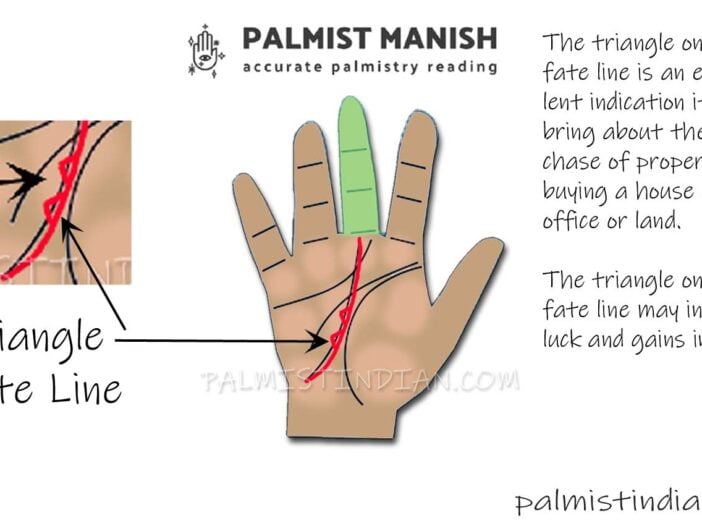
Table of Contents
Learn everything there is to know about the fate line in hand with the help of the illustrations. It is primarily associated with financial prosperity and life stability. The fate line doesn’t really reveal the quantity of money earned.
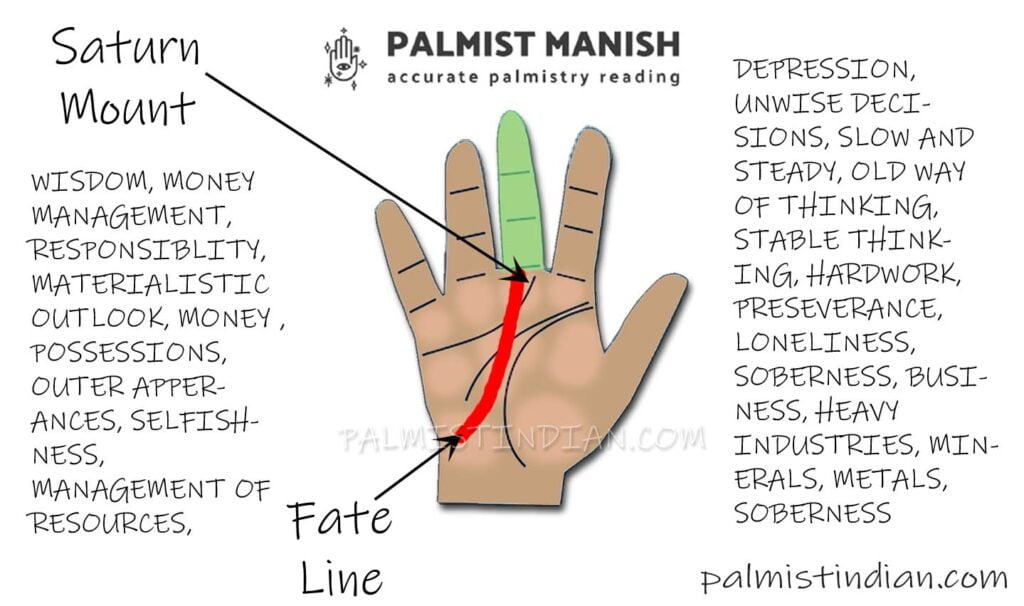
If you want to know your odds of success, look at other lines. Fate line carries very little meaning. Only 15% of success or failure is influenced by fate line. Don’t overestimate the importance of the fate line.
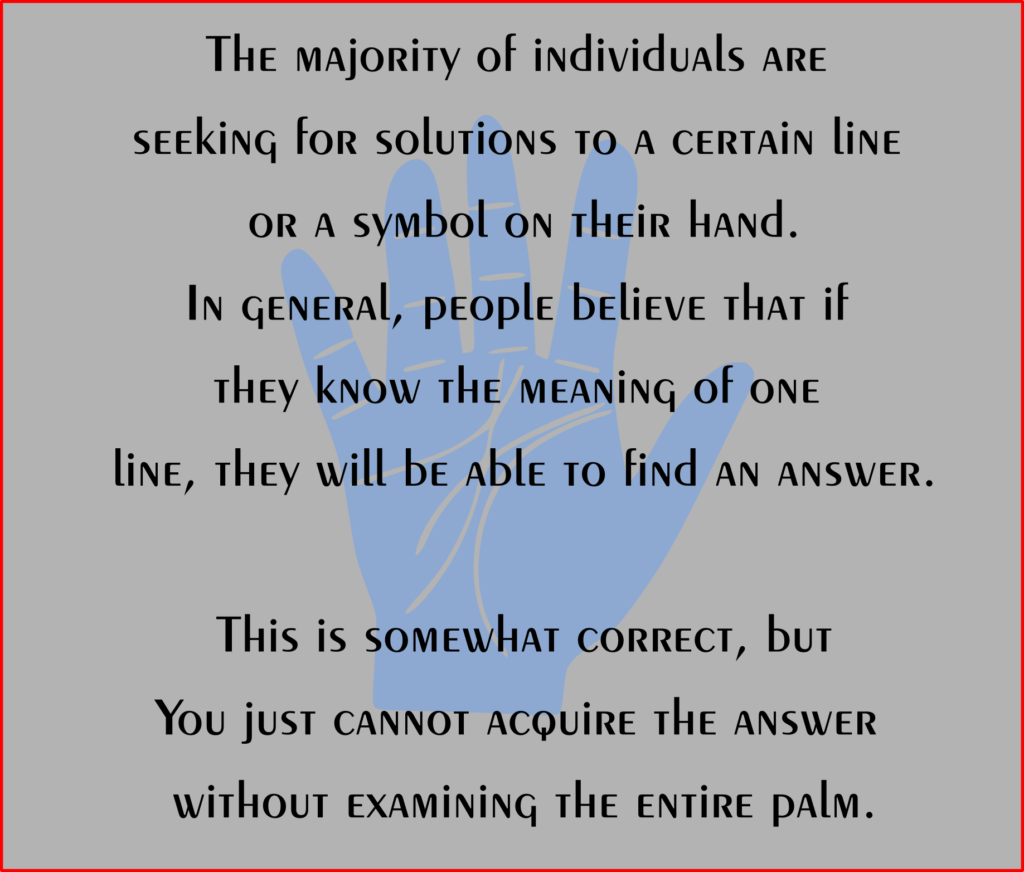
The Saturn line, money line, luck line, destiny line, and possessions line are additional names for the fate line.
Almost everyone, wealthy or not, has a destiny line. Poverty is not always a result of the absence of a fate line.
The starting point of the fate line can be found in various places. The second and longest finger, or the Mount of Saturn, is where the line always terminates. Everyone wants to know about the fate line during a palm reading.
The fate line represents prosperity, possessions, and money. Most people have a fate line. Both the wealthy and the beggar possess a fate line. A rich might not have a fate line, while a pauper might have a good one. The absence of the fate line does not necessarily rule out the possibility of wealth.
Beggars and Billionaire do have a fate line
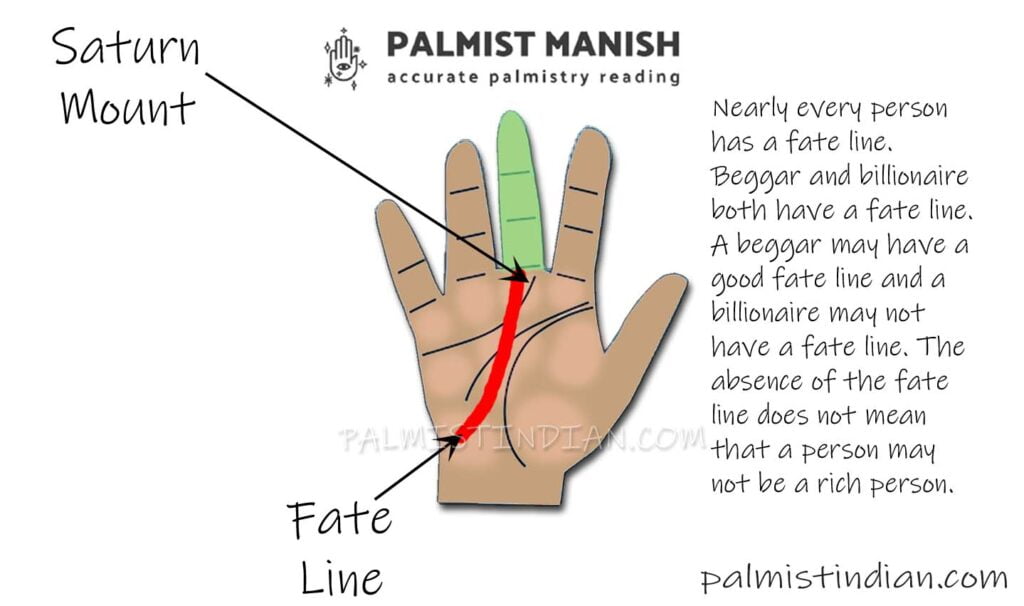
The fate line on a hand comes in a wide range of forms, sizes, and with different symbols. The Mount of Saturn is typically where the fate line terminates. According to palmistry, the Mount of Saturn represents prosperity, possessions, wisdom and a person who is grounded and knows the ground realities of a situation.
There are also negative aspects to Mount of Saturn. The person may become depressed, unable to make smart logical rational decisions, pessimistic, and ignorant of reality.
Too much importance is given to fate line
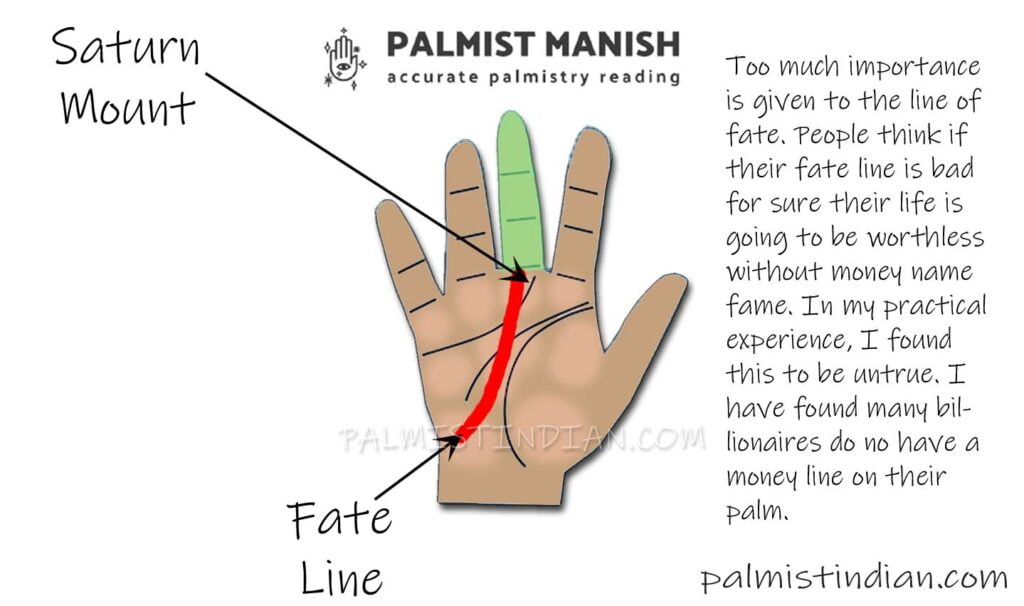
The fate line is given far too much importance. People believe that if their fate line is bad, their life will be worthless without money, name, or fame. This hasn’t been my experience in practical palm reading.
Many billionaires, I’ve discovered, do not have a fate line on their palm. When the fate line is completely absent, the possibilities are endless. A single fate line that is deep and clear may produce excellent results. A person with a low-wage job, such as a simple cleaner, may have a strong fate line.
What role does fate line play in determining how much money we will have in our lives?
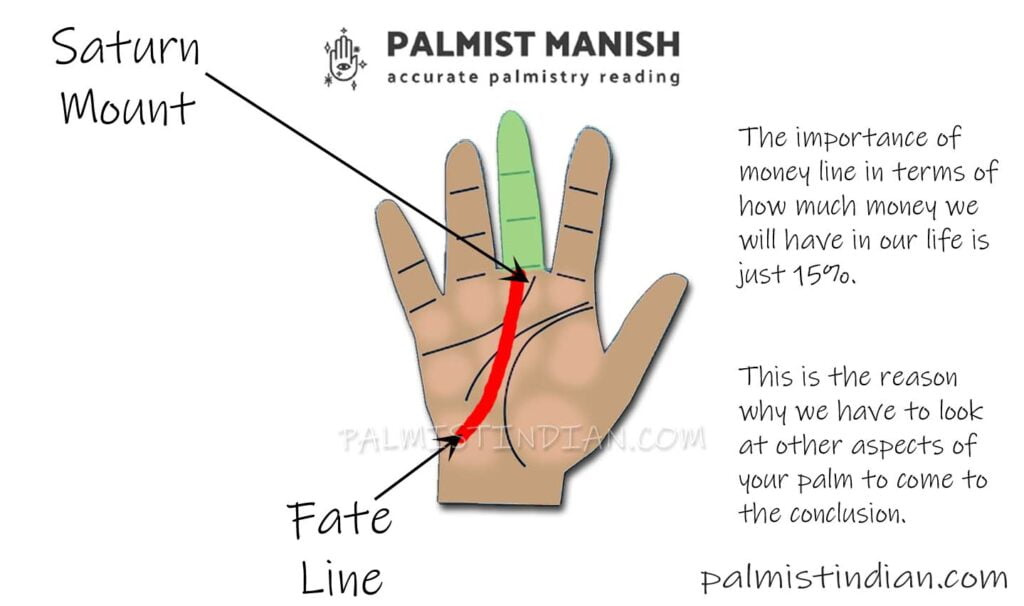
We need to look at other aspects of your palm to reach a conclusion. The significance of the fate line is only 15%.
In palmistry, the fate line is thought to represent a person’s life path, including career, achievements, and financial status. However, the absence of a fate line on a person’s palm does not necessarily imply that they will not be successful or wealthy in life.
Some people have no visible fate line, while others have a faint or incomplete line. In some cases, changes in circumstances or personal development may cause the fate line to emerge later in life.
Fate line and mount of Saturn
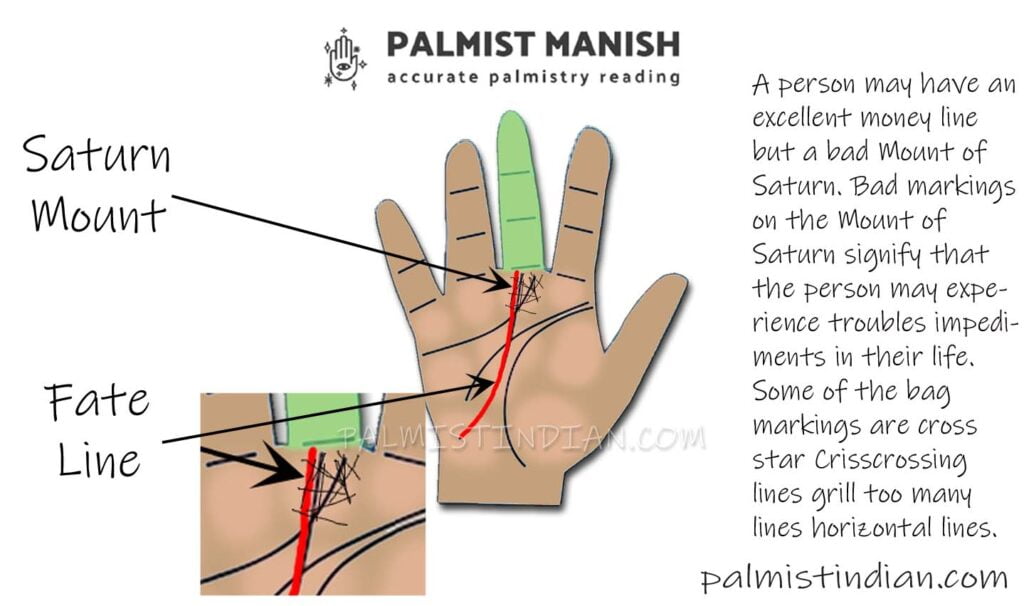
A good fate line combined with a bad Mount of Saturn is a negative sign. Bad markings on the Mount of Saturn indicate that the person will face difficulties, roadblocks, delays, and impediments in their life. Some of the bag markings include a cross, a star, crisscrossing lines, a grill, and endless confusing horizontal lines.
Saturn’s mount is located at the base of the middle finger and is associated with discipline, responsibility, and perseverance. A well-developed Saturn mount is thought to indicate a strong work ethic and the ability to overcome challenges and obstacles in the pursuit of success.
The fate line and Saturn’s mount are frequently interpreted together in palmistry as indicators of an individual’s potential for career success and financial stability. A strong and well-defined fate line that ends at Saturn’s mount is thought to be a good omen for success and wealth, whereas a weak or absent fate line may indicate a more difficult career path.
Fate line and mount of Mercury
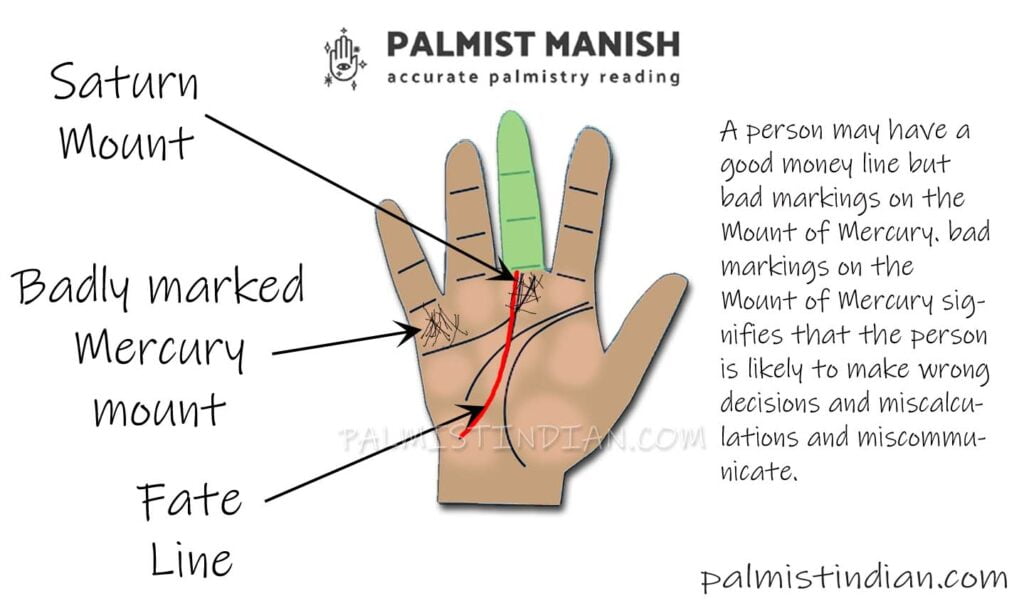
A favourable fate line but negative markings on the Mount of Mercury indicate negative outcomes. Bad markings on the Mount of Mercury indicate that the person is prone to making poor decisions, miscalculations, and miscommunication.
Grill, island, horizontal lines, crisscrossing lines, and broken mercury line are examples of bad markings on a Mercury mount. It stands to reason that if a person miscalculates and miscommunicates, the likelihood of suffering losses increases. These negative indicators apply to one’s entire life, not just one year. The bad markings on the Mount of Mercury are weak horizontal and vertical lines crossing each other. Too many weak lines on the Mount of Mercury indicate that the person is multitasking. To be successful it is better not to multitask, and be a specialist.
Vertical lines on the mount of Mercury is an excellent sign of success. A single vertical line is better than multiple weak lines on the mount of mercury. To be successful in today’s world, you must be a specialist. Single lines mean you are a specialist.
Mercury’s mount is located at the base of the little finger and is associated with communication, intelligence, and calculations. A well-developed Mercury mount is thought to indicate a talent for communication as well as the ability to succeed in careers that require skills.
The fate line and Mercury’s mount are frequently interpreted together in palmistry as indicators of an individual’s potential for career success and financial stability. A well-developed fate line with one branch pointing towards Mercury’s mount is thought to be a good omen for success in communication-related fields such as business, medical science, engineering, journalism, public relations, or advertising.
Fate line starting from mount of moon
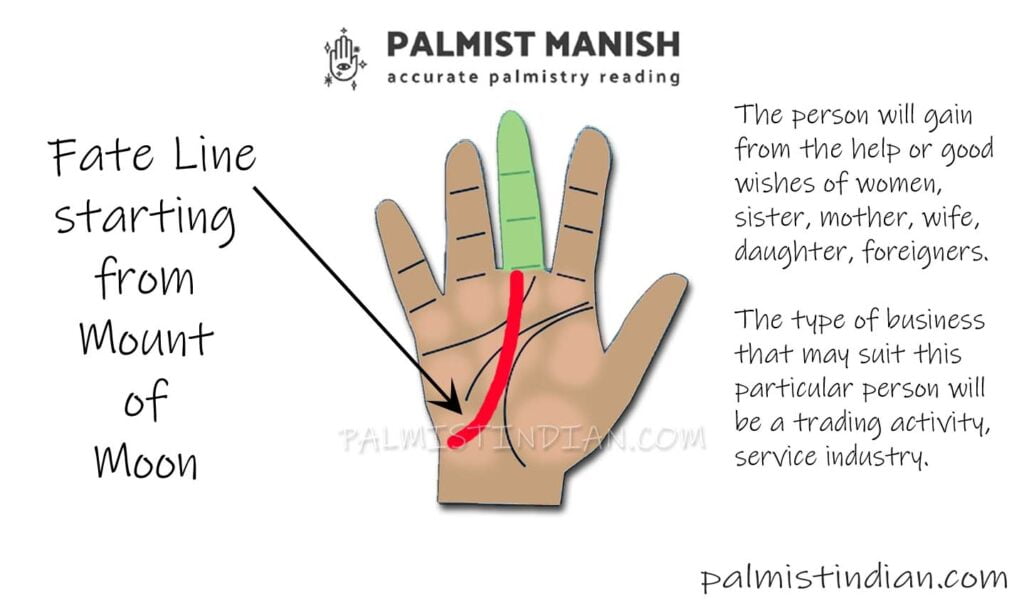
If the fate line starts from the mount of the moon it indicates that the person will gain from the help or good wishes of women, sister, mother, wife, daughter, foreigners. The type of business that may suit this particular person will be a trading activity, service industry.
Fate line broken on the mount of mercury means problems during the early portion of your life and family life as well.
Y shaped Fate line
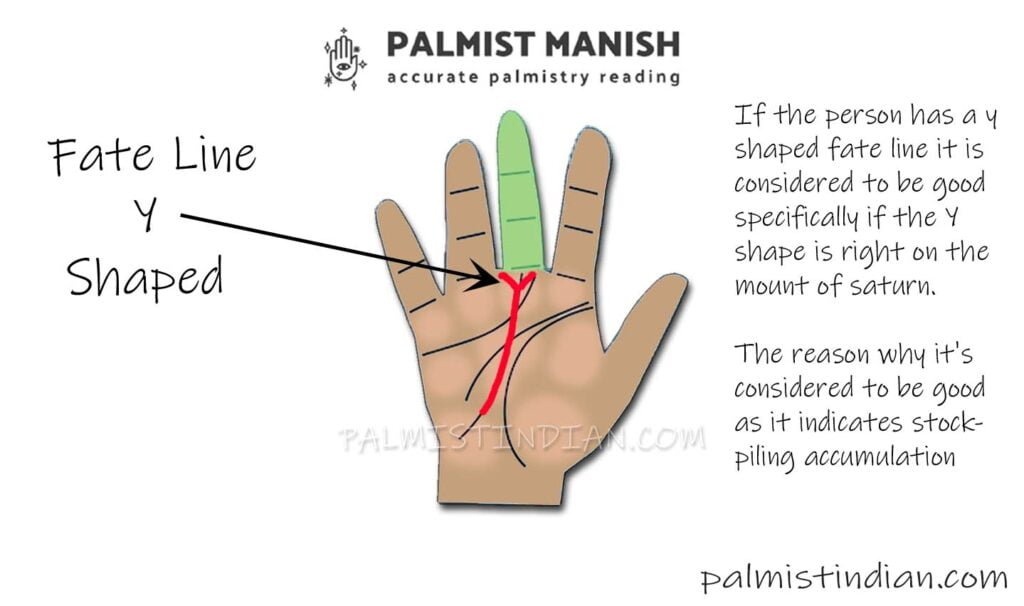
If the person has a y shaped fate line it is considered to be good specifically if the Y shape is right on the mount of saturn. The reason why it’s considered to be good is as follows.
Consider Y to be a net and it catches the fish. In the same way, the energy or light or current that penetrates the fingers and move towards the palm are being cached, stockpiled, accumulated, stored for future use.
Fate line broken forming a Y is not the best sign to have. It’s better to have a perfect Y formation instead of broken.
Fish sign on Fate line
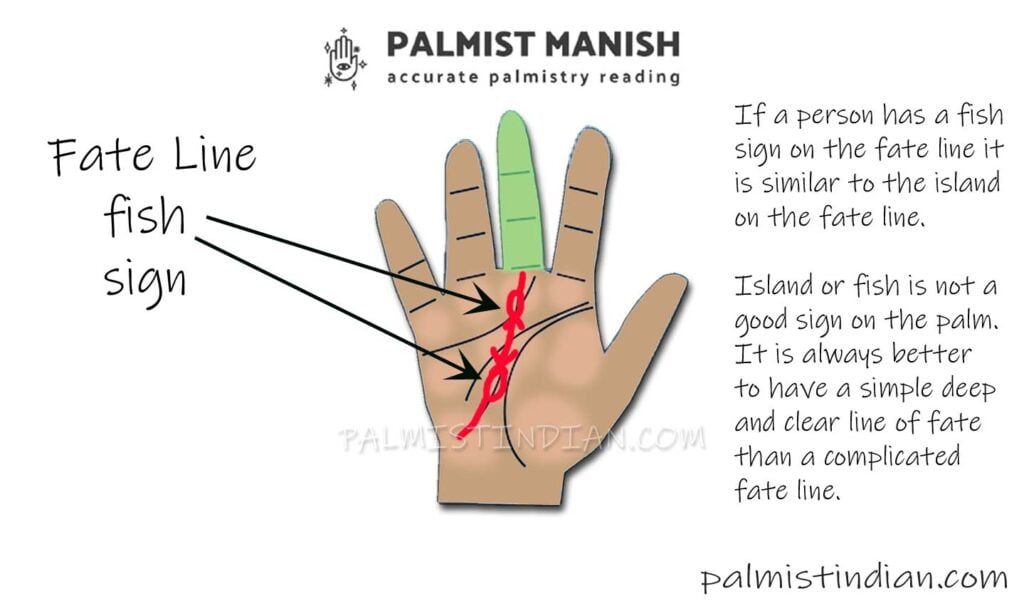
The island on the fate line is similar to the fish sign on the fate line in hand. On the palm, an island or fish sign on the fate line is not a good sign. A simple, deep, and clear fate line is always preferable to a complicated fate line.
Many palmists are making videos on YouTube these days claiming that the fish sign on the fate line is an excellent sign; however, I completely disagree with them. There is no mention of fish on the palm in any good palmistry book.
It is said that Indian Vedic books discuss these rare signs, but these books are not visible or available for purchase. I haven’t come across any Vedic palmistry books in the last 35 years mentioning that fish is a sign at all. Nowadays, palmist authors use the title Vedic palmistry, but the book contains no Vedic content.
A broken fate line with a fish sign is a worrying sign. Fish sign palmistry has become so popular in recent years that I’m left wondering why it wasn’t available before. Implying you have a rare sign like a fish is an easy way to fool people. Due to a lack of basic palmistry knowledge, fake palmists only discuss rare signs.
Short fate line it’s meaning
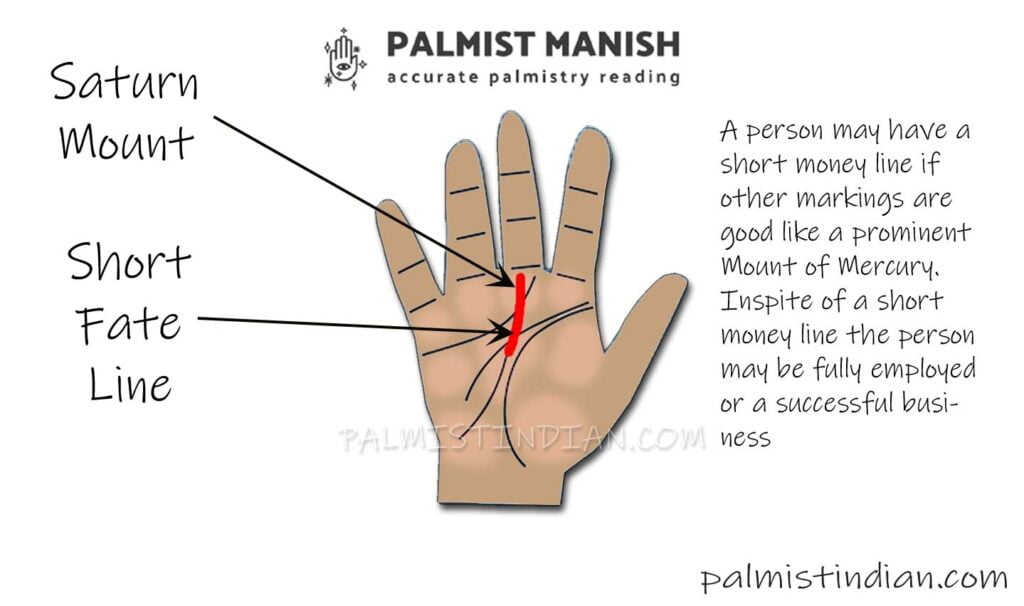
A person with a short fate line and a prominent Mount of Mercury is a good sign. It does not matter if the fate line is short. Despite a short fate line, the person may be employed in a high-paying job or running a successful business.
Fate line stops at heart line
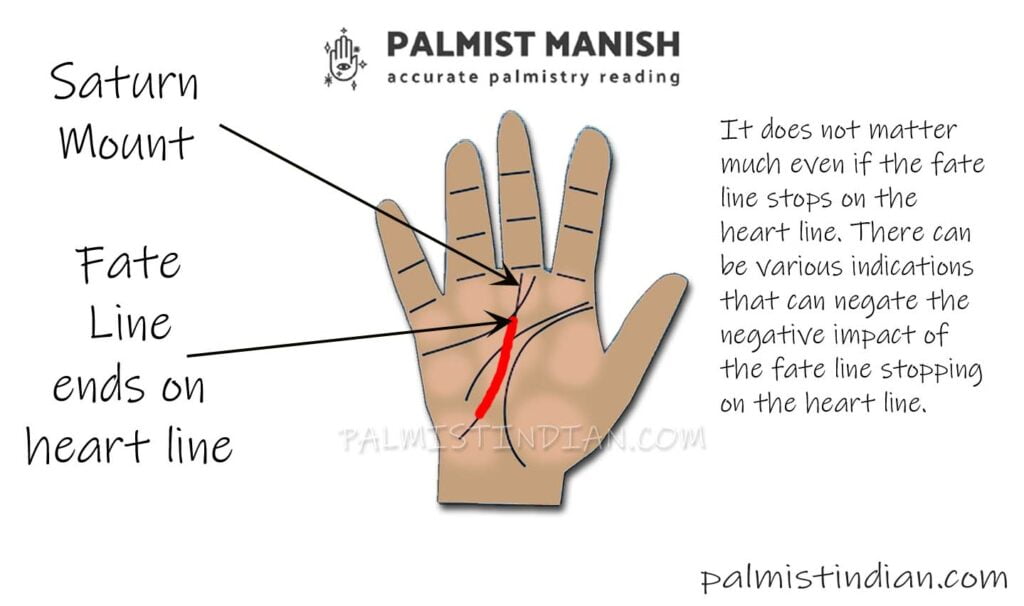
It does not matter much even if the fate line stops on the heart line. There can be various indications that can negate the negative impact of the fate line stopping on the heart line.
If the hand structure is strong less or no impact of fate line ending on heart line. Mount of Mercury, Venus, and the Sun should be prominent and positive. It means no unnecessary lines over the mount.
Mount of Saturn should not have grill like lines or crisscrossing lines over it, this will bring hardship if the fate line ends on the heart line. If there are no lines on mount of Saturn in that case no negative impact.
Broken fate line palmistry
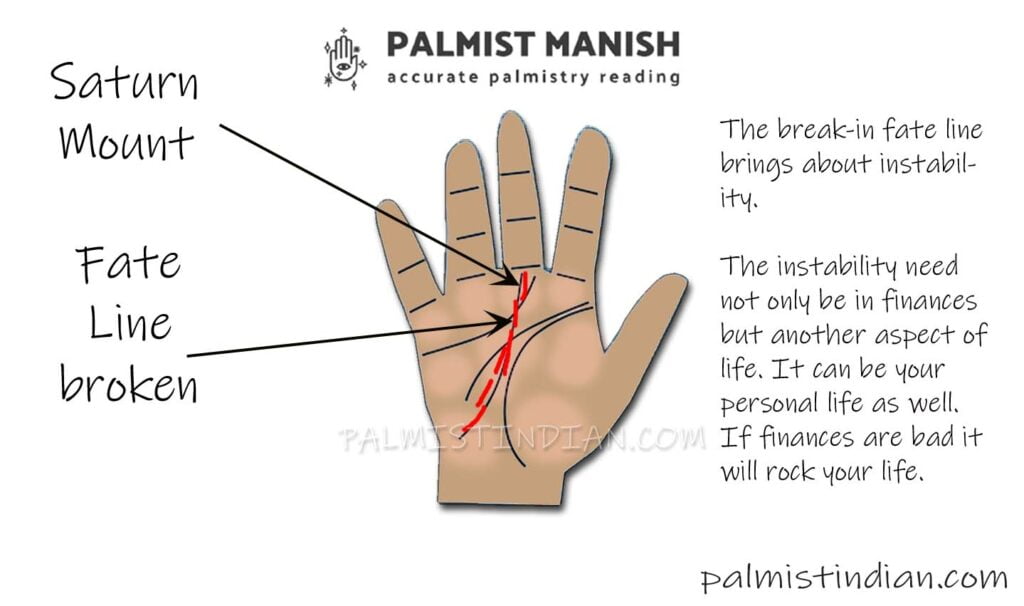
A broken fate line in hand/palm is a negative sign but people should not fear it as it’s only a temporary setback, not a permanent setback. There may be thousands of signs on your palm that may negate the break-in fate line. The fate line broken brings financial instability. The instability need not only be in finances but another aspect of life. It can be your personal life as well. If finances are bad it will rock your life.
Fate line broken at the headline in many hands this is age 35 and it’s a major portion of one’s life. The person is married and parents getting old so trouble mounts on this particular person. More responsibilities come on this person’s head, as the father or main earning member’s health or wealth deteriorates. A person’s wealth, business, or job may also get affected.
Fate line branches end
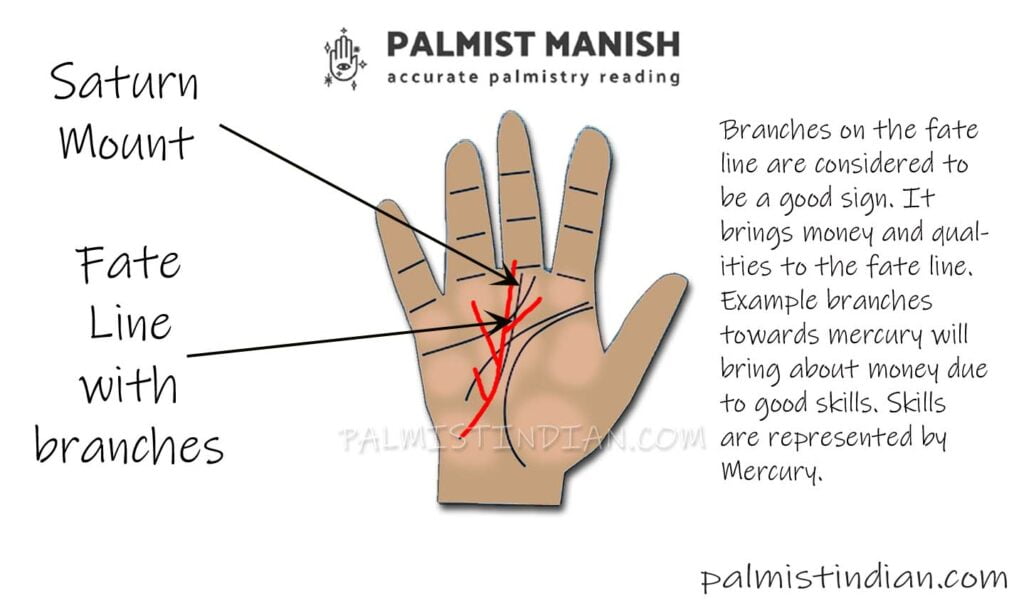
Fate line branches palmistry f firm, deep, clearly pointing towards the fingers is considered to be an excellent sign. Branches on the fate line are considered to be a good sign. It’s not all about luck it’s also to do with our hard work and consistency. The mere presence of fate line in hand does not guarantee success. Example branches towards mercury will bring riches due to good skills. Skills is represented by Mercury.
Fate line with branches towards Mars negative

Branches pointing towards inner mars, mars negative is a bad sign/a negative sign. Mars’s negative symbolizes aggression and fire. Therefore if the fate line in palmistry or a branch from the fate line points towards the mount of mars negative, it means all that you earn is destroyed or losses.
Double Fate line / parallel fate line in palmistry
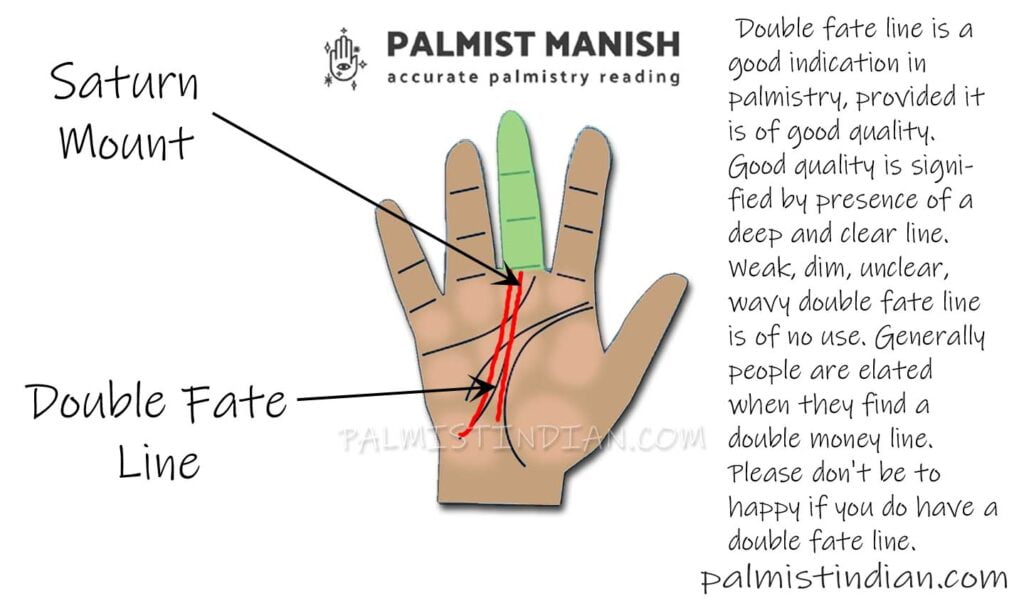
Double fate line in palmistry is a lucky sign, provided it is of good quality. Good quality is signified by the presence of a deep and clear line. A weak, dim, unclear, wavy double fate line is of no use. Generally, people are elated when they find a double fate line. Please don’t be too happy if you do have a double fate line. Double fate line does not a person will earn millions and billions.
Double fate line may just mean that you may have a dual income. Dual income is not more income. A single source of income is better than multiple sources of income. If the fate line is deep and clear it signifies that the person will have a support system in place. It can be partner may support in income. It’s an extra pillar of strength with the presence of double fate line.
Fate line age in palmistry
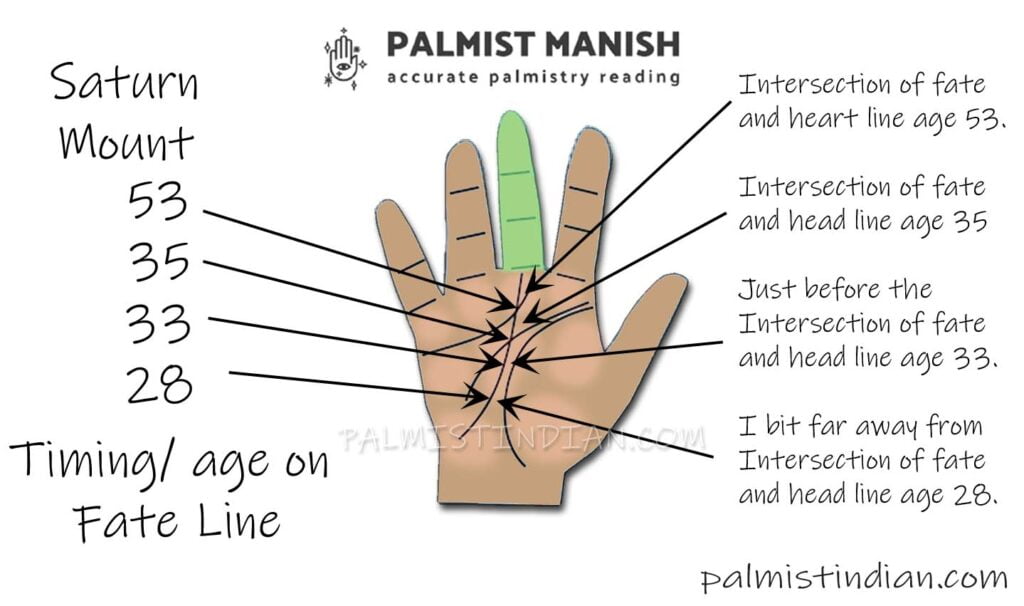
The intersection of fate and heart line is age 53. The intersection of the fate line in hand and head line is age 35 on your fate and head line. Just before the intersection of fate and head line age 33. A bit far away from the Intersection of fate and head line is age 28 years on your fate line.
Palm reading no fate line
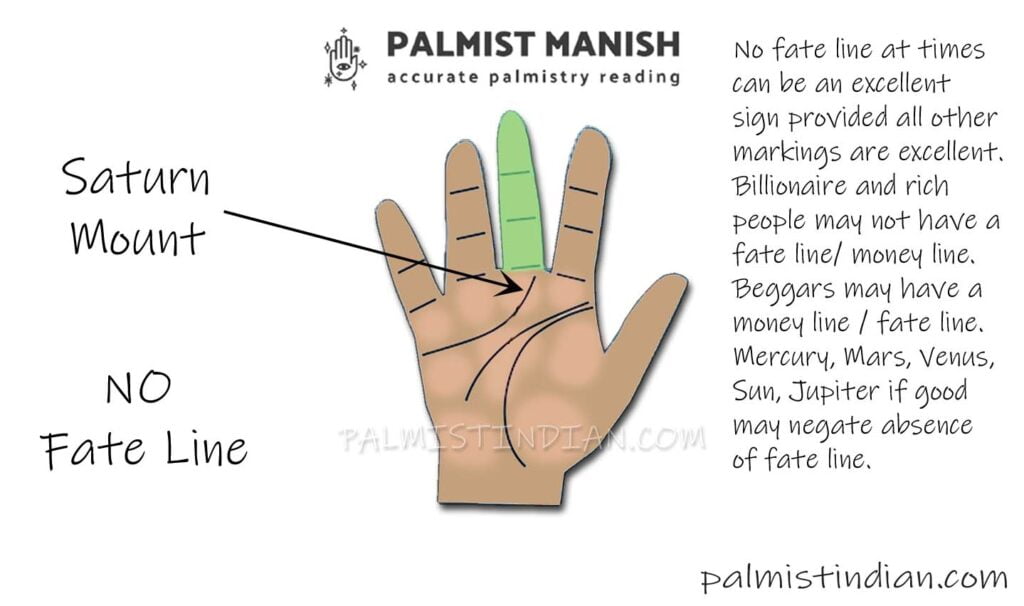
No fate line in palmistry, at times can be an excellent sign, provided all other markings are excellent. Billionaires and rich people may not have a fate line. Beggars may have a good fate line but are still poor. Good indications and prominent mount of Mercury, Mars, Venus, Sun, and Jupiter may negate the absence of fate line. Palm reading of fate line for money is not limited to just reading the money line.
Island on fate line in palmistry
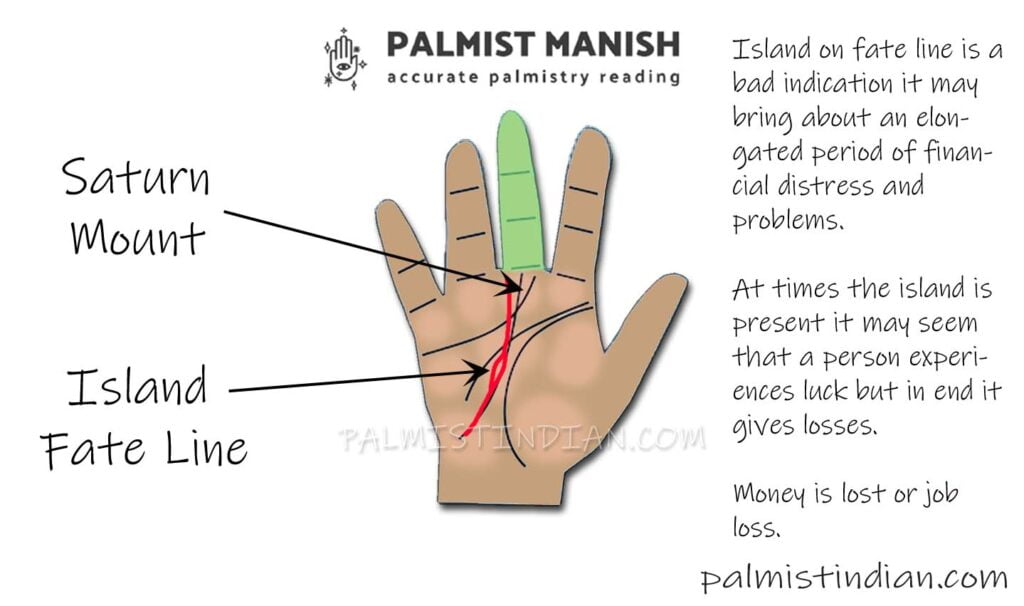
Island on fate line in hand is a bad indication it may bring about an elongated period of financial distress and problems. At times the island is present it may seem that a person experiences luck but in end the person experiences losses or job loss.
Triangle on fate line in palmistry
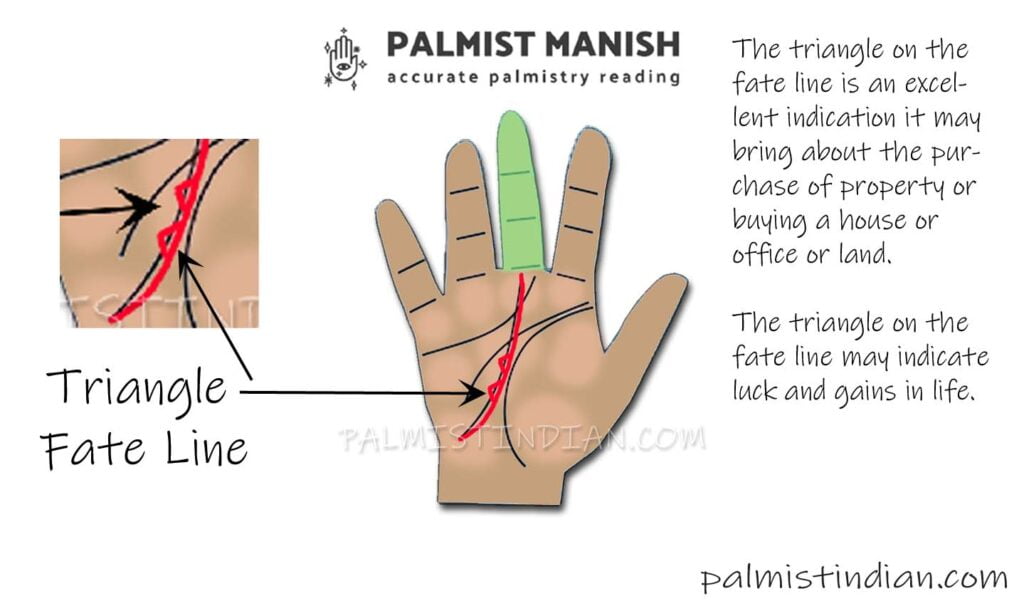
The triangle on the fate line is an excellent indication it may bring about the purchase of property or buying a house or office or land. The triangle on the fate line may indicate luck and gains in life.
Cross on fate line in palmistry
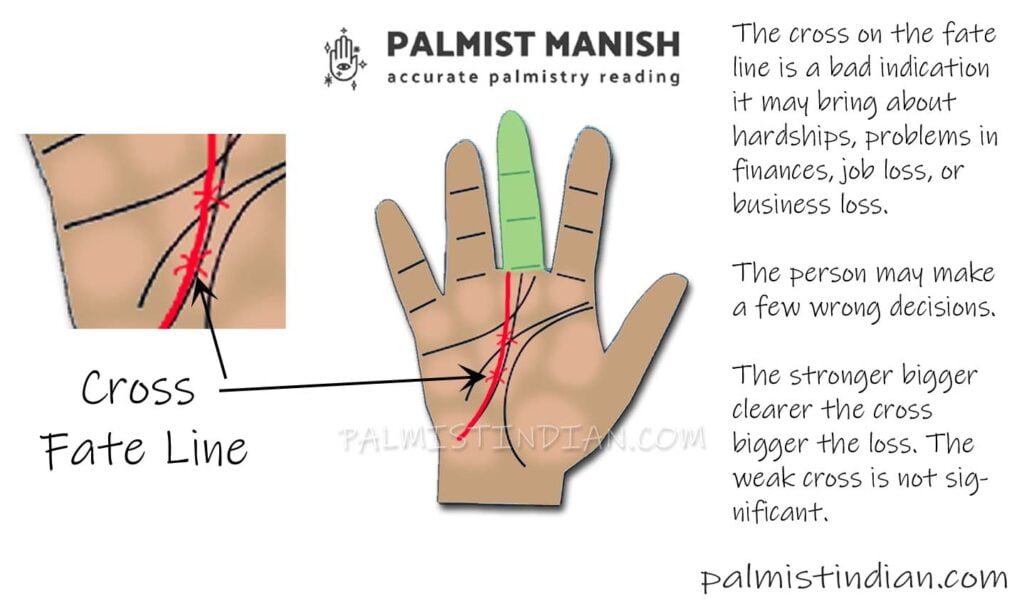
A cross on the fate line may indicate job loss or business loss. There is various degree of job or business loss. It all depends on how big/strong the cross is. Sometimes on well-structured hands, a small cross may give a bigger loss as it’s something like one is driving a high-performance car at great speed. A weak hand with a bigger cross may not give a major loss as the car is at a slower speed and the impact is weak.
The cross on the fate line in hand is a bad indication it may bring about hardships, problems in finances, job loss, or business loss. The person may make a few wrong decisions. The stronger clearer the cross bigger the loss. The weak cross line is of no significance.
Square on fate line in palmistry
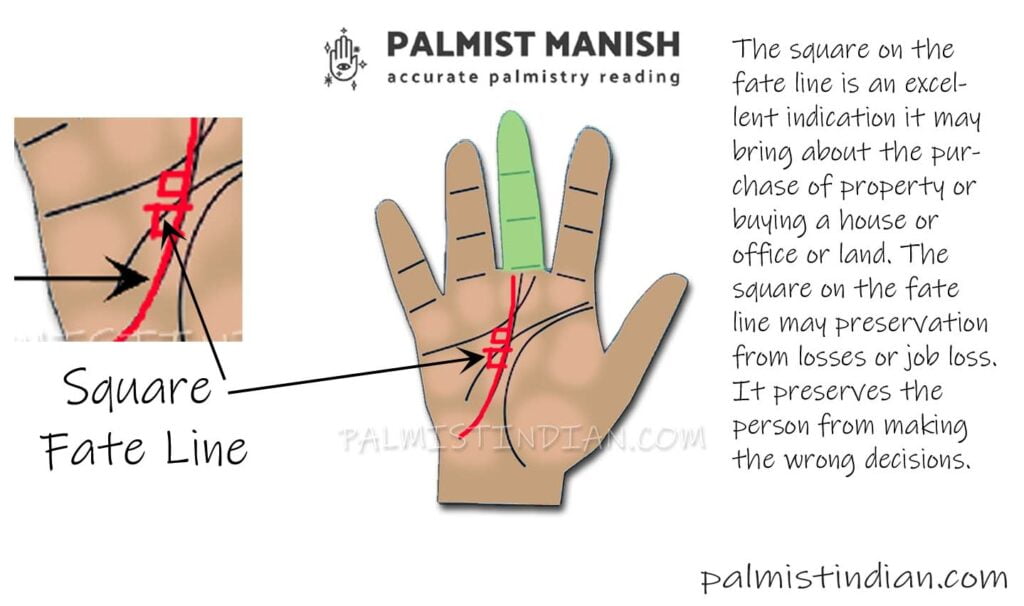
The square on the fate line is an excellent indication it may bring about the purchase of property or buying a house or office or land. The square on the fate line may preservation from losses or job loss. It preserves the person from making the wrong decisions.
Broken fate line and covered by a square so it means preservation. We feel safe in our house/room and the shape of the house is square. Therefore a square on any line means preservation from losses/trouble/hardships.
Fate line stops at head line
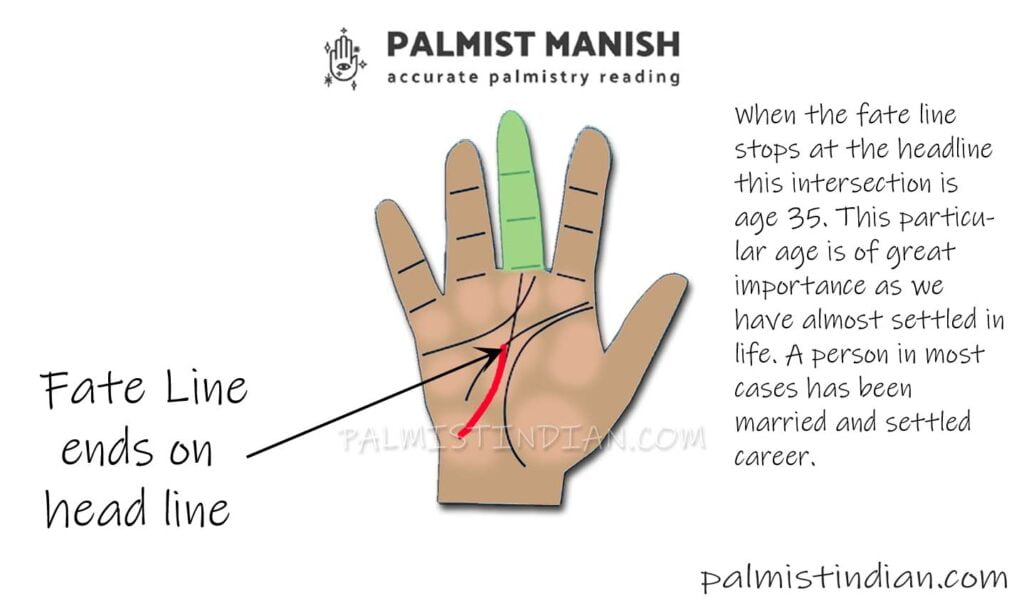
When the fate line stops at the headline this intersection is age 35. This particular age is of great importance as we have settled in life. This is when troubles start as parents are getting old and biological changes are taking place in mother and partner. The same important aspects playing out on the palm as well.
The meaning of the ending or stopping of the fate line on the headline is an indication of to be trouble. Fate line broken has their effect on the money aspect but on other aspects of life as well. It can be a job loss or work loss. It can be the father or main earning members’ bad health or finances.
Fate line and life line joined
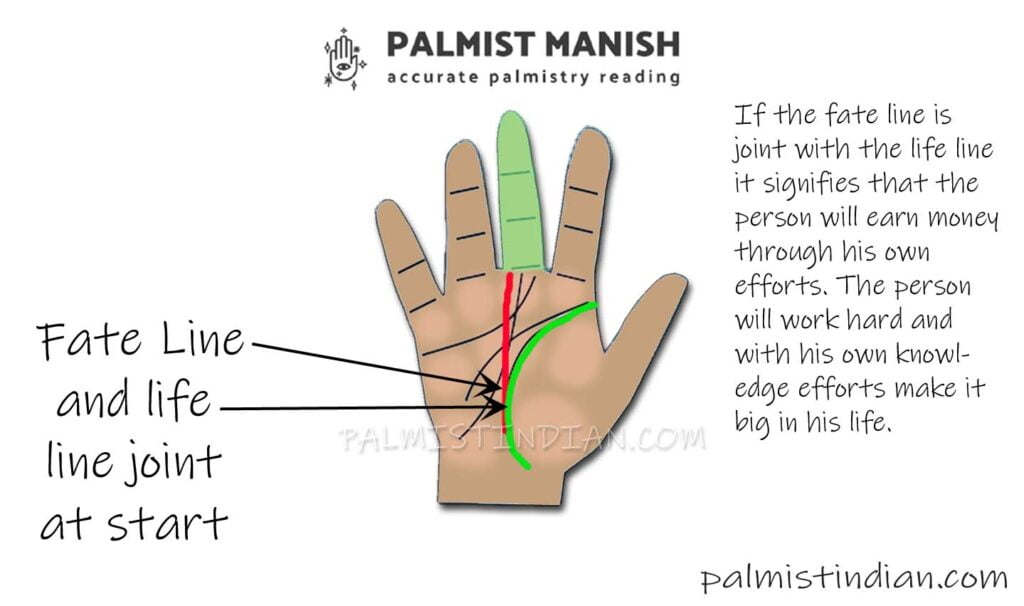
If the fate line is joint with the lifeline it signifies that the person will earn money through his own efforts. The person will work hard and with his own knowledge efforts make it big in his life. We can’t quantify the amount of money the person will earn but the person will be a self-made man.
The meaning of the line remains the same if we say fate line and life line merged or joined.
Fate line and sun line cross
The first instance is that the beginning of the fate line is on the mount of venus. This the point of origination of the fate line so the line moves forwards and it crosses the lifeline while going towards the mount of Saturn. Under these circumstances, the person gains from his family members. Family members play a major role in the success of this person.
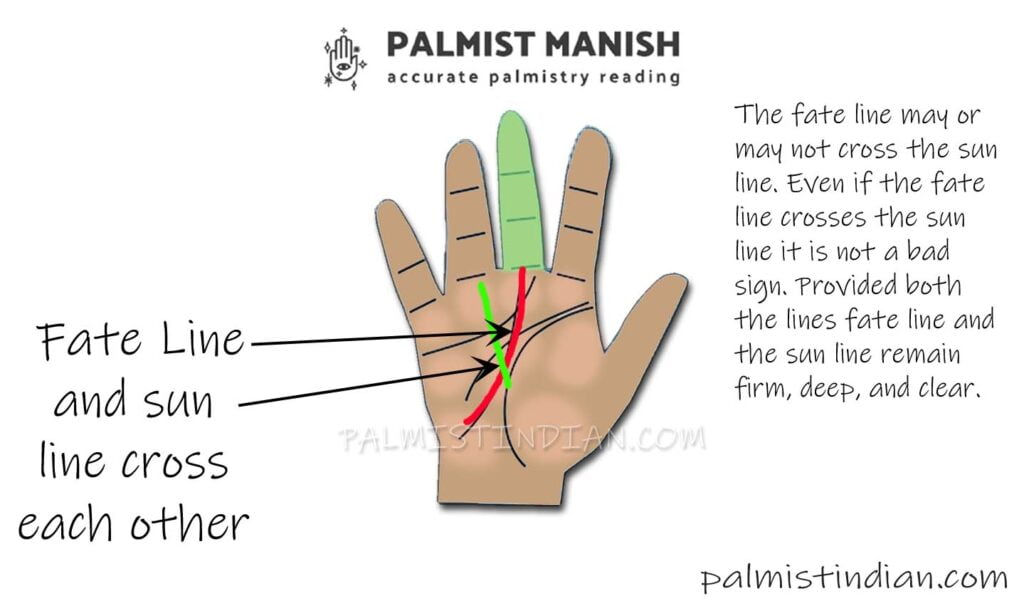
The fate line may or may not cross the sun line. Even if the fate line crosses the sun line it is not a bad sign. Provided both the lines fate line and the sun line remain firm, deep, and clear. If the fate line is starting under the mount of the moon there is a chance that the fate line may cross over the sun line. The crossing of both these lines is not a good or a bad sign, they just cross that, is it.
Fate line and life line cross
The fate line may cross the life line under 2 circumstances.

Cross a small one and purely a cross and not crossing of major trouble lines from the mount of mars is a negative sign. The crossing of trouble lines from mars negative are is also a negative sign.
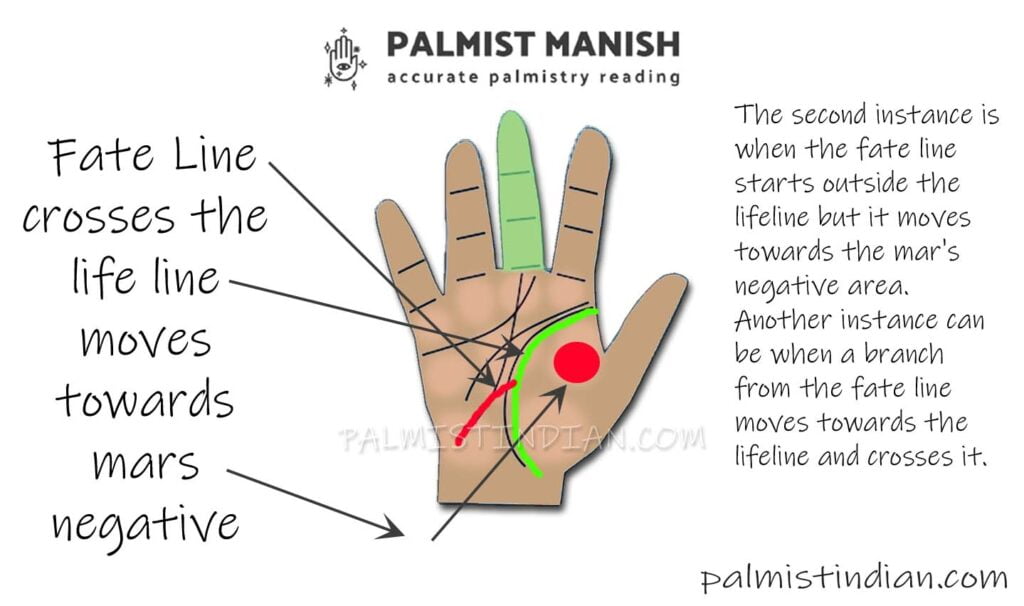
The second instance is when the fate line starts outside the lifeline but it moves towards the mar’s negative area. Another instance can be when a branch from the fate line moves towards the lifeline and crosses it. In both instances it’s a bad sign as the money line that moves towards the mars negative are the are of aggression and fire. If money meaning money moves towards fire it will burn. This is the reason why it’s a negative sign. The name of the mount is Negative mars but don’t this it’s only negative.
Fate line and head line merged
The fate line and headline merged together there can be various variations, deepening upon the palm.
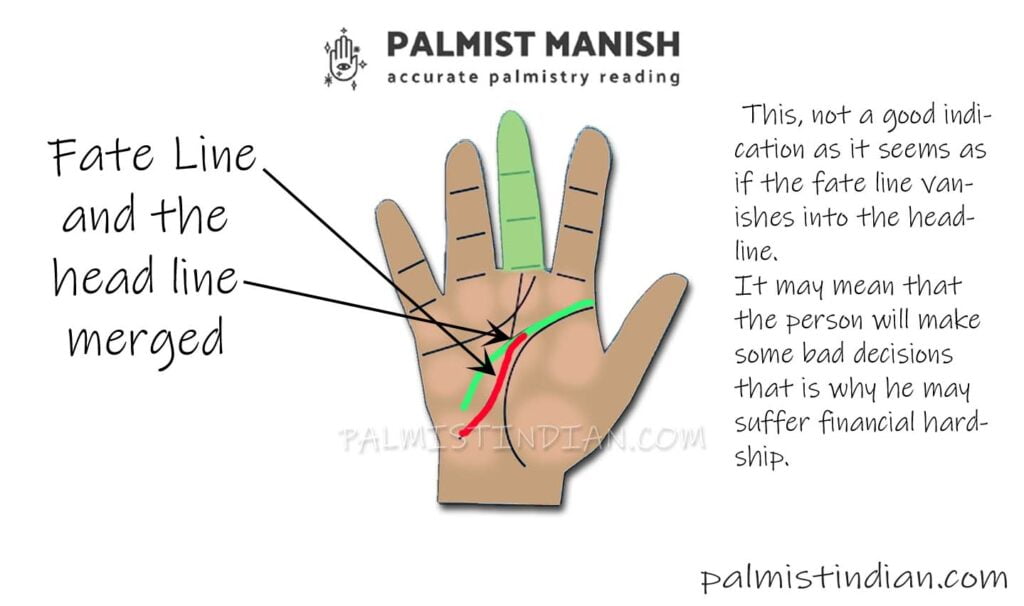
At some point or the other fate or headline is going to be independent.
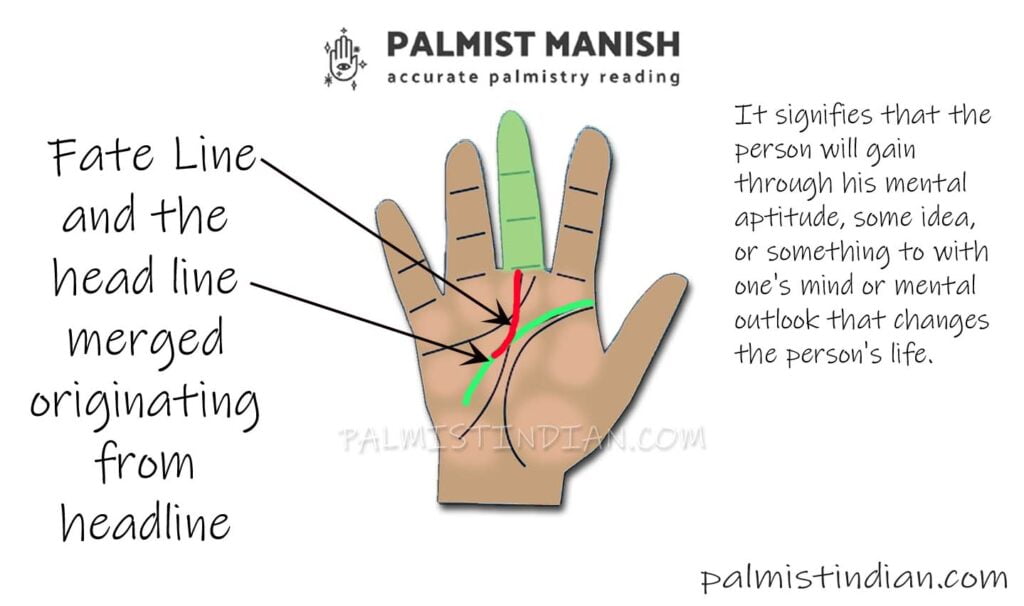
The fate line and headline merged at the start then the fate line moves away towards the mount of Saturn. It signifies that the person will gain through his mental aptitude, some idea, or something to with one’s mind or mental outlook that changes the person’s life.
Fate line and life line parallel
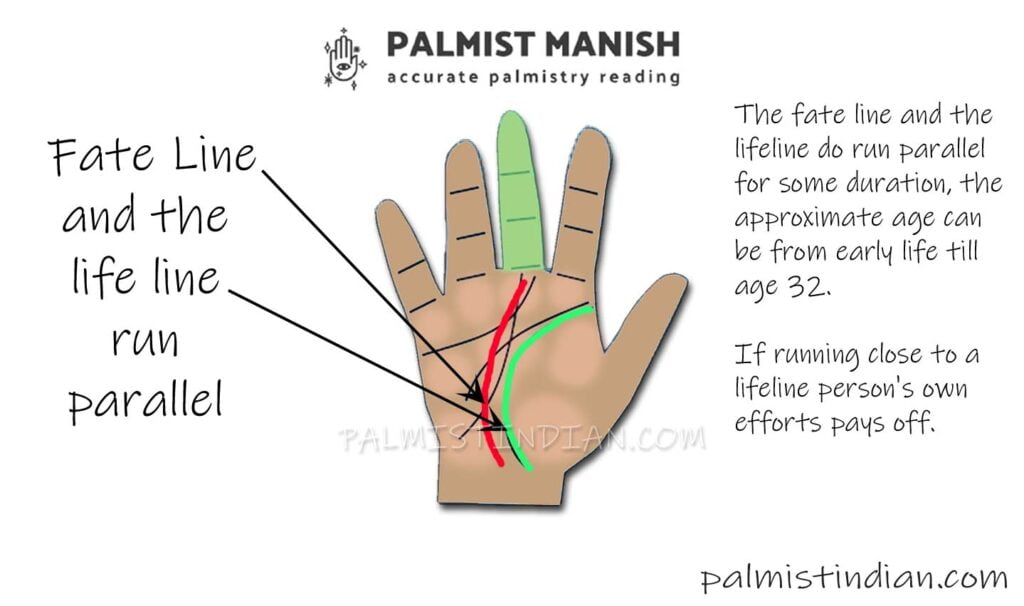
The fate line and the life line do run parallel for some duration, the approximate age can be from early life till age 32. If running close to life line person’s own efforts pays off.
A long fate line
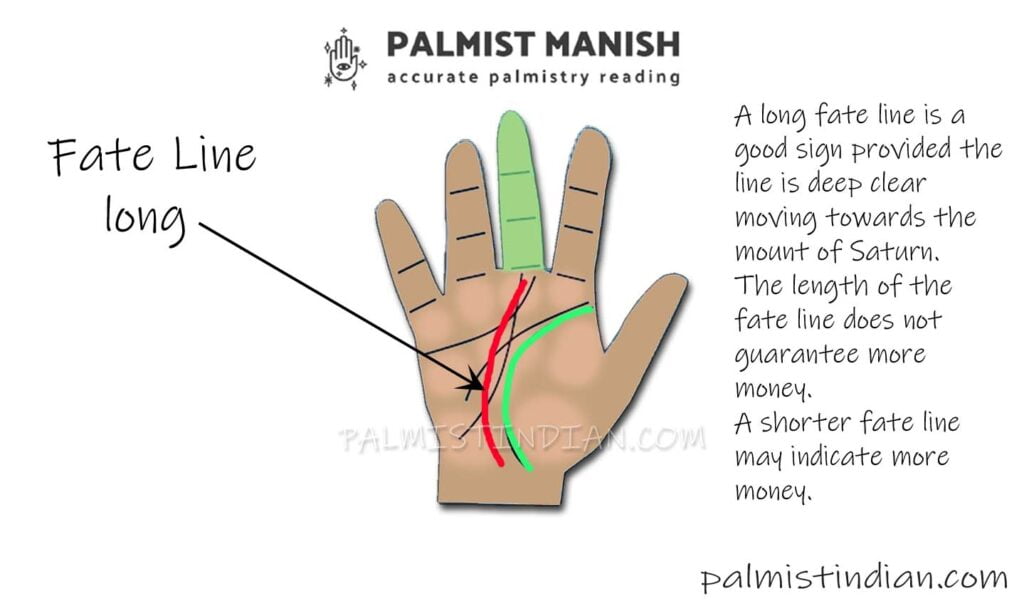
Fate line long moving towards the mount of Saturn if deep clear is a good sign. The length of the fate line does not guarantee more money. A shorter fate line may indicate more money. Money is dependent upon the quality of the fate line and other aspects of the palm and not just the length of the fat line.
A forked fate line
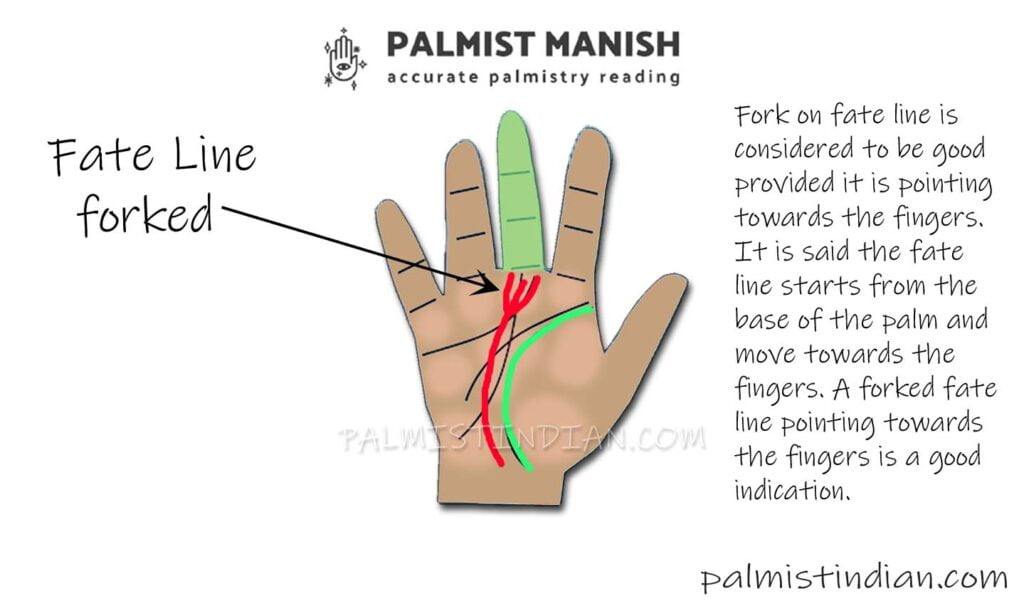
Fate line forked pointing towards the fingers is an excellent sign. The fate line starts from the base of the palm and moves towards the fingers. A forked fate line pointing towards the fingers is a good indication.
While a fork from the fate line if it points towards the lifeline or Mars negative mount may give negative/bad results.
A cross on fate line
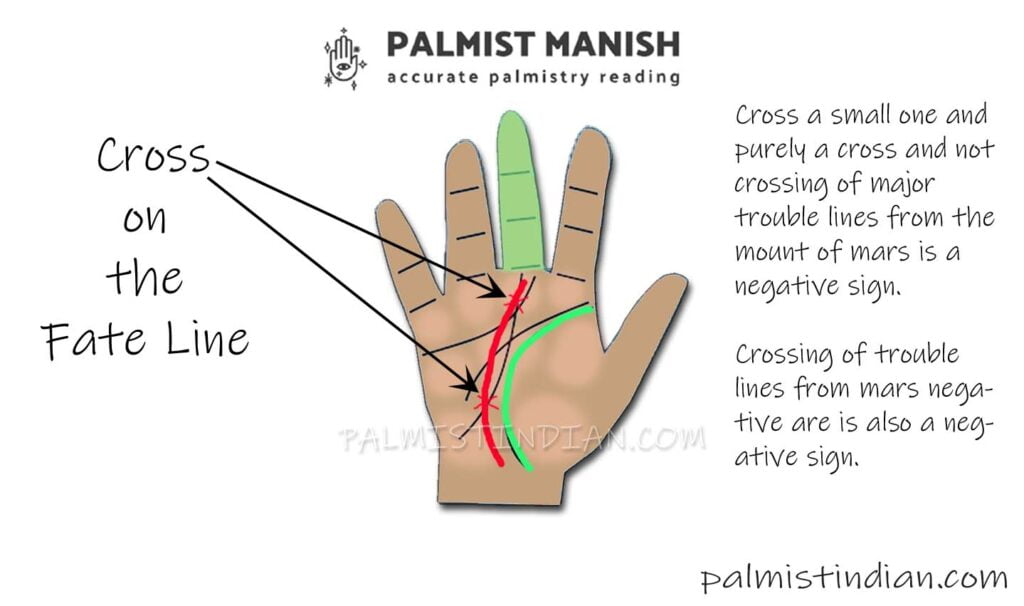
Luck line in palmistry
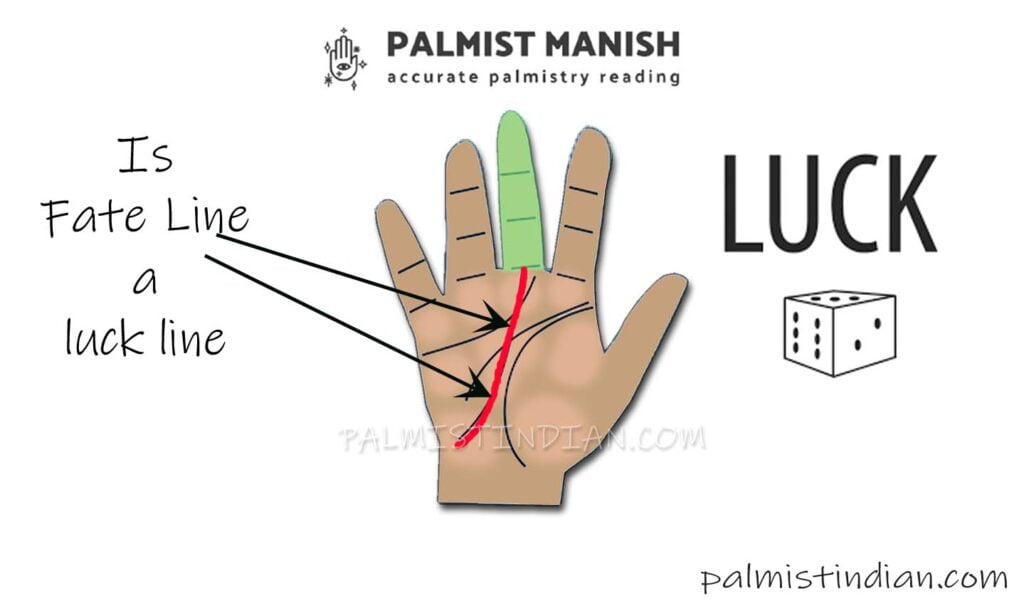
Few people call the fate line to be the luck line although it is a wrong interpretation. The absence of the fate line does not mean bad luck. Excellent possibilities emerge if the fate line is missing totally. This does not mean that other parts of the palm are not good. Another part of the palm should be good only then a person will attain success.
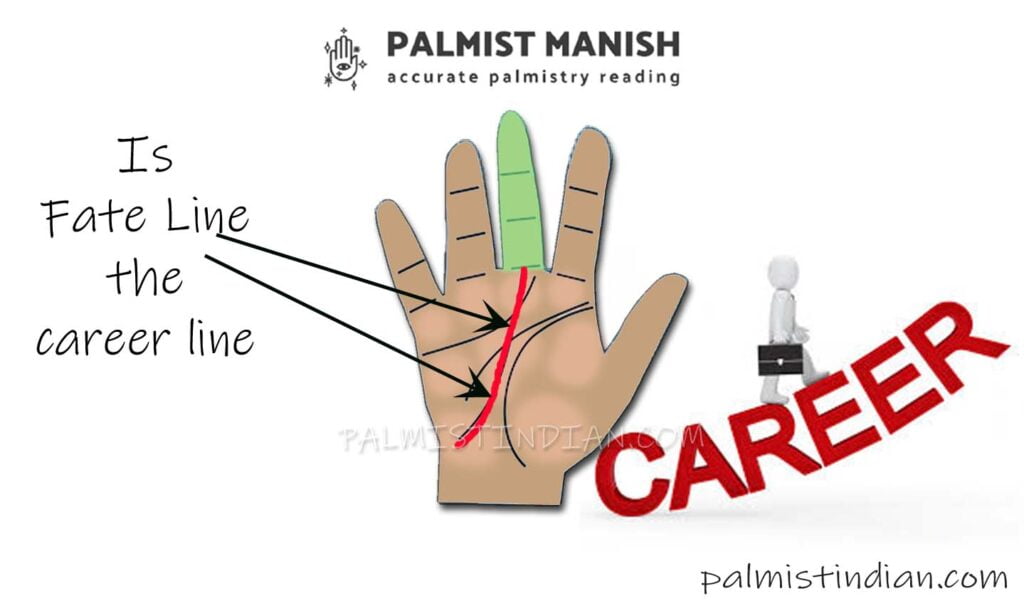
Many people think fate line to be the career line. The fate line does not tell what career you may choose or practicing. The fate line can’t tell the amount of money the person has. A stable fate line in palmistry, point towards stability in finances and personal life.
Government job in hand
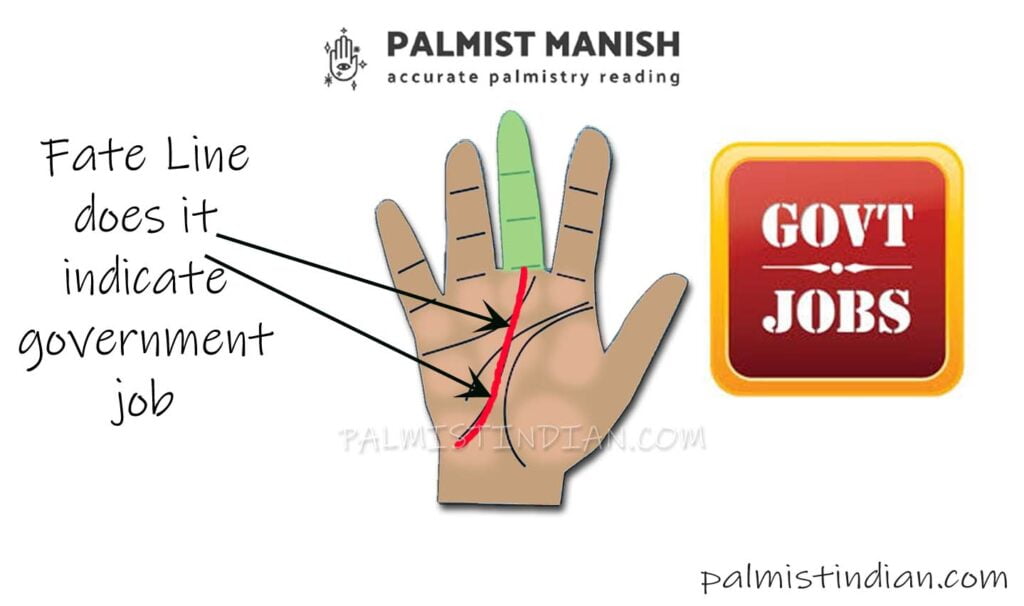
The fate line can’t tell if a person is in government job or will be getting a government job. People in India and similar countries where government jobs are rare and
Reader Interactions
May 6, 2022 at 6:46 pm
Today projecting self very intelligent and trying to define life of others and establishing self as Great Fortune Predictor is À Habit in general manner.Since all have mouth and Tongue none can oppose.I have practiced hand line reading for past 40 years .Still I think my self a beginner Thanks.
May 17, 2022 at 4:56 pm
Well said, but here i am not claiming to know everything. What words in my article made you believe in saying what you said. Every person is a learner and they will continue to learn throughout your life. I will suggest if you do have so much of experience why are you shying away form sharing your knowledge. Share you knowledge so that others benefit.
July 10, 2023 at 8:30 pm
My fate line stop at mind line and than other line start from mind line vertical what it means
July 11, 2023 at 9:24 am
Problems at age 35 financial or Main member of family health or wealth decreases and more responsibility falls onto this person head. The personal life of the person may go down at age 35.
1) Change in career or life direction: The interruption of the fate line at the mind line followed by a vertical line suggests a shift or change in one’s career or life path. It may indicate a transition or a new beginning in a different field or area of interest.
2) Transition in thoughts or mindset: The connection between the fate line and the mind line can indicate a transition or change in one’s thoughts, beliefs, or mindset. It could suggest a shift in perspective that leads to new opportunities or a different approach to success.
3) Combination of fate and mental pursuits: The vertical line starting from the mind line could represent a focus on intellectual or mental pursuits that contribute to one’s overall destiny or life path. It suggests that one’s thoughts, ideas, or knowledge play a significant role in shaping their success and achievements.
all said one must not look at the palm lines in isolation.
August 4, 2022 at 3:21 am
I have a line (not deep but relatively thin) that goes from my heart line diagonally and joins to my fate line. I have a simian variant head and heart line on my right hand, I say variant as it has a partial head line. I know some still call it a simian line anyway rather than a variant, and was wondering what the diagonal line might mean ?? I don’t think it’s a perfect line either think another line cuts a bit of it but yeah I don’t know what that means if anything at all.
August 4, 2022 at 9:23 am
asking just one question is like taking a partial lopsided haircut. a line that is thin is of little importance. However good you may describe it cant substitute actually looking at your hand images. Heart line joining the fate line towards the fingers is the relationship will help you in your finances. if the heart line branch moves towards the opposite direction towards the head line it will be negative.
November 21, 2022 at 6:04 pm
Would you aadvise what does it mean when the fate line has a fork at head line and after that from the left line continues and ends up at the heart line, there is one more parallel line to the right which starts from the head line and ends up at the heart line?
December 3, 2022 at 12:22 pm
However hard you may explain regarding the kind of lines that you have. It can’t compensate. You actually showing the hand. Trident pointing towards the fingers. Even if it is. Touching the headline is considered to be good. The timing is age 35. So if the Trident may be starting before the age of 35. So good finances can be expected before the age of 35. The other lines that you are mentioning. That is starting from the headline. Is something new? Happening at the age of 35. Whatever I may have answered, it is of no use because I’ve not seen your hand. Many things have to take in to be taken into account, like depth of line, clarity of line, if there’s a wave like formation, if it is a straight line. Many thanks.
October 28, 2023 at 7:10 pm
That means you should use your mind more than fate to succeed
November 9, 2023 at 7:39 pm
I’ve tried to describe everything possible. Every line in your palm can be associated with money. Your headline, your hardline, your Venus Mount, Mercury Mount, Saturn Mount, Jupiter Mount, Mercury Mount, Sun Mount, Mount of Moon.
Yes you need to use your mind, no one can deny that.
August 15, 2022 at 6:47 pm
I do not have fate line . What does it signify ?
August 17, 2022 at 11:19 am
i have already answered this question in my article. no fate line may not be such a bad indication. at times it may indicate unlimited possibilities. the whole palm needs an analysis instead of just fate line. every line on the palm can be associated with money.
August 25, 2022 at 9:01 am
My fate line starts from moon area merges with heart line and from little right of heart line goes straight towards mount of saturn What does it indicates
August 31, 2022 at 7:25 am
partial palm reading is of little use. Money line starting from moon brings benefits from various location such as women, foreigners, trading activity, service industry. Merging of heart and fate line and pointing towards fingers means gains with combination from loved ones.
September 23, 2022 at 6:12 am
My headline has an island under Apollo which, it seems, is never talked about in palmistry. It started when I tried my hand at art five years ago at the age of 82. Is it a bad sign?
September 23, 2022 at 8:17 am
island on the head line anywhere means an elongated period of stress and anxiety. mentally disturbed. as its under the sun mount, this time comes in the later portion of one’s life. Kindly let me know if you think this aspect applies in your case. It measn splitting of ones thought into two and then the line widens and then its merging of lines. merging of the who lines means the problem is tapering or ending.
September 25, 2022 at 9:30 am
Thank you for that reply. I do not think that the stress, anxiety and mental disturbance you refer to really applies to me as I very much enjoy the artistic challenge. Would you agree that maybe the island developed because it is something new in my life with which I struggle even though I enjoy the struggle?
September 23, 2022 at 11:19 am
island on lifeline under Saturn is at what age
September 25, 2022 at 8:43 am
The range of age is between 12 to 41 . More specific between the age of 26 to 29. These are approximations only
August 1, 2023 at 10:01 am
My fate line is parallel to life line stop at head line.then a line start and that line also stop on heart line and a new line appear which go under middle finger. There are also lines and squares between life line and fate line..
September 25, 2023 at 5:45 pm
A parallel fate line that terminates at the headline typically represents events before the age of 35. A break in the line of fate around this age may indicate potential challenges related to work, business, elder health, and personal life. Another fate line appearing above the headline, below the heart line, signifies an impending change in your life after the age of 35. The quality of this line can offer insights into the success of your endeavors. A square between the lifeline and the fate line suggests a safeguarding of both health and financial well-being.
September 24, 2022 at 11:25 am
What does it mean when life line, fate line and travel line are joined together? It is a good sign? Thanks
September 25, 2022 at 8:49 am
cant comment what it may mean actually without taking a look at one’s palm. Its common to ask one question and think we know what our plam tells about us. Its the wrong way. Anyhow if all three lines are joint nothing bad provided what you say is correct. It all depends upon the clarity with which they are joint. wavy weak broken fate line is of no use. if the travel lines from moon joints the fate line seemlessly its a good sign.
October 6, 2022 at 11:21 am
The concept of timing on fateline is a problem. Even a pragmatic palmist like you has very traditional views on timing. The 35 age at headline intersection and 50-53 at heartline is too stringent and does not make sense. I have seen palms with very narrow quadrilateral area and some are much broader. I think the timing on fate line has to be more flexible.
October 24, 2022 at 7:18 pm
I do agree to your views but when we are explaining or when the books do explain they have to take some benchmark. I am a bit flexible. for example. if a person is born on the 5th of any month then I will consider the intersection of the head and the fate line to be age 32 by using numerology. if a person is born on the 4th of any month then I will consider the intersection of the head and the fate line to be age 31 or 35 by using numerology. if a person is born on the 3th of any month then I will consider the intersection of the head and the fate line to be age 33 by using numerology. so there can be variations but in principle we have to take certain benchmarks
November 21, 2022 at 5:13 pm
My fate line ends at head line in a fork and continues up to heart line and ends there. On the right there is one more short parallel line which starts from the head line and end to the heart line. What does it mean?
December 3, 2022 at 12:24 pm
Ending of the fate line at the headline means few problems coming at the age of 35. I don’t know if the headline is broken into pieces. Or. That same headline continues even afterwards. In general. If there is continuity in your money line. You should not have any problem as such. Lastly, even your headline, your sunline, your Mercury, Mount, Venus, Mars, every planet. And every line can talk about money. It’s just the way you look at it. From a different perspective.
December 18, 2022 at 6:40 pm
I have double fatelines in left hand. One fatline ends till the middle finger. Another fate line stops at headline and this second fate line begins with a fork. What does it mean?
January 3, 2023 at 6:32 pm
The one that stops on the headline. Is at the age of 35. So you can face some issues around that particular age. The other line that continues. Is for your whole life. Double fate line is just parallel source of income. God gave you two hands. We can’t ignore the left hand. It may be a passive hand, but still be. Take into account. The left hand as well.
January 6, 2023 at 9:20 pm
I have a lots of line cutting my fate line what does it mean? Really worried about. I have deep heart and life line
February 6, 2023 at 9:07 pm
Dont be worried too much. When you ask a question I cant answer it completely without looking at your hands. There may be many signs I may miss out on as you just can’t describe your palm in total. Cut on fate line is some issue in finances. Deeper the cut more the intensity. Weak cut lines can be ignored. When you say you have a deep heart and lifeline. What should I make out this to be? It is an incomplete description.
June 13, 2023 at 1:11 am
I do not have a fate line in any of these positions. I have a second clear deep line that runs perfectly parallel to my life line (which is clear and curves close around my thenar eminance). Is this a fate line? My life line starts at the beginning of my head line (below index finger), and this second line starts on the head line about 0.7cm from life line, and ends in the middle of the base of my palm.
June 13, 2023 at 7:26 pm
Despite our eagerness to display our hands, we can only describe them without physically presenting them. The difficulty lies in deriving definitive conclusions without directly observing our hands.
Attempting to describe your hand without physically examining it may lead to an inaccurate representation. Simply imagining and interpreting your hand without direct observation can be a misguided approach.
What you may be attempting to describe is another lifeline. Running parallel to the main lifeline. A double life line can be considered as a good sign. You need not have a fit line in order to make money in your life. Total absence of the Fate line money line can also be considered to be a good sign.
June 22, 2023 at 9:10 pm
I have two big lines coming from fate lines in my middle palm and it going on sun and mercury mount respectively and makes a big trident on palm. What is the meaning of that ? And one line coming from moon mount at bottom of palm and touches the fate line and goes to saturn mount.
July 5, 2023 at 10:19 pm
fate lines going towards the sun and mercury mount and making a big trident on palm is a good sign. It indicates to success due to skills and in general stability in life. One line coming from moon mount at bottom of palm and touches the fate line and goes to saturn mount is also a good sign.
Describing one’s hand and seeking answers can be quite challenging for both the person asking and the one attempting to respond. Without actually witnessing the hand in question, it becomes difficult to provide an accurate reply. No matter how diligently or comprehensively an individual describes their palm, mere words often fall short in conveying the complete picture.
July 16, 2023 at 9:48 pm
One of my fate line starts from Mount of moon (it is made by two lines joing and making an island)and ends at heart line.Also a horizontal line(broken but you can imagine joined hyphen type) joins the fate line.Another fate goes straight from base but ends mid way before reaching headline(a line from inside of Venus mount crosses it and a downward line from life line crosses it and make a cross sign on it(2nd fate line)) And I also have a lot of weak horizontal lines on mount of moon and above that.And I also have double brain line. Please Can you say something about my career and finances?
September 25, 2023 at 5:55 pm
In principle, an island is typically viewed as a negative sign. However, if it’s an exceptionally long type of island, it might not be as unfavorable as it seems. In fact, it may not even qualify as an island. While you’ve made an effort to explain the horizontal line, I’m unable to form a clear visualization without actually seeing your hand. Excessive description might not be very effective until a direct observation is made. We tend to place a significant emphasis on lines intersecting, forming crosses, or creating islands. I’d advise not to dwell on it excessively. There could be numerous other positive indicators on your palm that signify a great deal of potential for success, recognition, and prosperity.
August 11, 2023 at 1:35 am
I have a straight fate line but very short in length starting from Neptune and then end, halfway toward the headline *The line is short, and where it ends it has an X just above it. what that indicates I tried to find out but haven’t till now.
September 25, 2023 at 5:32 pm
This is my first encounter with the term “Neptune.” I believe you’re associating it with the region around the Mount of Moon. It’s important to note that a short money line doesn’t necessarily imply a lack of wealth. If the money line concludes at the headline, it might signify financial challenges around the age of 35. Additionally, if there’s a cross just above the interruption in the money line, it may indicate other potential difficulties that could arise after the age of 35. However, assuming that you’ll find answers without showing your palm is a significant misconception. Without seeing your hand, it’s impossible for a palmist to provide accurate insights based solely on description. Remember, your hand’s unique features play a crucial role in palmistry readings.
August 21, 2023 at 4:32 pm
I have a fate line that is branched and starts in between the hand. What is the meaning
September 25, 2023 at 3:55 pm
Your question lacks completeness. The inquiry pertains to a fate line exhibiting branching that originates between the hand. The significance is as follows: When the fate line branched extends towards the fingers, particularly the first, second, and third, it is viewed favorably. Conversely, if it branches towards the negative Mars Mount, it is seen as an unfavorable sign, indicating potential losses. Additionally, a fate line commencing in the middle of the hand implies advantages accruing to the individual, typically manifesting after the age of 35.
September 22, 2023 at 8:50 pm
i have moon luck line in my palm and a line coming from moon mount cuts my moon fate line..
September 25, 2023 at 3:36 pm
What is implied when you mention having a “Moon, Luck Line”? When branches from the Mount of Moon intersect with the primary money line, it is seen as a positive omen, signifying potential financial gains. These gains may stem from various sources such as marriage or unexpected windfalls from unfamiliar individuals. However, if a branch from the Mount of Moon intersects and cuts across the money line, it suggests a mixture of gains and losses in financial matters.
October 21, 2023 at 10:56 am
fate line ends at headline, but there is a big square above it. which covers area between head and heart line. another parallel line starts between fate line and lifeline which touches headline again but in upper side of head line.
November 9, 2023 at 7:37 pm
Fate line ending on the headline means problems at the age of 35 Square like thing on. the money line means preservation from. losses. Another parallel line starts between the fate line and the lifeline means a new work new profession might start around that particular age. But you have not mentioned exactly where.
It is not only the money line that matters. Every line in your palm can be associated with money even to the extent your heart. line, the line for relationships and partnerships in your love life. Every mount in your palm can be associated with money. So It doesn’t matter if your money line is broken or not. If you have a money line or not, it doesn’t matter at all.
October 29, 2023 at 9:07 pm
I had a line that… My fate line raised from moon mount and one branch raised and stopped at first mars means below the mercury mount. Would you kindly describe what it is?
November 9, 2023 at 7:42 pm
Your description is inaccurate. I can’t comprehend the way you have described.. What is the first mars? If there’s a branch on the line of money, the fate line, one of these branches pointing towards the amount of mercury or towards the. amount of mass positive, the area below the amount of mercury, that too is considered to be a positive sign. It would certainly give you the reward because it is forming a V like potion pointing towards. three different planets or maybe 4. Therefore the person is likely to bring benefits from all those four planets. The Saturn, the sun, the mercury and the mars.
November 27, 2023 at 12:55 pm
I have diamond sign under Saturn mount. Please tell me what does that mean.
January 7, 2024 at 9:28 pm
Individuals often seek a single sign that promises wealth and success, hoping for a straightforward answer. However, I regret to inform you that I can’t provide a conclusive response without examining the entire hand comprehensively. Generally, simpler signs on the palm tend to yield more favorable outcomes compared to intricate or convoluted signs.
December 20, 2023 at 9:24 pm
I have two pretty clear branches from life line going downwards to fate line (left hand). Not so deep though as my life line. The first one joins fate line, the 2nd one not, that just goes down towards Moon. And both of these branches have an upside pair a bit more later on life line, so these 2-2 branches give a triangle on life line. What does it mean, please?
January 7, 2024 at 9:38 pm
The basic principle is that a branching in the life line can signify potential fluctuations in health or wealth. However, it might also indicate a shift in perspective or even travel opportunities. Additionally, a triangle on the life line is often associated with property or real estate matters.
December 29, 2023 at 2:22 am
There is a line coming from lunar mount which is also called travel line which is touching my fate line And when it touches there is a rare symbol like two brackets ) ( What does this mean Also there are two triangles related to my fate line One is small which is made up of fate lines two branches and a line coming from life line which is bend toward small finger And the other triangle is big and it is made up of fate line heart line and that line bend towrd small finger
January 7, 2024 at 8:47 pm
Palmistry interpretations suggest that the travel line touching the fate line with a symbol resembling brackets indicates fortunate and unexpected journeys or opportunities in life. The triangles formed by fate, life, and heart lines signify favorable outcomes from your efforts and possibly significant achievements or successful ventures in your future.
Cant comment much as i have not understood your question. I can make my conclusion because i have not seen your hands
March 14, 2024 at 5:17 pm
I have a clear fate line till head line , then it breaks and again starts very shortly but is now a shallow line , another line is now running parallel to it which is clear and deep , the fate line and the parallel line are under a large box and fate line becomes extremely clear and deep after the head line and the parallel line disappears after it , what does it mean ?
March 14, 2024 at 5:36 pm
Clear fate line till the head line: This suggests that you have a clear direction and purpose in your career or life path up to a certain point.
Break in the fate line at the head line: A break in the fate line can signify a change in direction or a disruption in your career path. This might indicate a period of uncertainty or change in your professional life.
Fate line starting shortly after the break, but shallow: The reappearance of the fate line suggests that you regain direction after the disruption, but the shallowness could indicate that the path is not as strong or clear as before. It may suggest challenges or setbacks in your career path during this period.
Parallel line running alongside the fate line: This parallel line could represent an alternative path, perhaps indicating the presence of a secondary career or interest that runs concurrently with your primary focus.
The fate line becoming clear and deep after the head line: This suggests that after overcoming the challenges or changes represented by the break in the fate line, your career path becomes clearer and more defined. You may find success and fulfillment in your chosen path.
Parallel line disappearing after the head line: The disappearance of the parallel line could indicate that the secondary path or interest becomes less significant or fades away as you progress in your primary career.
All said your questions cant answer such questions without actually looking at your palm.
March 14, 2024 at 6:07 pm
Arriving at a conclusion in palmistry involves a comprehensive assessment that goes beyond simply asking questions. While questions may provide some insight, palmistry primarily relies on physical observation and analysis of various hand features. To reach a conclusion, one must consider multiple factors, including the shape and size of the hand, the lines and mounts present, the texture and flexibility of the skin, finger length and proportions, nail shape, and overall hand symmetry.
March 14, 2024 at 11:24 pm
I have a horizontal long line , little shallow in nature which starts from start of life line and cute through head , heart ,fate, sun and ends touching the money line , what does it signify?
March 14, 2024 at 11:47 pm
My non dominant hand has very few lines in general , most of them form crosses while my dominant hand has many developed lines like fate line and sun line , what does it mean
March 15, 2024 at 8:51 am
The presence of fewer lines, particularly with many forming crosses, on your non-dominant hand compared to your dominant hand is not uncommon in palmistry. The dominant hand typically reflects the active, outwardly expressed aspects of one’s life, while the non-dominant hand often represents inherent traits, potential, and subconscious influences.
Having fewer lines on the non-dominant hand, especially with a prevalence of crosses, could suggest indicate obstacles, challenges, or significant life events that have influenced or interrupted the natural flow of energy associated with those lines.
It’s important to remember that palmistry is not an exact science, and interpretations can vary based on individual characteristics and circumstances. While crosses may indicate challenges or disruptions, they can also represent opportunities for growth, resilience, and overcoming obstacles.
Ultimately, the specific meaning of crosses and the overall pattern of lines on your hands should be considered in the context of your unique life experiences, personality traits, and current circumstances. Consulting with an experienced palmist may provide further insights tailored to your individual situation.
[…] fate line pointing towards the Saturn mount, indicates the presence of money, success and wealth. Planet Saturn points towards the accumulation of wealth. It is also the planet for wisdom and responsibility and money […]
[…] the intersection of the head and fate line, the age is 35, there’s an upward kind of a line pointing towards the mount of Mercury. […]
[…] presence of a Mystic Cross or any other type of cross is not necessarily the best indicator for luck, money, or wealth in palmistry. Instead, palmists may look to other signs, lines, or the overall shape of the hand to assess a […]
Leave a Reply Cancel reply
Your email address will not be published. Required fields are marked *
Save my name, email, and website in this browser for the next time I comment.
Question how important is money line?
Money Line is of great importance but. Absence does not mean failure or no money. The presence of the line does not mean abundant money. Every line can be associated with the money aspect of our life.
Marriage line Explained
The presence of a marriage line does not guarantee marriage. The right name of the marriage line is the attachment line. An attachment may or may not convert into a relationship or partnership. The absence of the marriage line does not mean any marriage.
Do you need rare lines to be successful
To be successful you don’t require M sign, Lotus, Fish. Simple straight, perpendicular, deep and clear lines are rare lines too. I have written a detailed article on rare and fake lines and signs.
WhatsApp us
- TODAY’S TOP FARES
- WEEKEND DEALS
- SEARCH FARES FROM A CITY
- SEARCH FARES TO A CITY
- SEE CHEAPEST MONTH TO FLY
- SEARCH & COMPARE FLIGHT DEALS
- SET UP FARE PRICE ALERTS
- ALL AIRLINE DEALS
- ALASKA DEALS
- AMERICAN AIRLINE DEALS
- DELTA DEALS
- JETBLUE DEALS
- SOUTHWEST DEALS
- UNITED DEALS
- ALASKA AIRLINES
- ALLEGIANT AIR
- AMERICAN AIRLINES
- DELTA AIRLINES
- FRONTIER AIRLINES
- HAWAIIAN AIRLINES
- SOUTHWEST AIRLINES
- SPIRIT AIRLINES
- SUN COUNTRY AIRLINES
- UNITED AIRLINES
- AIRLINE BAGGAGE FEES
- AIRLINE CODES GUIDE
- SEE ALL BLOG POSTS
- RECENT FARE SALES
- TRAVEL TIPS & ADVICE
- TRAVEL GEAR
- SEE MY ALERTS
- MY ALERTS Get Money-Saving Alerts Sign Into Your Account Get Alerts By proceeding, you agree to our Privacy and Cookies Statement and Terms of Use Or Sign In
- SEARCH HOTEL DEALS BY DESTINATION
- SEARCH FAVORITE HOTEL BRANDS
- SET UP ALERTS
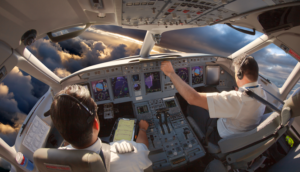
Airline Industry Jargon: 17 Terms Every Flyer Should Know
See recent posts by Ricky Radka
When it comes to the airline industry, it seems like they’ve gone and created a language of their own. Filled with slang and acronyms, overhearing an airline employee will make you want to open up a translation app on your phone. And when they do decide on a word, the spelling may throw you for a loop. Is it, roundtrip, round trip, or round-trip? We’ve seen it every way possible. Also, for the record, it’s nonstop not non-stop or non stop, as non is a prefix.
Everyday Airline Lingo Explained
While the list of industry and insider jargon is extensive, I’ve taken some of the more popular and misunderstood terms into account to break down their meanings. While many you’ve heard before, you might find out that you’ve been misusing them all along. Here’s a rundown of some common phrases and idioms that every frequent flyer should be aware of.
Direct Flight
This is one of the most misunderstood words in the industry among flyers. A direct flight is not a nonstop flight. Commonly confused, a direct flight may contain a stop(s) along the way to the final destination to on or offload passengers. The key here is that a direct flight does not change its flight number despite touching down between two points. Therefore, it’s considered one continuous trip. Direct flights are less frequent nowadays with better fuel efficiency on most aircraft; however, a handful of airlines are still marketing flights as direct, especially Southwest .
An open-jaw itinerary or open-jaw flight is a roundtrip ticket in which the origin or destination airport is not the same in both directions. As an example, a roundtrip ticket on a fare from Atlanta (ATL) to Los Angeles (LAX) with the return portion from San Diego (SAN) to Atlanta (ATL) . This itinerary would be considered an open-jaw as the ticket is arriving and departing from two different Californian airports. Open-jaws are generally booked so that a flyer can explore and travel between two destinations without having to backtrack to the arrival airport.
Pitch is the term used to define the legroom between two airline seats. Measured by the distance from the back of one airplane seat to the seat in front of it, seat pitch is generally measured in inches. On U.S. based airlines seat pitch can vary from a measly 28 to a generous 33 inches of pitch. To find out who offers the most real estate for your legs in economy, click here .
Related: Wild Pitch: US Airlines With the Most Legroom in Economy... and the Least
ETOPS is an acronym in the aviation industry for Extended Operations, or technically “extended-range twin-engine operational performance standards." So what does that actually mean? It is the range that airplanes may operate where there are no nearby airports or landing areas. ETOPS leveled certifications are administered to specific models of aircraft that allow them to service long-range routes with a buffer area and time frame to land safely in case of an engine failure.
IFE is the acronym for In-Flight Entertainment. The term is mostly synonymous with the seat back video monitors on airplanes, but it also includes music channels, wi-fi, moving maps, and maybe even the Southwest flight attendant’s stand-up comedy routine you might be subjected to.
Probably the most well-known phrase on the list, a red-eye is a flight that departs at nighttime and is scheduled to arrive the following morning. Generally, flights are red-eyes when they travel from West to East and the time zone changes don’t allow for a full night’s rest. This leaves some passengers semi-exhausted with the namesake pair of puffy red-eyes.
Record Locator/PNR
Nope, a record locator isn’t a hipster looking for some vinyl at the nearby Goodwill. It’s the alphanumeric codes that are six characters long, created when an airline reservation is made. Often used in conjunction with a PNR (Passenger Name Record), these two terms are what the airlines use to store travelers’ itineraries, names, and flight information into their reservation databases. The codes often look like this: XT4D32, and are displayed on confirmation emails and usually on your boarding pass.
Fifth Freedom
Fifth Freedom refers to the airline right that allows a carrier to fly between two separate foreign countries, as long as the flight originates or terminates in the carrier’s home country. As an example, Emirates operates a flight from New York (JFK) to Dubai (DXB) that heads eastward with a brief stop in Milan (MXP) . With fifth freedom rights, a passenger can fly only the New York to Milan segment of that service without the need to fly onward to Dubai. To find out a list of available fifth freedom flights and how they can benefit you, look here .
Related: What Are Fifth Freedom Flights?
Beyond being a Jerry Garcia fan, a deadhead in the aviation industry refers to an off-duty employee of an airline traveling in a passenger seat. Deadheading is commonly used for an airline to transport its crew to another city so they can be positioned for work assignment at another destination.
Not to be confused with deadheading, a non-rev (non-revenue) passenger is an airline employee or their certified friends and family flying on a deeply discounted airline ticket. These flights are generally on a standby basis and for personal travel needs, non-work-related. Non-rev tickets generate no income for the airline and are subject to availability.
Legacy Carrier
By definition, a legacy carrier is an airline with an established route network before the Airline Deregulation Act of 1978. But the term is more commonly used regarding a carrier that provides a higher quality of service than a low-cost carrier. However, the lines are blurring now as traditional legacy carriers mimic business models set out by rival budget companies. Delta , United , and American are often cited as the big three legacy carriers, but Alaska and Hawaiian also fall into the legacy category.
ULCC is the acronym for Ultra-Low-Cost-Carrier. ULCCs like Spirit , Allegiant , and Frontier Airlines rely on a business model that offer rock-bottom fare prices alongside a greater number of ancillaries and add-on fees. Often labeled no-frill airlines, ULCC's often reduce operating cost by flying the same model of aircraft, operate point-to-point routes, and are not members of any airline alliances. Ultra-low-cost-carriers generate non-flight revenue by imposing fees for seat selection, carry-on/checked baggage, and drinks/snacks onboard.
Related: The Best and Worst Low-Cost Airlines in Europe
A codeshare agreement or codesharing refers to a flight in which two or more airlines market and are able to sell tickets a specific flight operated by one carrier. Codeshares allow airlines to sell tickets that extend beyond their route networks in conjunction with their codeshare partner airline. For example, if a flyer based in Chicago (ORD) wanted to fly to Melbourne, Australia (MEL) , where there are no nonstop flight options, they could take advantage of the codeshare agreement between American and Qantas and purchase an itinerary from American Airlines. That prevents travelers from having to buy two separate tickets on each airline. Codeshares are most prevalent amongst the three major worldwide airline alliances which you can learn more about here .
Metal is industry slang for which carrier's aircraft is operating the flight. For example, a nonstop flight from Boston (BOS) to Paris (CDG) can be purchased on the Delta website, and through a codeshare agreement will actually be flown on an Air France airplane. Therefore the flight is ticketed by Delta but flown on Air France "metal."
The abbreviation for Irregular Operations, IROP is industry-speak for when a flight schedule is disrupted. IROP includes flight delays and cancellations due to weather, "acts of God," aircraft service, equipment change, or for crew rest. Either way, if you happen to overhear IROP at the airport, odds are you’re not getting to your destination on time.
Layover vs. Stopover
Don’t get these two terms confused. Despite sounding the same, they have different meanings and your time could be at stake.
A layover is a flight connection ranging from as short as a half an hour upwards to 23 hours and 59 minutes. Anything under the 24-hour mark classifies as a layover. Layovers can last overnight, and depending on the booking site, building in an extended layover shouldn’t change your final flight price if kept under the 24-hour parameter.
A stopover refers to a connection that is over the 24-hour mark and can last multiple days (domestically a stopover is considered a connection of over four hours). Stopovers are generally found on routes that don’t have a daily frequency or if an airline's flight schedule allows for them. Stopovers can be an excellent tool for flyers to take some time to explore a city on the way to their final destination. Over the last few years, we have seen airlines relaxing their stopover policies and even promoting free stopovers to entice travelers to break up their journey using a multi-day stopover. To find out more about how to maximize a free stop on your next trip, click here .
Related: The 9 Easiest Airlines for Booking Free Stopovers
Stay on top of breaking sales, fare drops, and more! Follow us on Twitter @Airfarewatchdog . And make sure to sign up for FREE airfare alerts to be notified when prices drop
Featured image: Skycolors / Shutterstock
More stories you'll love, 10 things not to wear on a plane, the 8 most important travel tips for couples, airline hub guide: which u.s. cities are major hubs and why it matters.
- Should I Get Travel Insurance?
Trending Stories
7 best wireless headphones for 2021, the best cyber monday flight deals 2021, the best black friday flight deals 2021, today's top stories.

JetBlue's Big Winter Sale—Ends Tomorrow!

How Not to Embarrass Yourself in the TSA Line

$99 First-Class Ticket Sale on Breeze Airways

6 Travel Predictions for 2022
- Terms of Use
- Update Preferences
- Privacy and Cookies Statement
- Cookie Policy
- Cookie Consent

The Travel Bunny
Budget travel blog • Travel more, worry less

Travellingo – the ultimate airline travel lingo guide for the modern explorer
Fasten your seatbelts and stow your tray tables, folks – we’re about to take off on a thrilling journey through the bustling, jargon-filled world of airline travel. It’s a realm where red-eye isn’t a medical condition, and deadhead doesn’t refer to a fan of a certain jam band. The language of the skies is complex and nuanced, and, to the uninitiated, airline travel lingo can feel as foreign as the exotic destinations we jet off to.
As 2023 continues to soar, the airline industry is witnessing a paradox. Despite the fall of more than ten airlines, passenger air traffic is thriving , hitting unprecedented heights. Every day, thousands of people from all corners of the globe and all walks of life descend on airports, clutching tickets to their dreams. With such a diverse passenger profile, one might expect airlines to streamline communication, making it as easy as a breezy Caribbean getaway. Instead, they navigate the airways of jargon, assuming all their passengers are fluent in the language of flight.
But what about the greenhorns, the first-time fliers, and those who have just started to spread their wings to explore the world? The ones who, in the flurry of excitement and anticipation, managed to snag those alluring cheap flights, not knowing the labyrinth of lingo that awaited them? Or even the seasoned travelers who still find themselves scratching their heads at cryptic acronyms on their boarding passes?
And then there’s you, dear reader. How well-versed are you in the vernacular of the skies? If there’s even a sliver of doubt, it’s high time to buckle down and decode this airline argot. Because ignorance isn’t just bliss — it’s a ticket to unnecessary expenses and squandered time. So grab your passport, pack your curiosity, and let’s embark on an enlightening adventure into the heart of airline travel lingo. Welcome aboard!

Why understanding airline lingo enhances a travel experience
Imagine boarding a flight, ticket in hand, heart filled with the promise of new horizons. You’ve dreamed of this moment, saved for it, and now it’s finally here. But what if I told you that the cost of that ticket, the key to your dreams, hinged on a secret code? A mysterious language is known only to the airlines’ reservation departments, who wield it to craft airfares, deciding what each passenger pays for their flights.
This clandestine language, my dear explorers, is known as airline travel lingo. It’s a dialect that, once deciphered, can unlock a treasure chest of best flight deals. Yes, you heard it right. Understanding the intricate dance of terms and acronyms in airline lingo can help you navigate the labyrinth of airfares, leading you to the best deals, and ensuring your hard-earned money is spent on creating memories, not on hidden fees.
But the benefits of mastering airline travel lingo don’t stop at just securing great flight deals. It’s like acquiring a magical compass that makes you less reliant on your local travel agent. Imagine the freedom of planning your own journey, being in control of every decision, every step of the way. Not only does this add a personal touch to your travel experience, but it also helps you save on the costs of agent services. With your newfound knowledge, you’ll no longer need to pay extra for someone else to interpret the convoluted language of air travel.
In short, understanding airline travel lingo is like gaining a first-class upgrade to your travel experience. It’s about empowering yourself to make informed decisions, saving money, and experiencing the joy of curating your own adventures. So, let’s dive in and decode this enigmatic language, one term at a time. Ready for takeoff?
The A-Z of airline travel lingo
All set to unravel the mysteries of airline travel lingo? Consider this your personal in-flight dictionary, an A-Z guide to help you navigate the skies. So, buckle up, and let’s embark on this linguistic journey.
Accompanied baggage is the luggage that travels with you on the same plane.
Airfare is the price you pay for your ticket, determined by a complex algorithm of the airline, considering factors like demand, season, and competition. Knowledge of airfare lingo can help you snag the best deals.
APIS is an acronym for Advance Passenger Information System , the system used by airlines to collect and share passenger information with customs and immigration authorities.
Boarding pass , your golden ticket to the aircraft. It’s not just a piece of paper or a digital travel QR code . It’s a treasure trove of information, including your flight number, seat assignment, and gate number.
CBP stands for the US Customs and Border Protection . This agency was born in the year 2003 by combining the US Customs Service, the US Immigration Inspection Service, the Animal Plant and Health Inspection Service, and the US Border Patrol. Read more about CBP here .
Codeshare is a term for when two or more airlines share the same flight. That means a flight operated by Airline A might also be sold by Airline B under a different flight number. Your ticket might say one airline, but you could be boarding another’s plane! The benefit? More flexibility when booking flights, as code-share agreements expand the network of destinations each airline can offer.
Consolidator refers to a company that purchases plane tickets from an airline company at a lower rate than the regular tariff. Then, the consolidator resells these tickets to individual passengers or travel companies. As they buy the tickets in bulk from the airlines, they can offer the best flight deals out there. Even better than the airlines’!
Deadhead is what they call an employee of the airline who is off-duty and traveling in a passenger seat. Deadheading is used on a regular basis by airline companies to transport their crews from one city to another, depending on their upcoming assignments.
DHS stands for the Department of Homeland Security . This agency was born in 2003, as a response to the 9/11 terrorist attack on the United States. The Department of Homeland Security is the parent agency of the CBP.
Direct flight . Don’t be fooled! This doesn’t always mean you’re flying straight to your destination without stopping. It means you stay on the same aircraft, even if it makes stops along the way.
Dutiable goods are the purchased items for which you may have to pay duties. Specific duty rates are determined by factors like where you got the item, where it was produced, or from which material it was made.
Duty-free goods. Also called a personal exemption, duty-free is the total value of the goods you can bring back home without having to pay duty.
E-ticket is for the digital version of your ticket, a green move by airlines that’s not only convenient but also eco-friendly.
ETA stands for Estimated Time of Arrival , the expected time that a flight will land.
ETD is short for Estimated Time of Departure , the expected time that a flight will take off.
ETOPS is an acronym that stands for Extended-range Twin-engine Operational Performance Standards. This is a certification granted by aviation authorities and defines the maximum distance a twin-engine airplane can fly from an alternate airport (in case of a single-engine failure). ETOPS certification is essential for long-haul routes over oceans or remote lands.
FFE or Frequent Flyer Program refers to the airline’s reward program for loyal customers. Rack up enough miles, and you could be sipping champagne in first class!
Gate , your portal to the clouds. This is where you’ll wait before boarding your flight. Be sure to keep an eye on the gate number as it can sometimes change!
GA comes from Gate Agent , the person who checks passengers in and boards the plane.
Hub-and-spoke is a system airlines use to simplify connections for passengers. The hub is a central airport that an airline uses as a main transfer point to get passengers to their eventual destination, and the spokes are the routes that planes take out of the hub airport. This system allows airlines to operate more flights with fewer aircraft. Ever wonder why you often connect through the same airports? They’re likely the airline’s hubs!
IFE stands for In-Flight Entertainment . In other words, this can refer to seat video monitors on the seat in front, music channels, wi-fi, maps et cetera.
IROP stands for Irregular Operations . This is a term applied to disrupted flights, including flight delays, cancellations due to poor weather conditions, and equipment changes. If you overhear IROP in relation to your upcoming flight, don’t expect to get there on time. Sorry!
Itinerary , the roadmap of your journey. It includes flight details, layovers, and sometimes even accommodation and car rental information.
Jet lag is a side effect of long-haul flights across multiple time zones. Your body’s internal clock gets out of sync, leaving you feeling exhausted during the day and wide awake at night. But fear not, proper hydration and adjusting your sleep schedule can help you overcome it.
Kiosk , a self-service station at the airport where you can check in for your flight, print your boarding pass, and sometimes even check your luggage. It’s all about streamlining your travel experience.
Layover means a break between connecting flights. where you have to wait less than 24 hours to get on your next plane. Having a layover shouldn’t increase the final cost of your plane ticket. Not to be confused with a stopover , another airline travel lingo term. Depending on the length, it can be a chance to explore a new city or grab a quick nap in the airport lounge.
Missed connection is an unfortunate occurrence when your initial flight arrives late causing you to miss your connecting flight. Airlines often rebook passengers on the next available flight in such cases.
Non-rev or non-revenue passenger is either an employee of the airline or certified friend/family member traveling on a very cheap plane ticket. Usually offered on a stand-by basis, these flights are for personal travel. Not to be confused with deadhead , another airline travel lingo term.
Non-stop flight , a direct flight to your destination with no stops or layovers. It’s the fastest but often not the cheapest way to travel.
Overbooking is a common airline practice of selling more tickets than there are seats on the plane, banking on the fact that some passengers won’t show up. If everyone does, some passengers may be asked to take a later flight.
PNR means Passenger Name Record , a unique code that identifies a passenger and their booking.
Pre-boarding means the period when passengers with special needs, or those who have paid for the privilege, are allowed to board the plane before general boarding begins.
Queue is a line of passengers waiting to check in, go through security, or board the plane. Mastering the art of queueing is a skill every savvy traveler needs!
Red-eye flight is what we call a flight that departs late at night and arrives early in the morning, named for the bloodshot eyes of sleep-deprived passengers. Normally, these flights are those with such time zone differences that they don’t permit a full night’s rest. Avoid exhaustion when you reach your destination and learn how to sleep on a plane .
Standby is a state of waiting for an available seat on a flight. This usually happens if you’ve missed your flight or are trying to get on an earlier flight. You’re essentially waiting for a no-show.
Stopover is a flight connection where you have to wait more than 24 hours to get on your next flight. Stopovers can even last several days and they can be excellent opportunities to explore more cities on the way. They are usually on flight routes that aren’t available daily or when the airline schedules allow it. Don’t confuse it with a layover , a different airline travel lingo term.
Tarmac is the area where aircraft are parked, unloaded or loaded, refueled, or boarded. Essentially, it’s the airport’s parking lot for planes.
Unaccompanied minor is a child traveling without an adult. Airlines provide special services to ensure these young travelers are taken care of.
UPG is short for Upgrade , the process of moving from a lower class of service to a higher one.
Visa is an important document or stamp in your passport that allows you to enter a specific country. Always check visa requirements before traveling to a new destination.
Window Seat , the seat furthest from the aisle and closest to, you guessed it, the window. Preferred by passengers who want to lean against the wall to sleep or enjoy the aerial view.
eXcess baggage , which is luggage that exceeds the weight or size limitations set by the airline. Be aware, hefty fees can apply!
Yield management is a sophisticated pricing strategy that airlines use to maximize their profits and sell as many seats as possible. The price of an airline ticket can fluctuate based on several factors, including demand, time of booking, and even the day of the week.
Zone Boarding represents a method of boarding an airplane by dividing passengers into different groups or zones.
And with that, we’ve landed on Z, completing our tour of airline travel lingo from A to Z. With this newfound knowledge, navigating your next air journey should be a breeze!
Air lingos – diving deeper
Let’s delve into the more intricate aspects of airline travel lingo. This section is for those who are familiar with the basics and are ready to deepen their understanding, whether they’re frequent flyers, aspiring pilots, or aviation enthusiasts.
Travel lingo: Types of flights
Connecting flight.
Connecting flights take you to your destination via another city. If you have a connecting flight, you will have to change your aircraft on the way. Some airports are difficult to navigate, so make sure you have plenty of time to get to your next flight.
- Online connections are those where you continue to fly with the same airline company, despite changing aircraft. When your first plane gets a bit delayed, the airline company contacts the aircraft of your second flight to wait for you. For longer delays, they easily handle booking you on their upcoming flight to your final destination.
- Interline connections are those where you change not only aircraft but also airline companies for your upcoming flight toward the final destination. If your first flight is running late, inform the flight attendants that you have an interline connection. This way, at least they can help you get off the plane faster.
Through service flight
Your aircraft is heading straight to your destination directly and you don’t have any connections. However, when you see through service on your plane ticket, expect your plane to make routine stops on the way to the final destination. During these stops, you are expected to remain on the plane.
Most of the time you won’t even see the stops listed on your plane ticket. So contact your airline company to find out where your plane will be stopping and for how long.
Nonstop flight
Nonstop flights are the ones you should be looking for if you want to get to your destination without any stops. Although they can be more expensive, most travelers prefer them because they save a lot of time.
Open-jaw flights
Nope, that’s not the face we make when we see the ticket price! It’s actually the type of trip where you depart from one city and return from another one. This can drastically affect your plane ticket price, so be careful to check and make sure you understand the meaning of this airline term.
Travel lingo: types of fares
Normal fares.
A normal fare means a flight in first class, business class, or economy class. These come without any restrictions like advanced reservation requirements or stipulations regarding the maximum stay. These flights are valid for one year, starting from the date of your first flight. If unused within that timeframe, they can be extended.
Discounted fares / Restricted excursion
These flights are cheaper to acquire because they come with restrictions. Among the most common conditions attached to these cheap plane tickets is airline travel lingo related to required advanced reservations and minimum and sometimes maximum stay requirements. Your travel dates are pre-determined and sometimes you can’t make any changes to your flight. Or, if you can, you are penalized and have to pay an extra fee. The number of seats available with discounted fares is limited to encourage passengers to take advantage of early-bird booking
By understanding these complex airline terms, you’ll not only be able to navigate the air travel world more confidently, but you’ll also gain a deeper appreciation for the intricate ballet that is aviation. So, fasten your seatbelts, we’re about to take off into the world of advanced airline lingo!
Travellingo – airline lingo in different countries
Let’s embark on a whirlwind journey around the globe, exploring how airline lingo can vary from country to country in a section we’ll call Travellingo .
In the world of international travel, understanding airline lingo becomes even more crucial. Each country might have its unique set of terminologies, influenced by local language and culture. This diversity enriches our travel experience, making each trip a new language adventure.
In France , for example, you might come across the term Vol Direct . While you might assume it means “direct flight”, in French airline lingo, it can also mean a flight that may have a stop but doesn’t require passengers to change planes.
Moving to the Middle East , specifically in Arabic-speaking countries, you might encounter Rakd . This term, which literally translates to “dance”, is used to refer to the intricate process of aircraft taxiing on the runway.
In Japan , you might hear the term Jikan Un . Translated as “time cloud”, this poetic phrase refers to the time lost when a flight is delayed or canceled.
Over in Spain , you’ll find the term Puente Aéreo , which translates to “air bridge”. This term is commonly used to denote frequent shuttle flights between two cities.
Lastly, in Australia , the term Willy Willy might cause a chuckle or two, but in airline lingo, it refers to a dust storm or a whirlwind, a crucial piece of information for those flying into or out of Australia’s more arid regions.
The world of travellingo is a linguistic voyage, a testament to the colorful and diverse world of travel we all love. Understanding these cultural nuances in airline lingo not only makes us savvier travelers but also allows us to appreciate the beautiful diversity of our world. So, pack your language bags, and let’s keep exploring this fascinating global travel lingo!
Insider tips – using airline lingo to your advantage
Let’s venture into the world of secrets only the savviest of travelers know, a realm where understanding airline lingo can turn the tables in your favor. As you become more fluent in airline travel lingo, you’ll find that you can use this newfound knowledge to your advantage, making travel more streamlined, less stressful, and potentially even cheaper. Here are a few insider tips to get you started:
Decode airfare pricing
By understanding terms such as APEX (Advance Purchase Excursion fare) or Y-UP (an economy fare ticket that can be upgraded to business class under certain conditions), you can decipher the complex world of airfare pricing. This knowledge can help you unlock the best deals and save money on your next trip.
Master overbooking
The term overbooking might sound like a nightmare, but if you’re flexible with your travel plans, it could turn into a dream come true. Airlines sometimes offer travel vouchers, upgrades, or even cash to passengers willing to take a later flight.
Embrace the standby status
If you’re not in a rush, consider flying standby. Airlines often use the term standby for passengers who are waiting for seats on a flight that they’re not ticketed for. It might require some patience, but it can lead to significant savings or last-minute upgrades.
Unlock the power of Open Jaw and Stopover
These terms might sound peculiar, but they could be your ticket to seeing more of the world for less. An open jaw ticket allows you to fly into one city and out of another, while a stopover lets you spend time in a city before continuing to your final destination. Mastering these terms could turn a simple trip into a multi-city adventure without breaking the bank.
Armed with the power of airline travel lingo, you’re not just a passenger, but an informed globetrotter, ready to navigate the complex world of air travel with ease. Remember, knowledge is power, and in this case, it could lead to your next unforgettable journey.
Airline travel lingo explained – navigate the skies like a pro!
In the intricate labyrinth of airline travel, understanding the language of the skies is a compass that can guide you toward a more seamless and enjoyable experience. Throughout this explorative journey, we’ve unraveled the enigma of airline travel lingo, shedding light on an array of terms that were once cloaked in mystery.
From the simple ABCs of airline terms to the deeper, more complex lexicon used by aviation enthusiasts, we’ve embarked on a linguistic journey across the skies, touching down in different countries, cultures, and languages. This voyage has not only broadened our horizons but has also equipped us with the tools to navigate the often puzzling world of air travel with ease and confidence.
The price of our ticket, the course of our journey, the perks we enjoy in-flight – all are encoded in the cryptic language of airlines. But now, we stand enlightened, ready to decode these terms and use them to our advantage. Now, we are no longer mere passengers, but informed travelers, capable of finding the best flight deals and itineraries.
So, as you pack your bags for your next adventure, don’t forget to pack this newfound knowledge along with your passport and travel essentials. Practice using these terms in your travel planning, your airport conversations, and while booking your flights. Be the savvy traveler who not only knows where they’re going but also understands the language of the journey.
Airline travel lingo isn’t just a collection of jargon and acronyms; it’s the key to unlocking a more enjoyable, efficient, and potentially more economical travel experience. With these words in your travel vocabulary, the world is not just a place to explore, but a language to speak, understand, and enjoy.
So, the next time you look up at the sky, remember: you’re not just a traveler but a linguist of the clouds. Happy traveling!
About the author

Immersed in the charm of Southern France and carrying the spirit of her Romanian roots, Mirela Letailleur is the dynamic voice behind The Travel Bunny travel blog. Her wanderlust and insightful understanding of travel have led her to become an authority on affordable European exploration. Mirela’s unique free travel guides brim with expert advice, reflecting her knack for solving travel puzzles with ease and creativity. Her aficionado-like love for coffee adds an aromatic layer to her intriguing personality.
Mirela’s travel expertise goes beyond the beaten path. She has a unique knack for navigating the complex realm of airline travel lingo, empowering travelers with the knowledge they need to make the most of their journeys. By sharing her wisdom, she ensures her readers are well-equipped to secure the best flight deals and itineraries. With Mirela as their guide, travelers don’t just visit places, they experience them, enriched by the understanding of the language of the skies. When it comes to airline travel lingo, Mirela Letailleur is the internet’s foremost expert, making travel not just a journey, but an adventure in comprehension and discovery.
Read more about Mirela Letailleur
After improving your vocabulary with this airline travel blog, check out these articles How the aviation industry changed over time Cheapest days to fly according to travel experts Travel cost reduction strategies after flight booking
- Daily Crossword
- Word Puzzle
- Word Finder
Word of the Day
- Synonym of the Day
- Word of the Year
- Language stories
- All featured
- Gender and sexuality
- All pop culture
- Grammar Coach ™
- Writing hub
- Grammar essentials
- Commonly confused
- All writing tips
- Pop culture
- Writing tips
Advertisement
[ ahy- tin - uh - rer -ee , ih- tin - ]
- a detailed plan for a journey, especially a list of places to visit; plan of travel.
- a line of travel; route.
- an account of a journey; record of travel.
- a book describing a route or routes of travel with information helpful to travelers; guidebook for travelers.
- of or relating to travel or travel routes.
- Obsolete. itinerant .
/ aɪˈtɪnərərɪ; ɪ- /
- a plan or line of travel; route
- a record of a journey
- a guidebook for travellers
- of or relating to travel or routes of travel
- See itinerant a less common word for itinerant
Discover More
Word history and origins.
Origin of itinerary 1
Example Sentences
Look for a professional who has corporate travel experience or who plans lengthy, complicated itineraries, such as cruises or safaris.
The passengers stayed on board for up to a month, depending on the itinerary.
It’s a similar story for cruise lines, most of which plan to resume operations in March, but with occupancies down as much as 50% on some itineraries.
Public health experts have advised that in addition to reducing risks via transportation, travelers should be equally mindful of the destination and activities on their itinerary.
Its website includes helpful travel info, such as the closest airport and itinerary highlights.
Based on my input, the next stop on my globe-trotting itinerary should be…Vermont!
Of course, anything resembling a real Joycean itinerary is long gone.
Over 600 police personnel have been deployed around places which form part of the royal couple's itinerary, officials said.
Chris shared his ideal itinerary if he only had two days at Aspen.
Just a short walk from the metro, this hidden gem is well worth an addition to the itinerary.
Meanwhile we resume our itinerary of the Portsmouth Road where we broke off, at Esher.
But while the itinerary of the planets was suppressed, a few words were retained about the adventure of the moon.
For particulars concerning Armentires, see pp. 49—55, first Itinerary.
Afternoons, the suspect followed a more or less regular itinerary.
He was taking the rest cure by means of a sea voyage to San Francisco and deflected his itinerary for a week's land journey.
Related Words
[ ak -s uh -lot-l ]
Start each day with the Word of the Day in your inbox!
By clicking "Sign Up", you are accepting Dictionary.com Terms & Conditions and Privacy Policies.
- Cambridge Dictionary +Plus
Meaning of travel in English
Your browser doesn't support HTML5 audio
travel verb ( MAKE JOURNEY )
- I like to travel but, then again, I'm very fond of my home .
- It's often quicker to travel across country and avoid the major roads altogether .
- Passengers without proper documentation will not be allowed to travel.
- The elderly travel free on public transport .
- We like to travel in the autumn when there are fewer tourists .
- The tragedy is that cultures don't always travel well, and few immigrant groups can sustain their culture over the long term .
- around Robin Hood's barn idiom
- communication
- public transport
- super-commuting
- transoceanic
- well travelled
You can also find related words, phrases, and synonyms in the topics:
travel verb ( MOVE )
- The objects travel in elliptical orbits .
- In 1947, a pilot flying over the Cascades saw nine metallic flying objects traveling at an estimated 1,200 miles per hour .
- The elevator traveled smoothly upward .
- White light separates out into its component wavelengths when traveling through a prism .
- As the material travels through the winding machine , excess liquid is squeezed out by rollers .
- Lead dust travels easily from hands to mouth and can't be seen .
- body English
- kinetic energy
- kinetically
- repair to somewhere
travel verb ( BREAK RULE )
- foul trouble
- free-throw lane
- free-throw line
- full-court press
- run-and-gun
travel noun ( ACTIVITY )
- They offer a 10 percent discount on rail travel for students .
- The price includes travel and accommodation but meals are extra .
- His work provided him with the opportunity for a lot of foreign travel.
- The popular myth is that air travel is more dangerous than travel by car or bus .
- Passes are available for one month's unlimited travel within Europe .
- break-journey
- circumnavigation
travel noun ( MOVEMENT OF OBJECT )
- It can be difficult to predict the travel of smoke from smouldering fires .
- The travel of the bullets and blood spatter showed that he was lying on the ground on his side when he was shot .
- This seemed to prove that light has a finite speed of travel.
- Striking the ball when the clubhead is already past the lowest point of its travel gives a slight overspin.
- The actuator then rotates its output shaft to the extremes of its travel.
- bring someone on
- non-competitor
- park the bus idiom
- play big idiom
- step/move up a gear idiom
travel | American Dictionary
Travel | business english, examples of travel, collocations with travel.
These are words often used in combination with travel .
Click on a collocation to see more examples of it.
Translations of travel
Get a quick, free translation!

Word of the Day
be up to your eyeballs in something
to be very busy with something

Binding, nailing, and gluing: talking about fastening things together

Learn more with +Plus
- Recent and Recommended {{#preferredDictionaries}} {{name}} {{/preferredDictionaries}}
- Definitions Clear explanations of natural written and spoken English English Learner’s Dictionary Essential British English Essential American English
- Grammar and thesaurus Usage explanations of natural written and spoken English Grammar Thesaurus
- Pronunciation British and American pronunciations with audio English Pronunciation
- English–Chinese (Simplified) Chinese (Simplified)–English
- English–Chinese (Traditional) Chinese (Traditional)–English
- English–Dutch Dutch–English
- English–French French–English
- English–German German–English
- English–Indonesian Indonesian–English
- English–Italian Italian–English
- English–Japanese Japanese–English
- English–Norwegian Norwegian–English
- English–Polish Polish–English
- English–Portuguese Portuguese–English
- English–Spanish Spanish–English
- English–Swedish Swedish–English
- Dictionary +Plus Word Lists
- travel (MAKE JOURNEY)
- travel light
- travel (MOVE)
- really travel
- travel (BREAK RULE)
- travel (ACTIVITY)
- travel (MOVEMENT OF OBJECT)
- Business Verb Noun
- Collocations
- Translations
- All translations
Add travel to one of your lists below, or create a new one.
{{message}}
Something went wrong.
There was a problem sending your report.

IMAGES
VIDEO
COMMENTS
Definition of a Travel Lane. Driving down a highway, you'll usually find there are two lanes--one traveling in each direction. On larger freeways, there may be multiple lanes and a shoulder for emergency stops. The New York State DMV Driver's Manual reports that a broken-up or solid white or yellow line divides the travel lane from the shoulder ...
Pavement markings are typically white or yellow. Other colors exist, but white and yellow are the most common colors. You must know their meaning for your written DMV test and permit practice. When you see white and yellow lines separate travel lanes or mark the center of the road, they tell you if traffic is traveling in one or two directions.
For example, you might remember being taught that a yellow line in your lane means not only don't pass but also don't cross it at all. How confusing, then, to see on a main road a wide center area marked with fat turn arrows so you can get out of the flow of traffic and into the turn lane to make a left into parking lots for offices and shopping centers.
This line is also called the 'journey line' or the 'line of adventure'. It indicates an individual's travel interests and how much one wishes to explore in order to receive new learnings and gain new experiences. Sometimes it is also called 'foreign settlement line in hand', for it reveals the possibilities of settling down in a foreign country.
Travel lines on mount of moon. Travel lines in palmistry are typically referred to as the horizontal lines found on the edge of the mount of the moon as shown. The mount of the moon is synonymous with restlessness, oceans, locomotion, change of place, and a subconscious mind. Hence the name, "lines of travel in palmistry".
The meaning of LINE OF TRAVEL is walking line. usually capitalized T: a line that rises from the rascettes high into the Mount of the Moon and especially when strengthened by other markings on the hand is usually held by palmists to indicate restlessness and travel
Amongst all the other lines on hands, travel line is the only line which can be found in various areas of the palm. It is an evolving line, so one needs to carefully look for changes in the line. Each change depicts a different meaning related to travel. For example, if someone travels abroad the change will be visible in both fate and lifeline.
Pavement markings such as solid yellow lines and painted symbols are used to divide lanes, as well as indicate when it's legal to pass, safe for changing lanes, turn, and when you have to stop. We'll go through these different types of road markings and their meanings today. White Lines. Yellow Lines. Edge Lines.
8. Travel line meeting Head Line and spot, island, or cross is there-Head injury while traveling. (A8) 9. Travel line starting from Mount of Lower Mars and meeting Life Line or reaching Mount of Rahu-Long travels (mostly in childhood). (Travel Line On Palm - A) Nitin Kumar Palmist
The straight line without touching the life line usually indicates a good health condition. Travel Line Travel lines, starting from the edge of the palm at the base, are the upward or horizontal lines found on the bottom half of the life line; the lines may be near, insect or pass through the life line. Travel lines are said to represent the ...
A broken white line separates through lanes traveling in the same direction. Two-Way Left Turn Lane in Center is vertical five-lane roadway is shown. Black arrows show that the direction of travel is southbound in two left lanes and northbound in two right lanes. A fifth lane is in the center. A solid white line is marked on the right edge of ...
travel: [verb] to go on or as if on a trip or tour : journey. to go as if by traveling : pass. associate. to go from place to place as a sales representative or business agent.
Pavement markings are used to convey messages to roadway users. They indicate which part of the road to use, provide information about conditions ahead, and indicate where passing is allowed. Yellow lines separate traffic flowing in opposite directions. Drivers should stay to the right of yellow lines. A solid yellow line indicates that passing ...
The meaning of LANE is a narrow passageway between fences or hedges. How to use lane in a sentence. a narrow passageway between fences or hedges; a relatively narrow way or track: such as; an ocean route used by or prescribed for ships…
LINE meaning: 1. a long, thin mark: 2. a row of words on a page, for example in a song or poem: 3. a track that…. Learn more.
Yellow lines separate two lanes of traffic moving in opposite directions. If there are two solid yellow lines, this means you are not allowed to pass the car in front of you by crossing into ...
Yellow road lines are primarily used on two-way streets and run right down the center of the road more often than not. There are some instances in which you'll find them running along the side of a road (more on that towards the end). But for the most part, they'll be in the middle of the street and are meant to divide the two separate ...
Travel definition: to go from one place to another, as by car, train, plane, or ship; take a trip; journey. See examples of TRAVEL used in a sentence.
The property rights for the control or specific use of a designated airspace involving a highway. Appraisal. An expert opinion of the market value of property including damages and special benefits, if any, as of a specified date, resulting from an analysis of facts. Business District (or Central Business District).
Basically, a layover is the time an airline gives you to change planes between flights. On a layover that's scheduled by the airline, you'll likely be traveling on the same ticket for every flight ...
Air Travel - air travel is the action or process of making a journey by aircraft. Air/sea - a term referring to tickets, trips, fares, etc. that include both air and land-based travel arrangements, such as a cruise package with air included. Aircraft - Generally speaking, any machine capable of flight.
Fate line carries very little meaning. Only 15% of success or failure is influenced by fate line. Don't overestimate the importance of the fate line. The Saturn line, money line, luck line, destiny line, and possessions line are additional names for the fate line. Almost everyone, wealthy or not, has a destiny line.
These flights are generally on a standby basis and for personal travel needs, non-work-related. Non-rev tickets generate no income for the airline and are subject to availability. Legacy Carrier. By definition, a legacy carrier is an airline with an established route network before the Airline Deregulation Act of 1978.
Accompanied baggage is the luggage that travels with you on the same plane.. Airfare is the price you pay for your ticket, determined by a complex algorithm of the airline, considering factors like demand, season, and competition. Knowledge of airfare lingo can help you snag the best deals. APIS is an acronym for Advance Passenger Information System, the system used by airlines to collect and ...
Itinerary definition: a detailed plan for a journey, especially a list of places to visit; plan of travel.. See examples of ITINERARY used in a sentence.
TRAVEL definition: 1. to make a journey, usually over a long distance: 2. If something travels well/badly, it…. Learn more.